a good reference:
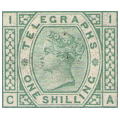
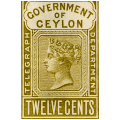
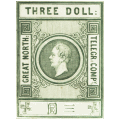

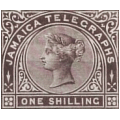
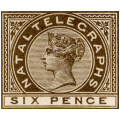
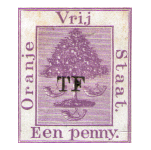
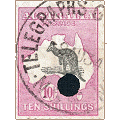
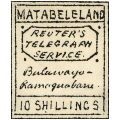
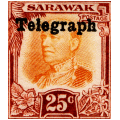
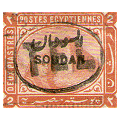
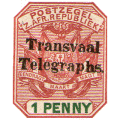
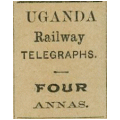
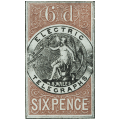
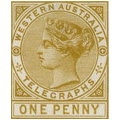
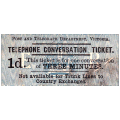
| Up a level | Not my site, but a good reference: |
||||||
 |
 |
 |
 |
 |
 |
 |
 |
| GB | Ceylon | Hong Kong | India | Jamaica | Natal | OFS | Australia and states |
| Up a level | by Dave Elsmore. | ||||||
 |
 |
 |
 |
 |
 |
 |
 |
| Other Africa | Sarawak | Sudan | Transvaal | Uganda | New South Wales | Western Australia | Other Australia |
I have revised Hiscocks' original listing, though leaving references to the original designations. I have brought the prices up to date and added currency selection. The new designations have 'RH' numbers (Revised Hiscocks) to avoid confusion. CheckList Setup |
| Shortcuts to different sections | |||||||||||
| 1860 issue | 1869 series | 1881/2 Prov. | 1882 series | 1890 series | 1899-1900 Prov. | Angeli Head | 1904 issue | 1904 Prov. | Service Telegraphs | Railways | Police Departments |
| Postal Service | Perfins. | Cancels | 1885 Expedition | "CanD" Perfins | After Telegraph Stamps | "STATIONERY | Used abroad | Jammu & Kashmir | J&K Officials | Patiala Telephone stamps |
Steve Hiscocks wrote:
|
The Indian Government Telegraph Department was established in 1851 and was originally completed independent of the Post Office. In the early 1850s telegrams were paid for in cash while from 1855 to 1859 stamped revenue papers are said to have been used as prepaid telegraph forms. The first adhesive stamps were ordered in 1856, received in Calcutta in June 1858, distributed in November 1859 and were apparently first put into use in early 1860. These first 'Electric Telegraph' stamps saw little use due to bad publicity, restrictions on use due to misunderstanding of the instructions, and the fact that they were only used where no Telegraph Office existed. Although the Electric Telegraph stamps were current for nine years the vast majority were eventually destroyed or overprinted for court fee use. In use they were not bisected, as were later issues, such that half remained in possession of the customer (although one or two are known to have been so used after 1869 when they were withdrawn but not demonetized) — the entire stamp was retained on the message form, cancelled by multiple punching, and subsequently officially destroyed. The first of the double head issues was received in Bombay in March 1867, distributed in June and August 1868 and officially entered service on 1 February 1869. Many, but not all, of the first printings were on paper of varying degrees of blueness. The use of bluish paper is not observed in printings after 1869 and is spasmodic before that so it cannot be regarded as a separate issue. The early papers seem to be slightly thinner. Various die changes occurred early on and are noted below. In 1882 (probably February) new and different sized plates were adopted to reduce printing costs. A new size of paper was required and this had a slightly different watermark. Various values on the earlier watermarked paper ran out while these were awaited and provisionals were issued in 1881 to fill the gaps. No die changes are normally recognised on second watermark paper but an exchange of correspondence between de la Rue and the India Stores Department in March and July 1886 suggests that the heads and backgrounds of the 2, 4 and 8 anna and the 1, 5 and 50 rupee dies were softened and re-cut "in the new and improved manner", and that the printings of these values in 1887 and thereafter would be from these new dies. Examination of specimens used before and well after 1887 has not so far shown any systematic differences but further work is required. The discovery or fear that 'new' telegraph stamps could be constructed by the less scrupulous from pairs of used top halves let to the introduction of new single head designs in 1890 and the analogous King Edward VII stamps were issued belatedly in 1904. Shortages of specific values led to the issue of provisionals in 1889 and, while the King Edward stamps were awaited, in 1904. Both ordinary postage stamps and those overprinted 'Postal Service' (a sort of 'tax due' stamp for incoming parcels) were used telegraphically at various times but were not differentiated for such use and are therefore not listed. Telegraph stamps were abolished on 1 April 1908 and postage stamps were used thereafter. The 10, 15 and 25 rupee postage stamps issued in 1909 were specifically intended to fill the gap left by the withdrawal of the high value telegraph stamps and most of the 15 and 25 rupee values were so used. They should perhaps be regarded as telegraph stamps. |
My notes:
A document said to record information from an earlier incarnation of the
Does anyone know what these differences are?
I have some information below on the Postal Service. The same may apply to the normal postage stamps.
Hiscocks constrained his scope to include only purely telegraphic stamps. The economies of publishing a book
required constraints, including limitations on images. Thankfully with the modern internet I can afford to use
more and better images as well as explore more fully the topic of telegraphy.
Telegraphy in India(PDF) was initiated by William Brooke O'Shaughnessy in 1839 when he erected a highly successful experimental line of 13 miles
near Calcutta.
At that time however there was little interest in developing it. In 1847 a new and more progressive Governor–
General, James Ramsay, Earl (later Marquis) of Dalhousie (1812–1860),
gave him permission to build a line from Calcutta. The first section of 30 miles was to Diamond Harbour, taking 3 months. That was then extended by a further 52 miles to the sea.
The success of the project allowed the Directors of the East India Company to be persuaded to finance an extension of the line from Calcutta to Agra, Delhi, Lahore and Simla
with a second line from Agra to Bombay and thence to Madras (3200 miles in total). At this point O’Shaughnessy was appointed Superintendent of Telegraphs in India.
An important auction by Stanley Gibbons was held 20 September 2021 of the INDICA Collection(PDF) if India Telegraphs.
A detailed map of the Telegraph lines in India, including Ceylon and Burma, was done in 1894 and is viewable at the (digital) Bodleian Library of Oxford.
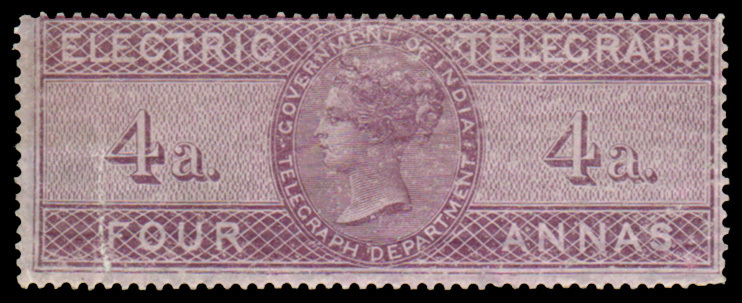 |
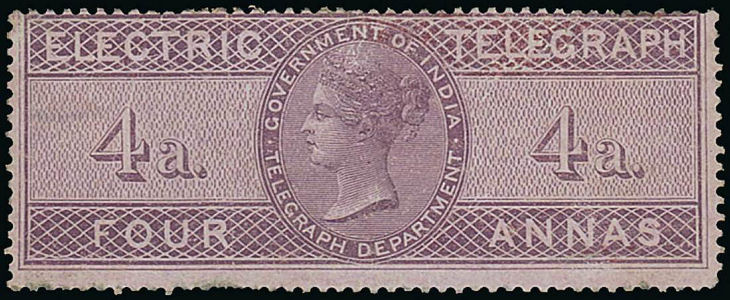 |
| H1 courtesy of www.stampbay.com | H1 Ex Andrew Higson, courtesy of Spink & Son. |
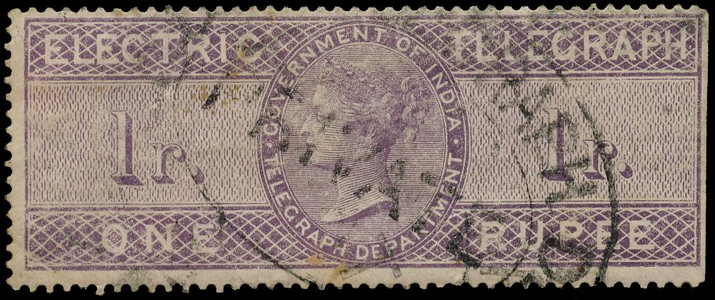 |
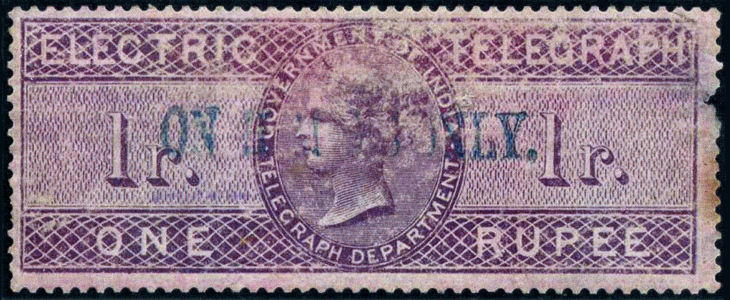 |
| H2 from lot 1 of the listing of the Taprobana Collection Auction, courtesy of Stanley Gibbons. | H2a from lot 17 of the listing of the Indica Collection Auction, courtesy of Stanley Gibbons. stamped "ON H M S S ONLY." (On His Majesty's Special Service Only) |
The oval cancel reads "CEYLON TELEGRAPH DEPARTMENT/PRIVATE". According to Stanley Gibbons "no example known used in India. The three recorded are all used in Ceylon".
On H2a, the Indica lot description quotes Hausburg et al on page 159 as stating "This appears to be of the same nature as the local surcharges
which preceded the official issue of service postage stamps."
There is one other known example in the Tapling collection at the British Library.

H3, 4Rp mint with selvedge, courtesy of Stanley Gibbons from lot 126 of their Revenue auction of 21 November 2023.
They say only four unused examples of the 4r recorded.
| RH # | Hisc. | Description | Mint | Used |
|---|---|---|---|---|
| RH1 | H1 | 4A reddish purple (12,000) | 1500.00 | 1000.00 |
| RH2 | H2 | 1R reddish purple (12,000) | 3000.00 | 1500.00 |
| RH2a | H2a | handstamped "ON HMSS ONLY" | - | - |
| RH3 | H3 | 4R reddish purple (500) | 30000.00 | 5000.00 |
Hiscocks added the following 4 notes:
| Note 1. No. 2(a) is thought to have been a local overprint rather than an official issue. |
| Note 2. Used stamps normally have a number of approximately 3mm holes punched in them. Three or four examples of left hand halves used after 1869 with those of the next issue are known. |
| Note 3. The numbers in brackets are those printed minus those overprinted for Court Fee payment and those destroyed assuming the same rates of usage in the Calcutta presidency, for which figures are not known, as in the Bombay and Madras presidencies where they are known. |
| Note 4. No. 2 in fact differs slightly from No. 1 in that it lacks the outer frame line round the design. |
An example of the 4 anna used, courtesy of Andrew Higson. The date is presumably in error and should have been 1861.
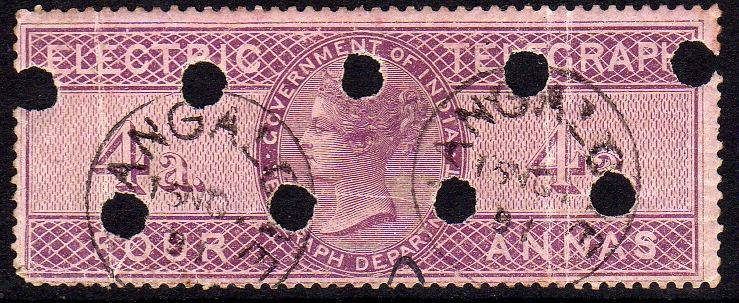
Remainders (the majority) of the 4a, 1r and 4r stamps were overprinted and used for Court Fees. Images courtesy of Andrew Higson.
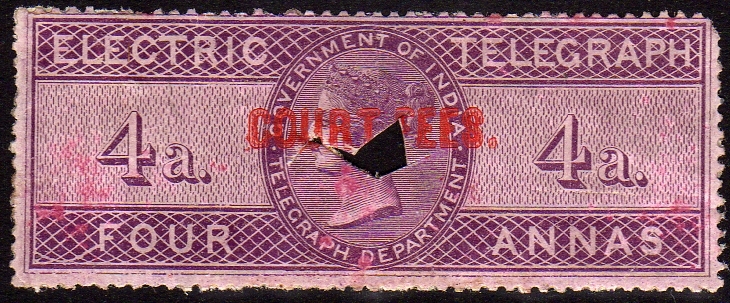
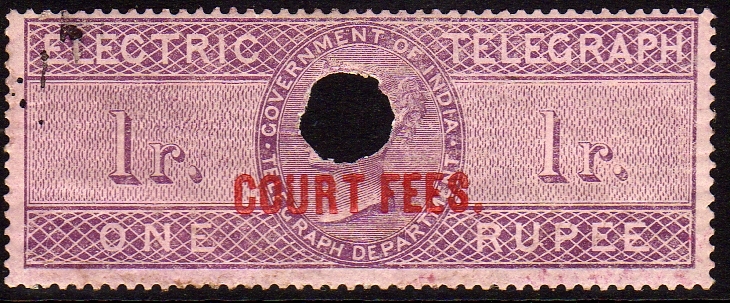
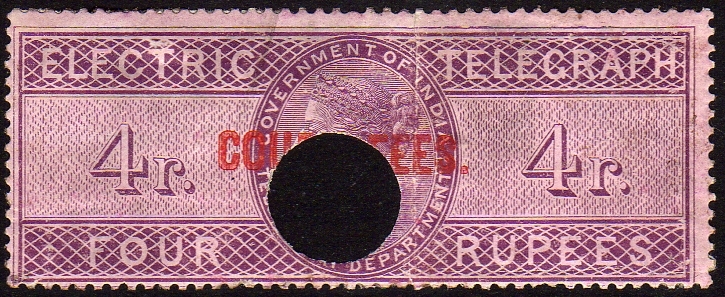
The way of cancelling them was very varied. They certainly could not be re-used.
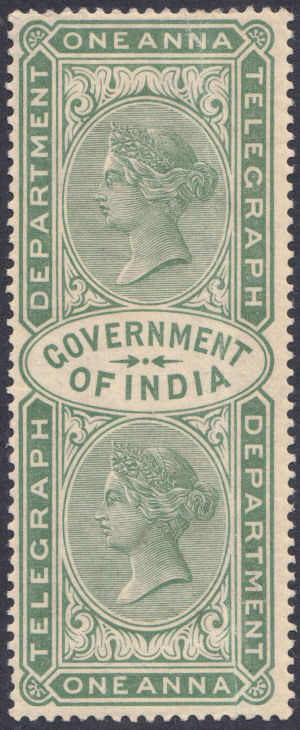 |
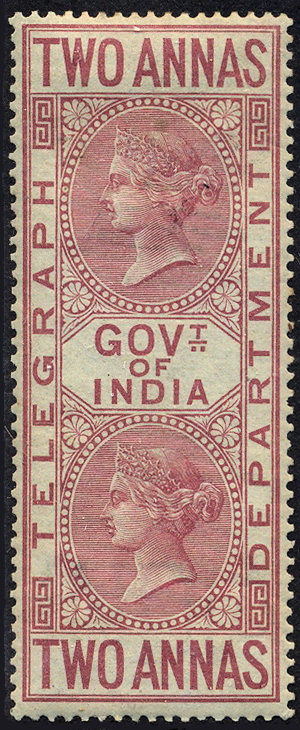 |
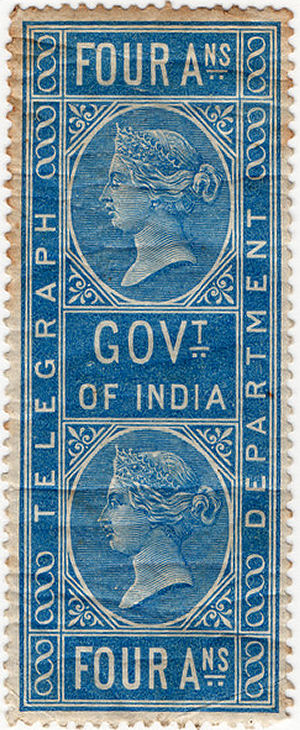 |
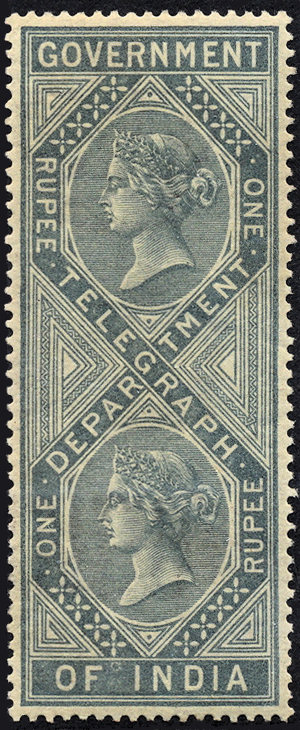 |
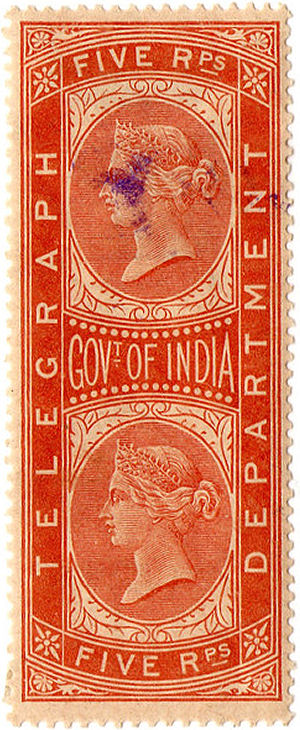 |
| 1 Ans. H4 | 2 Ans. H5 - courtesy of Rolf Lamprecht. | 4 Ans. H6 - courtesy of ibredguy.co.uk. | 1 R. H9 - courtesy of Rolf Lamprecht. | 5 R. H12 - courtesy of ibredguy.co.uk. |
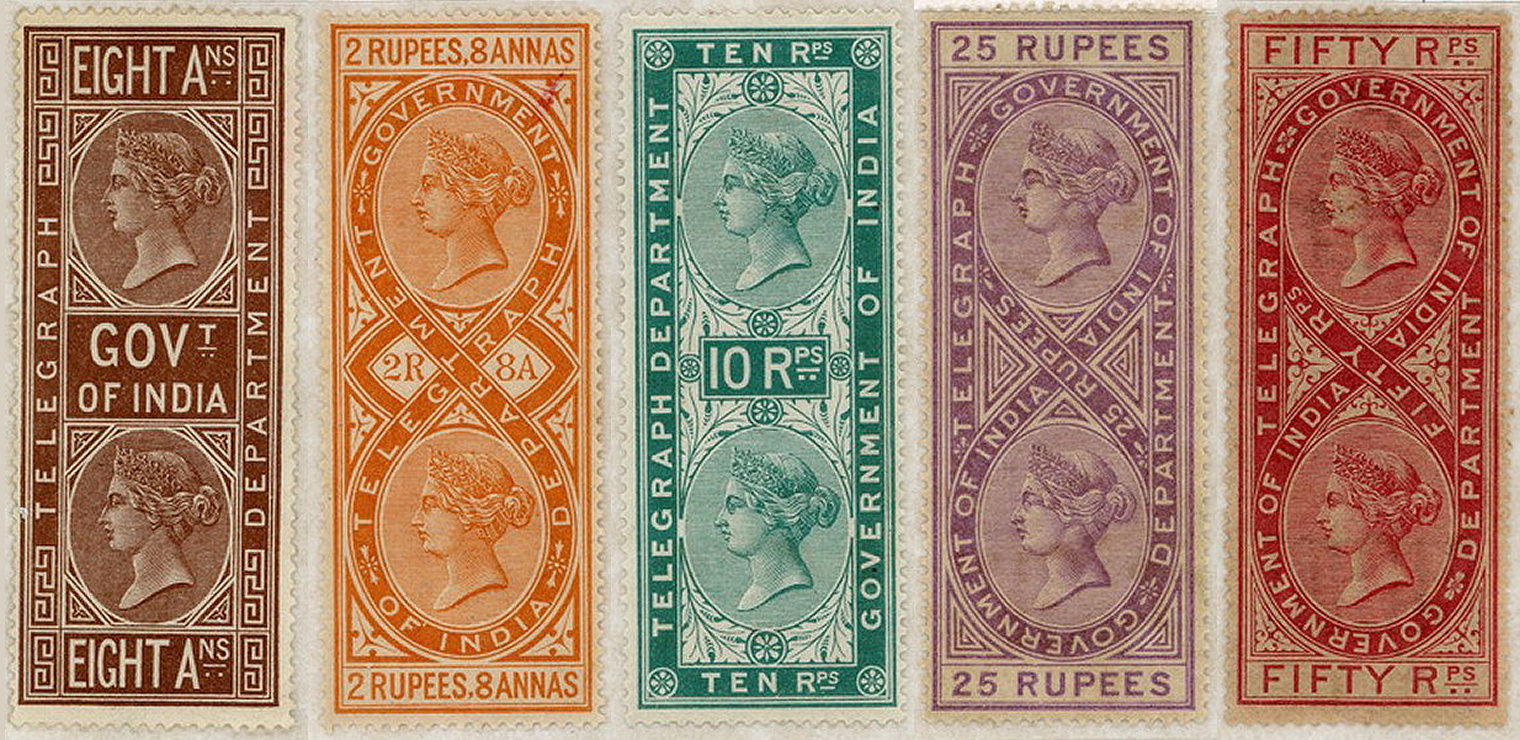 |
||||
| 8 Ans. H7 | 2R 8A. H11 | 10 R. H14 | 25 R. H17 | 50 R. H20 |
| Most of the rest of the set, courtesy of Dr Mark Gibson. | ||||
| Watermarked Crown over "INDIA". 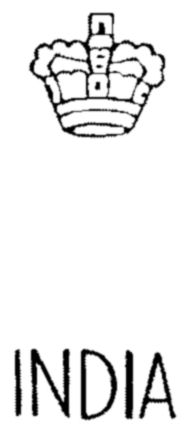 W1 |
|
For the 1R. and 50R, corner frames are solid or double-lined. For the 2R.8A. the lines of shading behind the head are thicker on Die I. This reduces the contrast. On Die II there is also shading, particularly at the back of the neck, and it is easier to see the boundary of the head. Also Die I is a very yellow shade whereas most Die II stamps are the later orange shade. For the 10R, Die-II letters and numbers are thicker and the head background lighter due to thinner lines. For the 25R, Die-II has the white ornaments shown, Die-I does not. |
|
||||||||||||||||||||||||||||||||||||||||||||||||||||||||||||||||||||||||||||||||||||||||||||||||||||||||||||||||||||||||||||||||||||||||||||||||||||||||||||||||||||||||||||||||||||||||||||||||||||||||||||||||||||||||||||||||
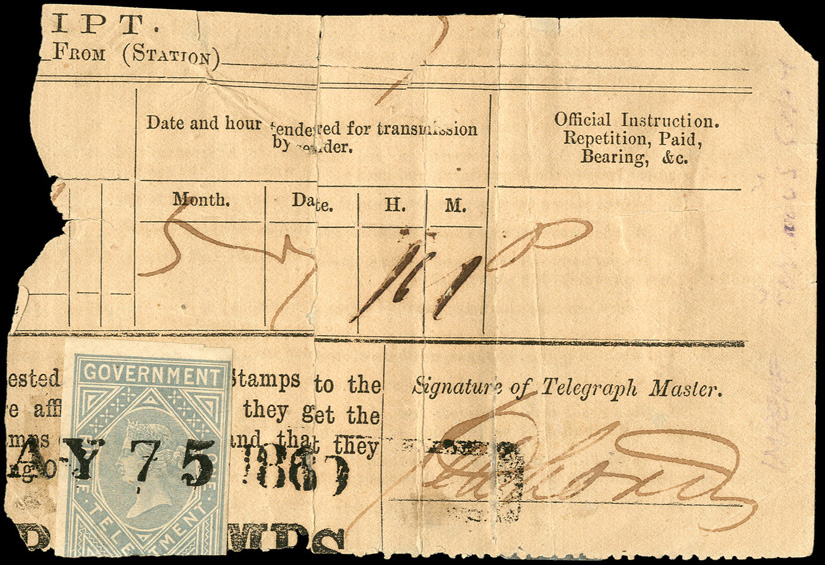
H8c on part of a receipt, cancelled with Bombay 7.5.1869 courtesy of Grosvenor Auctions.
Hiscocks added the following 5 notes:
| Note 1. Nos. 4-20 are listed above in value order with issue dates in brackets. The order of printing was 4A, 8A, 1R(Die I), 2½R(Die I), 5R, 10R(Die I), 25R(Die I), 50R(Die I), 1R(Die II), 2A, 14¼R, 28½R, 50R(Die II), 25R(Die II), 10R(Die II), 1A, 2½R(Die II). |
| Note 2. Used prices are for cancelled upper halves of stamps. Stamps were occasionally used upside down and lower halves are worth at least x 3. Most cancellations were in black — coloured cancellations (usually blue or red) command a premium of 50-100%. The Madras 'diamond' and the Pondicherry diamond cost x 3 and x 5 respectively. |
| Note 3. Nos. 'Specimen' and, more rarely, 'cancelled' sets are found. The former sell at about mint prices and the latter at a little more. |
| Note 4. The numbers quoted above are from de la Rue archives and are approximate after allowing for damaged sheets and those later overprinted for Court Fee use. |
| Note 5. Some stamps, e.g. No. 8, are much more rare than their printings would suggest and the reasons for this are not known. Prices reflect this. |
Unfortunately, Hiscocks said nothing about distinguishing the Dies.
He has some helpful arrowed diagrams for all but the 25R. value, but some words would have been useful.
I have tried to describe the differences better above.
These can be sorted by the height of the overprint:
2½mm - Type 26 (generally high)
2¾mm - Type 28 (generally central, no stop)
3mm - Type 27 (generally high) or Type 29 (generally central, no stop)
The images below are from various sources and have been re-sized to be, as near as I can get, to the same scale for overprint comparison.
The actual width of the overprints can be slightly variable since the typography was done by hand and spacing between letters may not have been consistent.
Warning, Forgeries about: I see many of these that are fiscally used, have forged overprints added, and then are offered for sale as genuine unused telegraphs.
Fiscal usage was often done by embossing with a large ornate design and date plugs. This should not exist on a genuine unused telegraph stamp !
More information on detecting fakes is given below.
Calcutta Overprints (August 1881):
Type 26, 24 x 2½mm overprint including stops - enough to span 17 perforation teeth
Type 27, 28 x 3mm overprint including stops - enough to span 20 perforation teeth
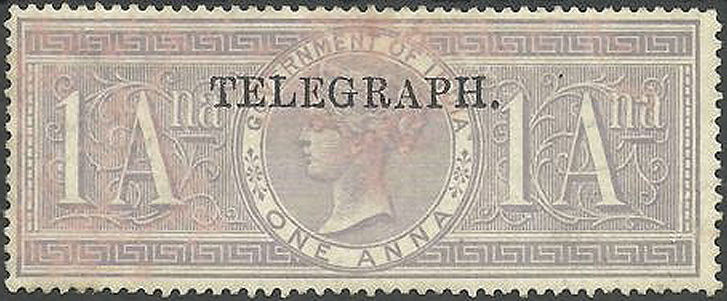
RH21 (Type 26 overprint) courtesy of Tony Brown (anthonybrown55 on ebay).
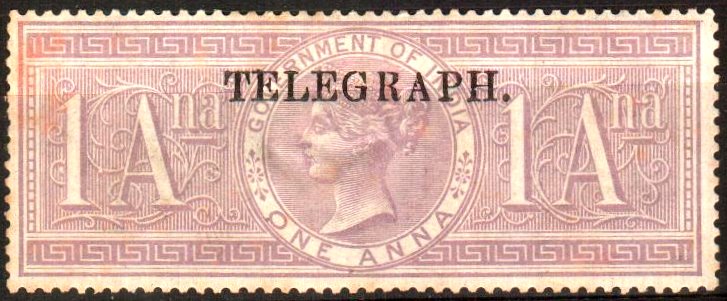
RH22 (Type 26 - 24 x 2½mm overprint). from Wikimedia Commons
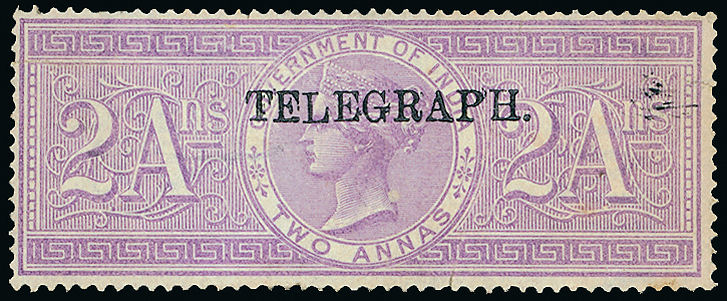
RH24 (Type 26 - 24 x 2½mm overprint). courtesy of Grosvenor Auctions. Sold as S.G. T25
This overprint looks more uneven than the others, with the 'G' slimmer.
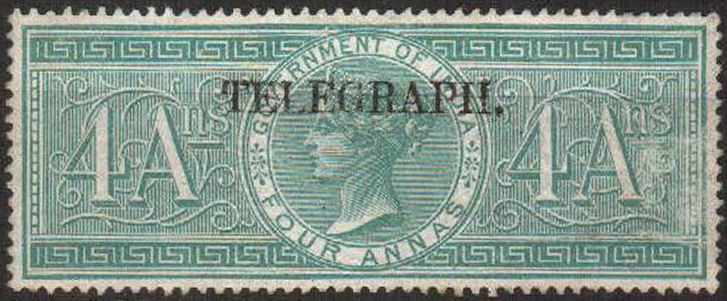
Type 26 - 24mm x 2½mm overprint on 4As (not listed by Hiscocks - added as RH27), courtesy of Moses at mystampzone, or on ebay.
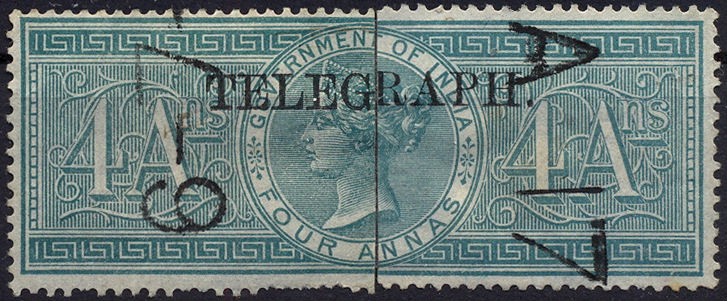
Type 27 (28 x 3mm) for comparison (RH26) - a composite of separate left and right halves from RL.
There are some apparent differences in these Type 26 overprint examples. The images are from different sources, using different scanners.
Scanners vary in their accuracy of stated resolution (something not generally specified). Also individual impressions are not always perfect.
But I cannot help wondering if these are all genuine overprints. - Any experts out there care to comment ?

RH23, RH25 and RH26 (Type 27 overprint - 28 x 3mm). Images courtesy of www.stampbay.com
| For comparison. | |
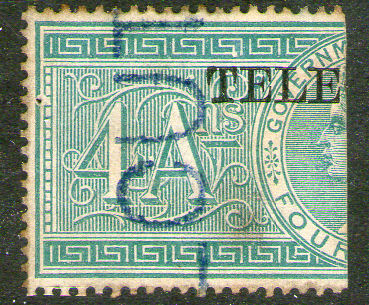 |
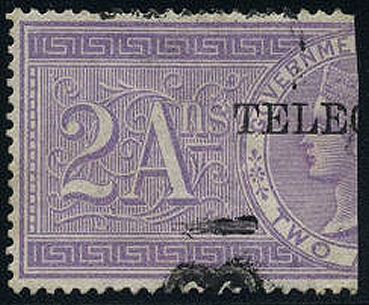 |
| RH26 (Type 27 overprint - 28 x 3mm) | RH32 (Type 26, 24 x 2 ½mm) courtesy Rupert of Strathspey Philatelics who tells me SG price the left half at 25% more than the right. |
| RH # | Hisc. | Ovpt. | Note | 1881 Calcutta Description | Mint | Used |
|---|---|---|---|---|---|---|
| RH21 | H21 | 26 | 1, 2 | 1A dull lilac/blue, overprint 24x2½mm (Feb. 1882) (Note 1) | 250.00 | 32.00 |
| RH22 | H22 | 26 | 1, 2 | 1A dull lilac/white, overprint 24x2½mm (Feb. 1882) (Note 1) | 250.00 | 32.00 |
| RH23 | H23 | 27 | 1, 2 | 1A dull lilac/blue, overprint 28x3mm (Feb. 1882) (Note 1) | 250.00 | 32.00 |
| RH24 | H24 | 26 | 1, 3, 4 | 2A bright lilac, overprint 24x2½mm (Feb. 1882) (Notes 2 and 3) | - | - |
| RH25 | H25 | 27 | 1, 3 | 2A bright lilac, overprint 28x3mm (Aug. 1881) (Note 2) | 150.00 | 32.00 |
| RH26 | H26 | 27 | 1, 3 | 4A green, overprint 28x3mm (Aug. 1881) (Note 2) | 150.00 | 24.00 |
| *RH27 | - | 26 | 1 | 4A green, overprint 24x2½mm (illustrated above, Feb. 1882 ?) | - | - |
* I added RH27 due to the example shown.
Madras 1882 overprints: 26 x 2¾mm — no stop (18½ teeth) Type 28.
These tend to be across the face of the Queen. This was very much a French-influenced area.
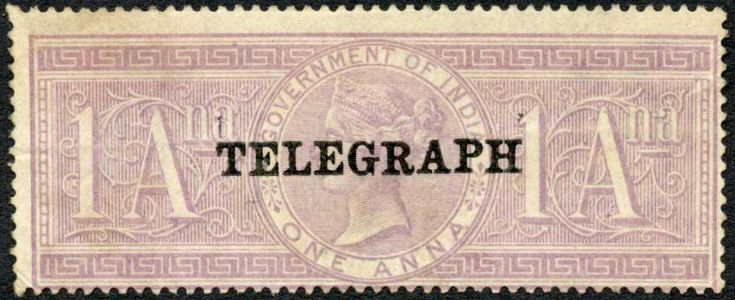
RH28 - courtesy of Mark Bloxham.
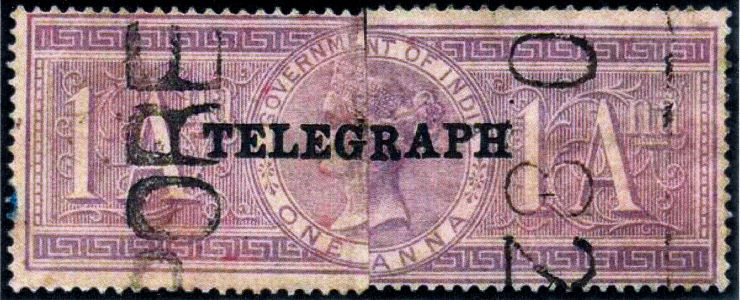
RH28 from lot 166 of the listing of the Indica Collection Auction, courtesy of Stanley Gibbons.
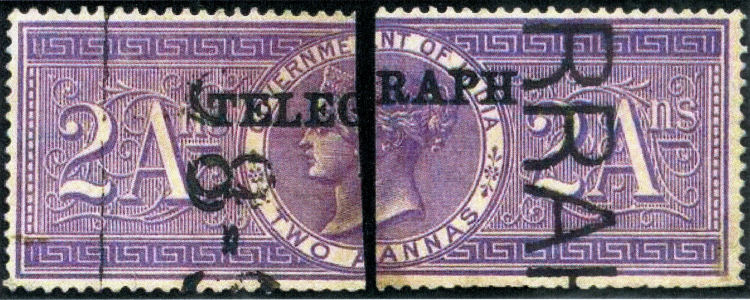
RH29 from lot 169 of the listing of the Indica Collection Auction, courtesy of Stanley Gibbons.
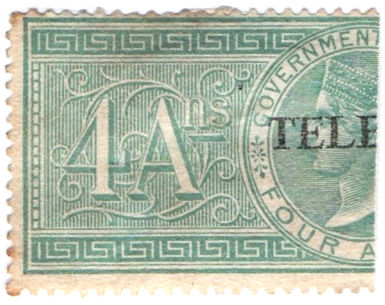
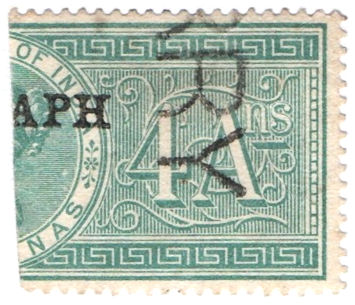
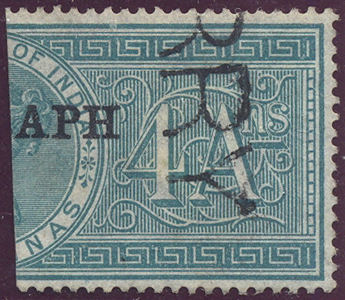
RH30 Note the Pondicherry cancel. Pondicherry was part of French India and in the Madras area. The letter A has a relatively thick left side.
Left two images courtesy of Paul & Les Bottomley. Right image from RL
| RH # | Hisc. | Ovpt. | Note | Madras 1882 Description | Mint | Used |
|---|---|---|---|---|---|---|
| RH28 | H27 | 28 | 1 | 1A pale lilac (20.3.82) (4,000) | 500.00 | 100.00 |
| RH29 | H28 | 28 | 1, 6 | 2A bright lilac (20.3.82) (4,000) | - | - |
| RH30 | H29 | 28 | 1 | 4A green (17.4.82) (48,000) | 250.00 | 20.00 |
Bombay 1881 overprints: Type 29 (26 x 3mm), Type (26) (24 x 2½mm)
| For comparison. | |
 |
 |
| RH26 (Type 27 overprint - 28 x 3mm) | RH32 (Type 26, 24 x 2 ½mm) courtesy Rupert of Strathspey Philatelics who tells me SG price the left half at 25% more than the right. |
Type 29 Image needed.
See Note 5.
| RH # | Hisc. | Ovpt. | Note | Bombay 1881 Description | Mint | Used |
|---|---|---|---|---|---|---|
| RH31 | H30 | 29 | 1, 5 | 2A bright lilac, overprint 26 x 3mm — no stop (13.8.81) (400) | 1250.00 | 400.00 |
| RH32 | H31 | (26) | 1, 5 | 2A bright lilac, overprint 24 x 2½mm (15.8.81) (16,800) | 250.00 | 20.00 |
Hiscocks added the following 6 notes:
| Note 1. It will be noted that strictly speaking Nos. 21-31 comprise two separate issues — August 1881 and February-April 1882. |
| Note 2. The total printing of Nos. 21, 22 and 23 was apparently 16,000 of which at least 4,000 were destroyed when the 1882 (second watermark)normal stamps, the late arrival of which necessitated these provisionals, finally arrived. Some of these were supplied to Bombay which had run out of 1A special adhesives at that time. |
| Note 3. Numbers printed are not known for Nos. 24, 25 and 26. |
| Note 4. No. 24 is listed by some references but not by others. |
| Note 5. [The overprint on H30] is very similar to [The overprint on H23,H25 and H26] but has no stop, is very roughly printed with broken letters, small 'A', etc, and is usually crooked and lower down on the stamp. The type used on No. 31 is almost identical with [that on H21,H22 and H24] but may be distinguished in that the printers in Calcutta were instructed to place the overprint "over the coronet" and did so, while those in Bombay overprinted (as in No. 30) lower down across the face. |
| Note 6. The printing of No. 28 is reported but no specimens have been observed. |
There are quite a few fakes of these overprints about. Some have clear indications of being fake, but others can be more dangerous.
These Special Adhesive revenue stamps were not used for telegraph purposes other than with these overprints. Used ones should be bisected with the normal inline telegraph cancel.
Fiscal cancels though were often done by embossing with a large ornate design and date plugs. This should not exist on a genuine telegraph stamp !
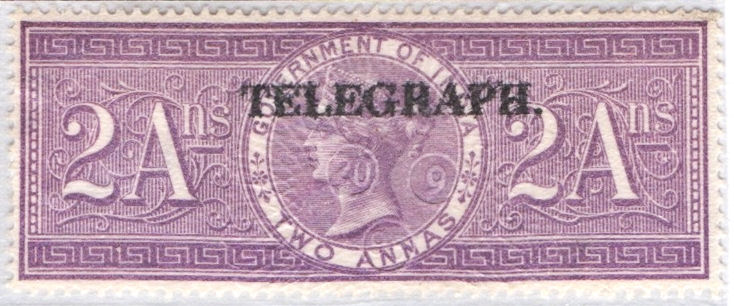

Here is an example, see the embossing, it even shows date-plugs of 20/9/90, well beyond the time genuine ones were used.
This overprint also shows very ragged edges, in contrast to this genuine one below, but most are more convincing.
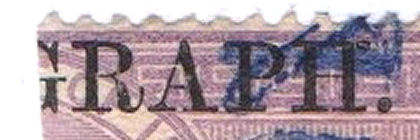
I hope this saves some people from wasting their money. These 3 images courtesy of Paul & Les Bottomley.
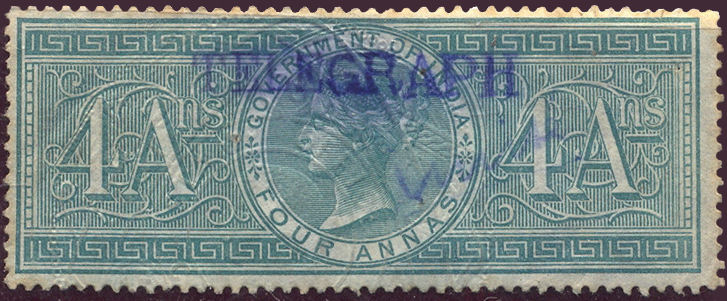
Another example where the embossed fiscal cancel is clearly visible. These overprints were always in black, no exotic colourations.
The 'T' is 3.2mm tall, the 'H' is 3.7mm tall suggesting a rubber handstamp.
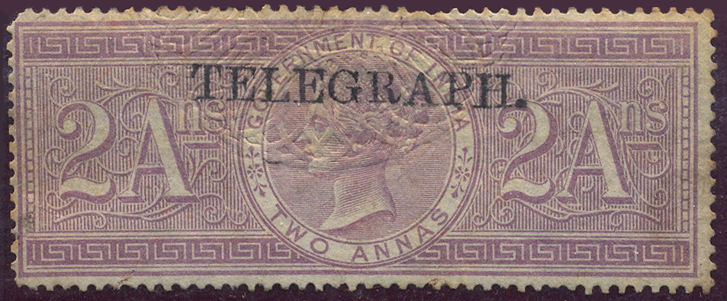
Another example, this with a very obvious fiscal cancel. If not for that. this could have been dangerous, so the overprint needs looking at closely so it can be recognised.
The top of the 'T' is slightly slanted and the serifs slightly splayed. the 'G' is more rounded than usual. The bottom serif on the 'R' slants outwards.
Also, the whole overprint is slanted downwards about 1.2 degrees relative to the stamp
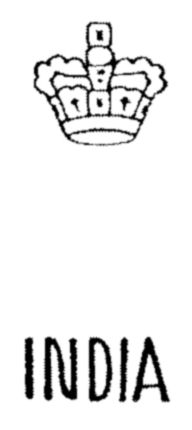 W2 - with added 'fleur de lis'. |
Hiscocks added the following 2 notes:
|
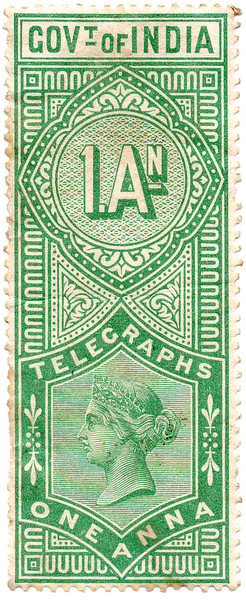 |
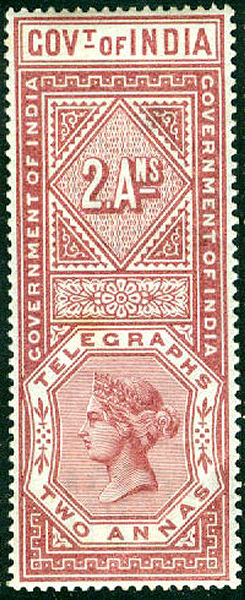 |
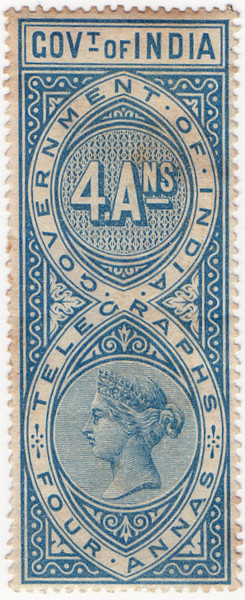 |
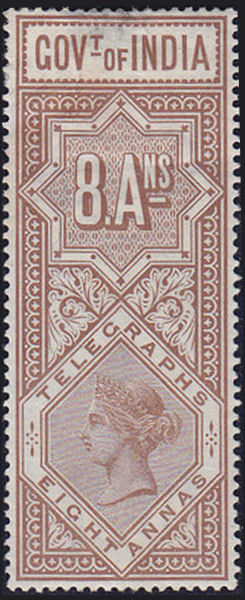 |
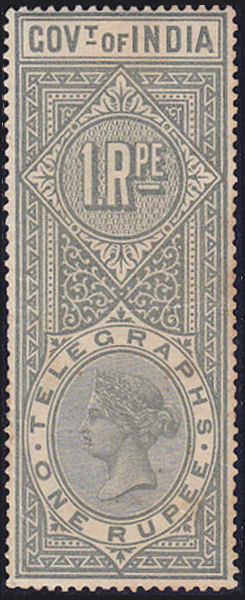 |
| 1 Ans. H42 | 2 Ans. H43 | 4 Ans. H44 | 8 Ans. H45 | 1 R. H46 |
| H42 and H44 images courtesy of ibredguy.co.uk, H43 from from Wikimedia Commons - all reduced size. | ||||
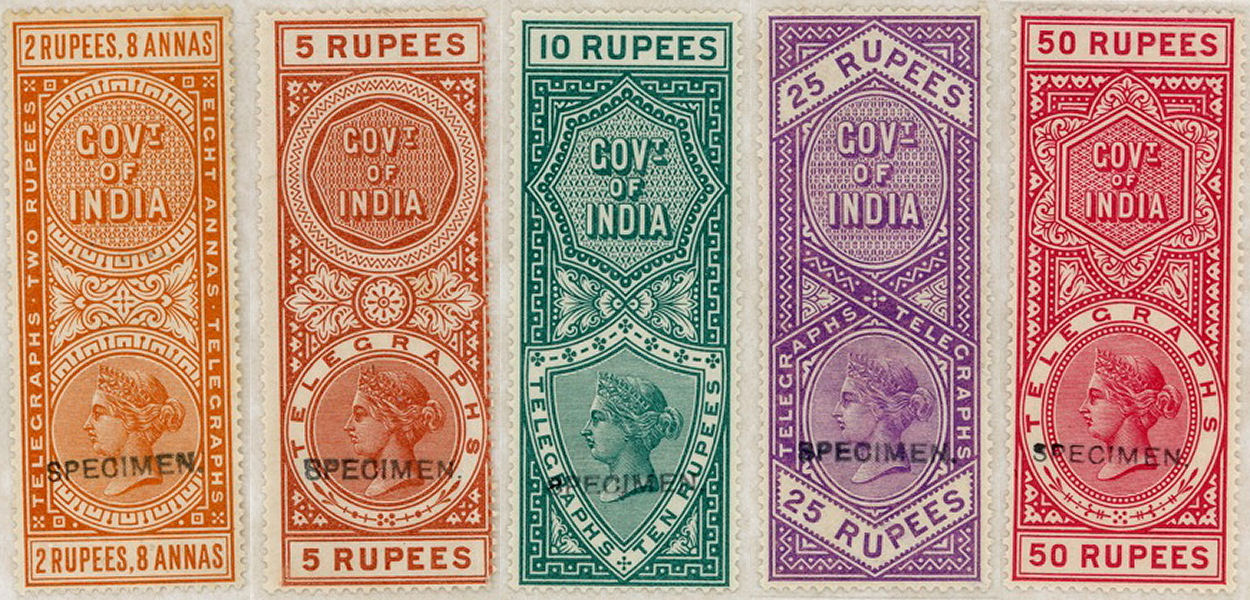 |
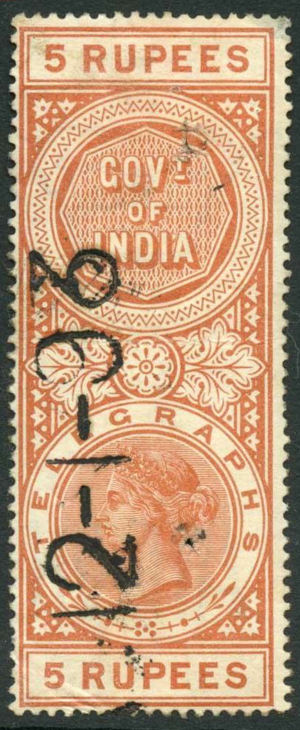
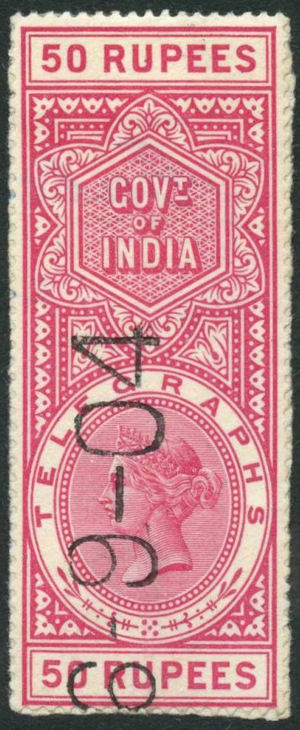 |
||||
| 2½ R. H47 | 5 R. H48 | 10 R. H49 | 25 R. H50 | 50 R. H51 | 5 and 50 R. used examples. |
| The rest of the set (reduced size as specimens), courtesy of Dr Mark Gibson. | Whole used examples, courtesy of Mark Bloxham. | ||||
| RH # | Hisc. | Description | Mint | Used |
|---|---|---|---|---|
| RH43 | H42 | 1A yellowish green (Aug. 1890) | 12.00 | 0.50 |
| RH44 | H43 | 2A maroon (Jan. 1891) | 12.00 | 1.00 |
| RH45 | H44 | 4A blue (shades) (Aug. 1890) | 16.00 | 0.50 |
| RH46 | H45 | 8A brown (Aug. 1890) | 16.00 | 0.50 |
| RH47 | H46 | 1R grey (Aug. 1890) | 16.00 | 0.50 |
| RH47a | H46a | bluish grey | 16.00 | 0.50 |
| RH48 | H47 | 2R 8A orange (shades) (Jan. 1891) | 40.00 | 2.00 |
| RH49 | H48 | 5R brownish orange (Jan. 1891) | 32.00 | 1.50 |
| RH50 | H49 | 10R blue-green (Jan. 1891) | 60.00 | 1.50 |
| RH51 | H50 | 25R bright lilac (Jan. 1891) | 80.00 | 3.00 |
| RH52 | H51 | 50R carmine (Jan. 1891) | 100.00 | 4.00 |
Hiscocks added the following 3 notes:
| Note 1. A large proportion of the 2½R stamps (No. 47) in stock in India and those at the printers (de la Rue) were converted to 2R as below. |
| Note 2. Stamps of this issue are occasionally met with used whole — prices as for mint. |
| Note 3. Used half stamps can be difficult to allocate between the above issue and those of King Edward VII (1904) and many cannot be allocated at all — see note below No. 65. Prices above are for those which can be identified. |
These were used while awaiting H55 below, which were actually a bit of a disaster because the colour was hard to see and
there was a danger of the stamp being affixed inverted (entailing the fining of the clerk responsible)
The stamps then had to be marked with a red line to prevent it.
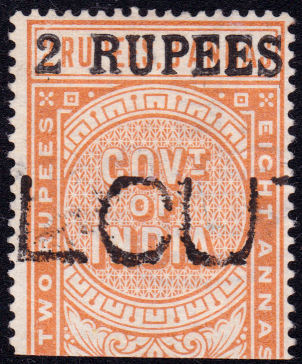 |
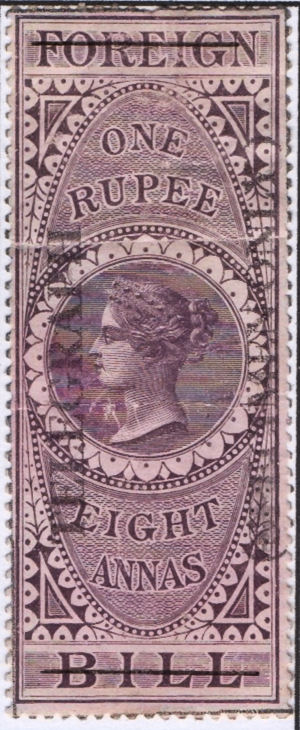 |
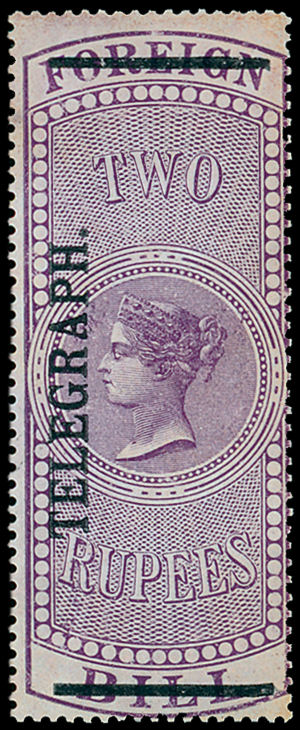 |
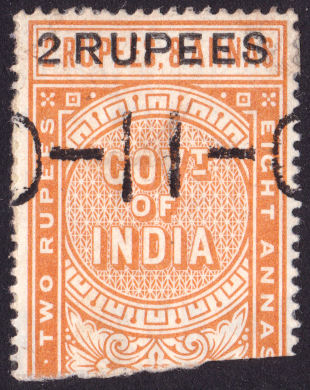 |
| H52 Calcutta 2 Rupees overprint on H47. |
This is a bit of a puzzle, compare it to H53. It has a similar overprint plus on the right-hand side says 'SPECIMEN ONLY' It is stated to have a boxed advert for Errington and Martin on the back. These stamp importers used near-worthless stamps to advertise their company. They also had a reputation for combatting forgery. Is this a genuine specimen of an unknown essay, or a forgers attempt to discredit them ? If the last, they went to a lot of work for nothing. Anyone have something similar ? Image courtesy of Paul & Les Bottomley. |
H53 Courtesy of Grosvenor Auctions. |
H54 De La Rue 2 Rupees overprint on H47. |
For the sake of interest, here is a range of examples of the Errington and Martin adverts on the back of stamps :
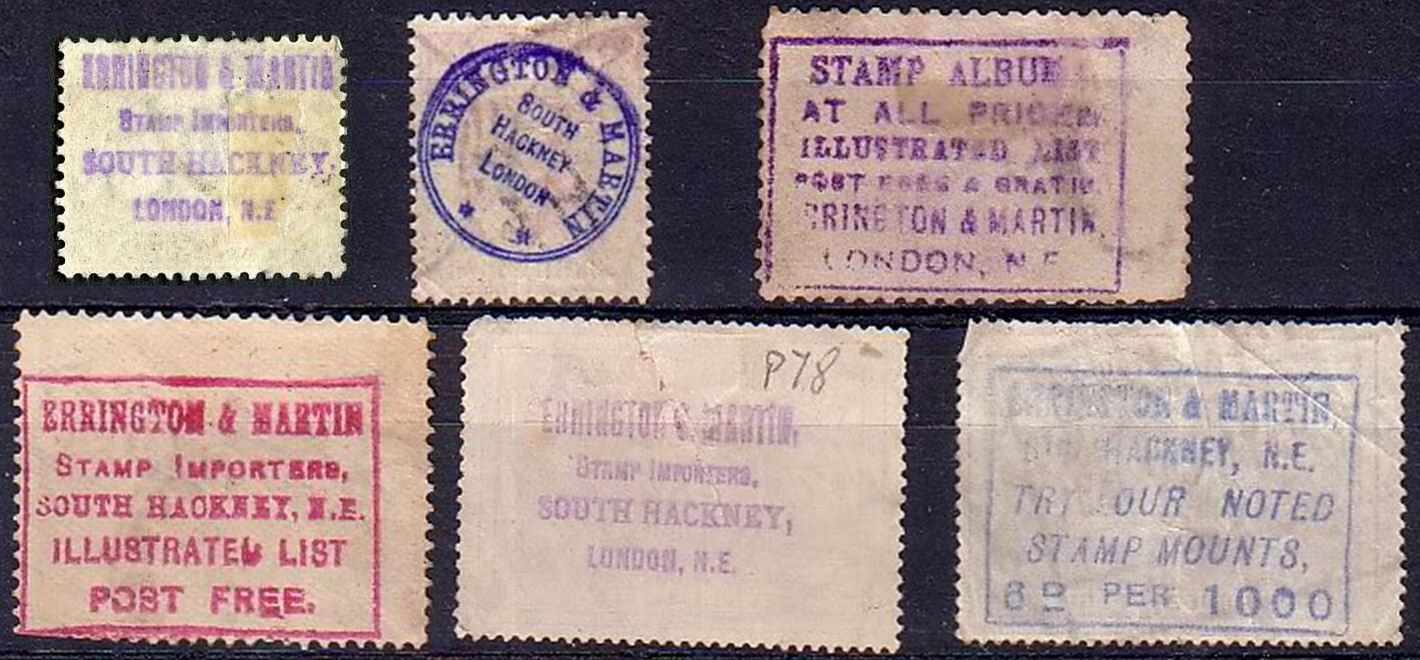
Image courtesy of Paul & Les Bottomley.
Forgers have certainly been at work here.
| Calcutta overprint |  |
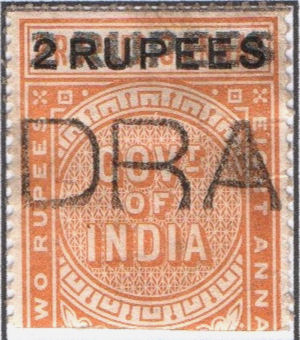 |
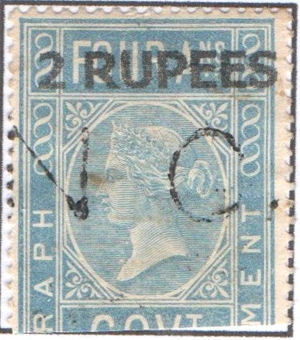 |
| De La Rue overprint |  |
||
| Forgery overprint |  |
This is presumably intended to look like a double overprint and a 2Rs on 4As.
Images courtesy of Paul & Les Bottomley.
For the sake of completion, here is a comparison of the 'TELEGRAPH' overprint on H53 and the dubious item above, together with the earlier Provisional issue of Calcutta.
Given the importance of the red line to ensure that the stamp was the right way up, I was intrigued about how the RH56a below was used.
It has holes through both halves, so certainly there is no chance of re-use, but survival of complete used examples, according to Note.2 below, was due to small offices combining Posts and telegraphs
together and putting all the stamps on the message part. Allahabad was made the Capital City of the North Western Provinces in 1858, so it was not a small place, though it probably had suburban offices.
for King Edward VII. Other details as previous.
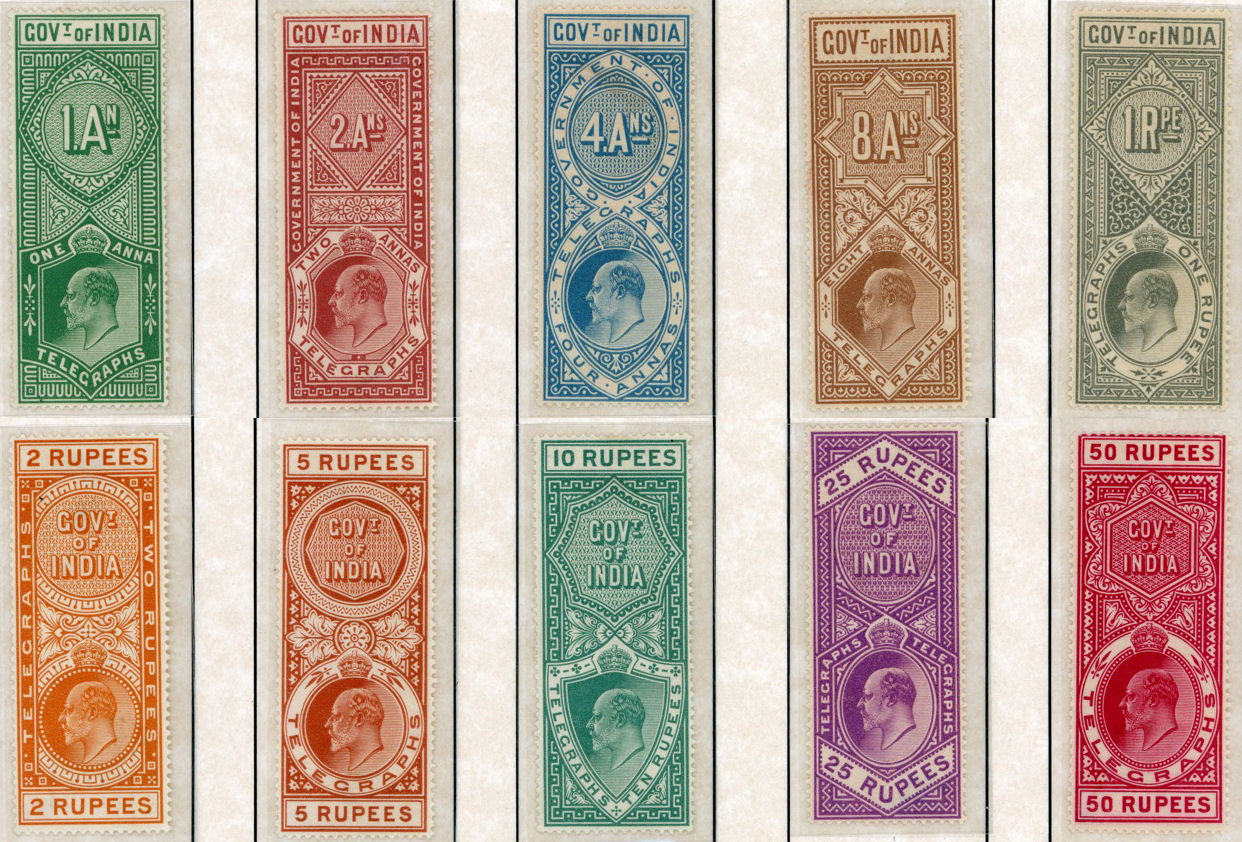
Reduced size images, courtesy of Dr Mark Gibson.
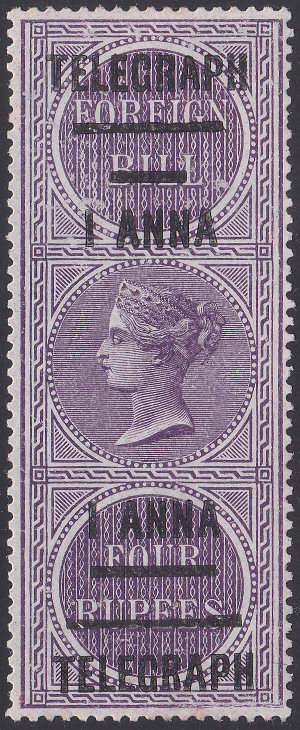 |
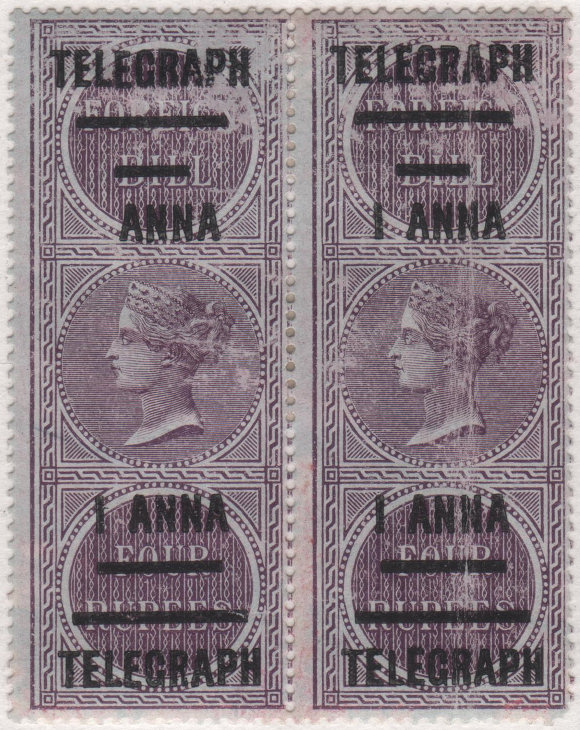 |
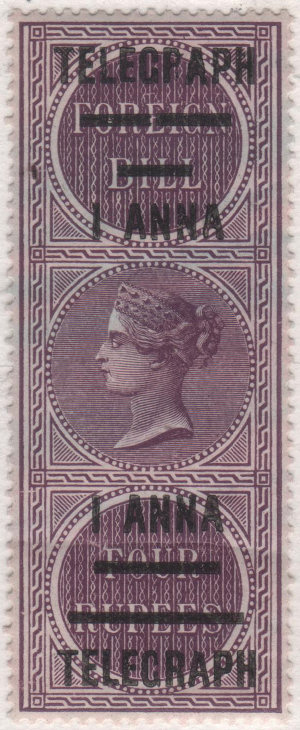 |
| RH67 - position 55 | RH67a on the left, together with normal. Courtesy of Steven Zwillinger. Steven says that there was one per pane and soon corrected. |
*RH67f - 'P' for 'R' Courtesy of Steven Zwillinger. Steven says one per sheet. |
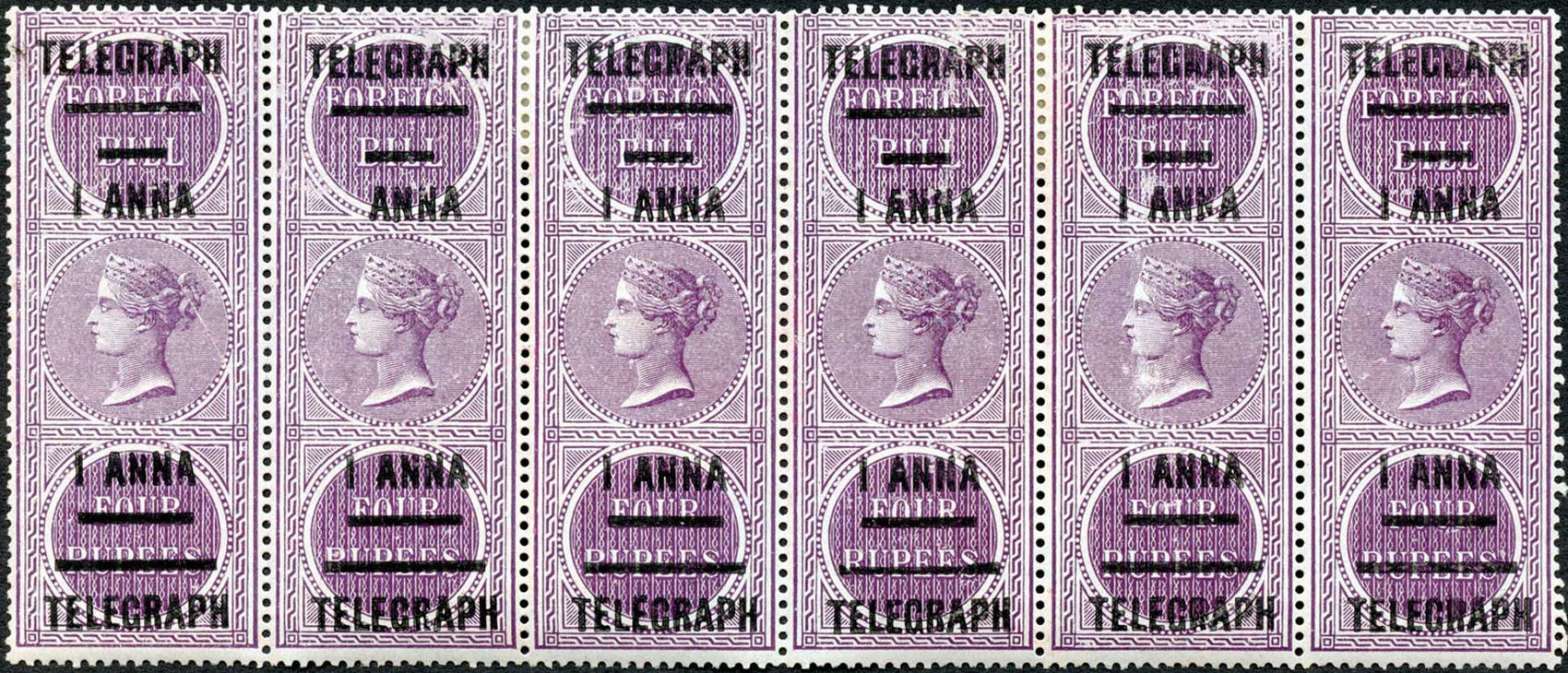
Strip of six, positions 52-57. Shows position 53 which has the number 1 omitted and position 55 with two breaks in the bottom bar. That matches the one above-left that I had chosen as a normal one, but there are a lot of flaws here.
position 54 between them has a damaged "T" at the top and nearly all have problems with the letter "R" at top or bottom. Image courtesy of Mark Bloxham.
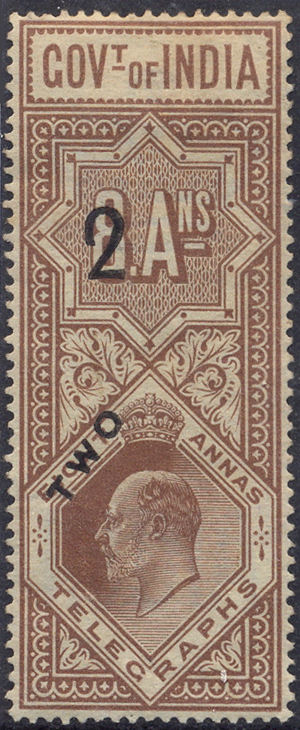 |
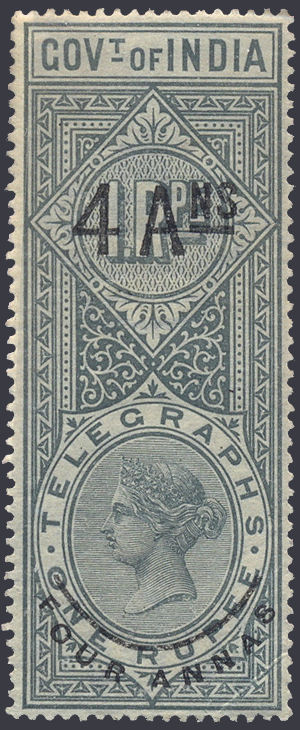 |
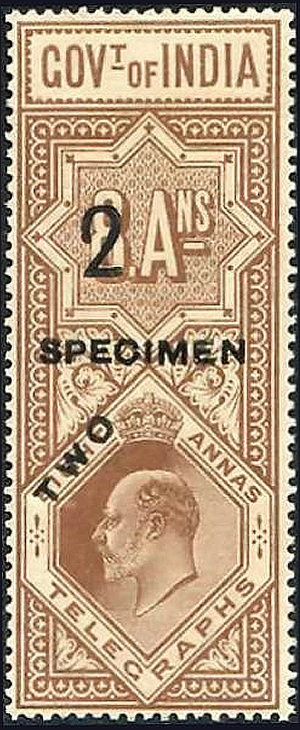 |
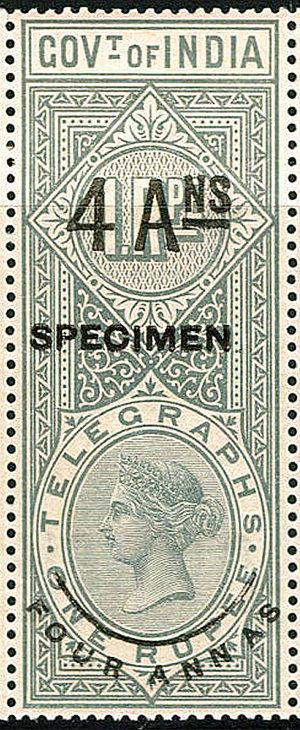 |
| RH68 from RL | RH69 from RL | RH68 Specimen courtesy of Martin Robinson |
RH69 Specimen from Wikimedia Commons |
There are differences in the "FOUR ANNAS" overprint due to its trying to follow the curve at the bottom.
Regarding Note 1 above, Steven Zwillinger provides this helpful table for Inland rates:
It is taken from a book by Ilyas Patel & Dhananjay Desai. There is also a pdf doc downloadable with this and more information.
| Length of message | Rate | Extra words | ||
| 1887 Rates | Rs. | As. | As. | |
|---|---|---|---|---|
| Deferred | 24 characters | 0 | 8 | 1 |
| Ordinary | 24 characters | 1 | 0 | 1 |
| Urgent | 24 characters | 2 | 0 | 4 |
| 1904 Rates | ||||
| Deferred | 4 words | 0 | 4 | 1 |
| Ordinary | 16 words | 1 | 0 | 2 |
| Urgent | 16 words | 2 | 0 | 4 |
Later the deferred rate was changed to 10 words for the first 4 annas.
| Length of message | Rate | Extra words | ||
| Later Rates | Rs. | As. | As. | |
|---|---|---|---|---|
| Deferred | 10 words | 0 | 4 | 1 |
| Ordinary | 16 words | 1 | 0 | 2 |
| Urgent | 16 words | 2 | 0 | 4 |
Here is a (half size) receipt using these provisionals:

Form F.SA with 7 annas for an Inland deferred telegram from Kalbadevi (Mumbai) with 7 words dated 27-11-04, courtesy of Steven Zwillinger, who also provided the table below.
| No. surcharged July 1904 | No. destroyed August 1904 | No. sold/used July-August | |
| 1 anna Victoria | 238,318 | 30,810 | 207,508 |
| 4 anna Victoria | 480,480 | 39,398 | 441,082 |
| 2 anna Edward | 464,000 | 273,293 | 190,707 |
The surcharged issue was withdrawn and destroyed when additional telegraph stamps were received from England in August 1904.
An exhibit by Steven Zwillinger of the USA displays an example of this form as well as some pre-stamped forms and Telegraph stamps.
The exhibit specifically relates to the Edwardian issues. Interestingly it mentions that the 1906 Postal Service issue could
be used to pay for telegrams at combined Post and Telegraph Offices, "though none are recorded."
These would get telegraph cancels, whereas in normal use (Customs Duty) these stamps would get purple cancels.
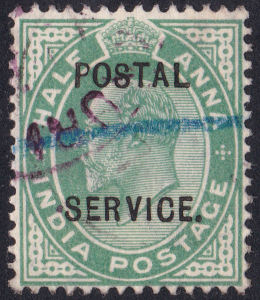
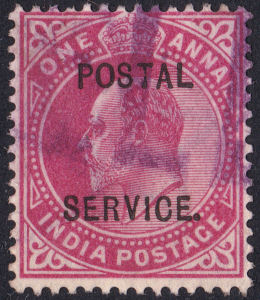
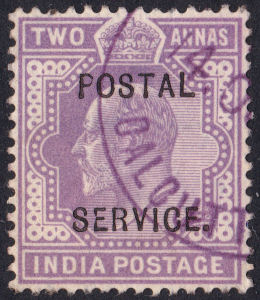
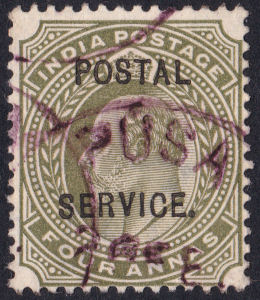
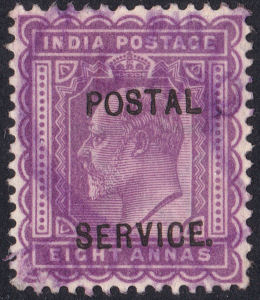
A range of Postal Service stamps with the normal purple cancels.
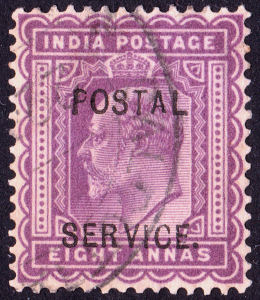
An example of an 8As used in Calcutta with a black cancel.
Here are some Victorian high values with black cancels:
The 2Rs are all used in Gulmarg, Kashmir. The pair and the 3Rs appear to have normal in-line telegraph cancels.
According to secunderabad/history, Secunderabad was exempted from customs duty, so their normal purpose would not have been needed there.
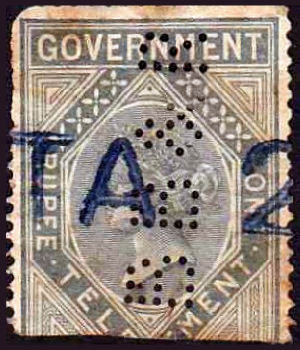  Perfins are known on these (though scarce). This one 'B B & R' is an unknown user in Calcutta. Image courtesy of Jeff Turnbull. We would be interested to hear of other examples. |
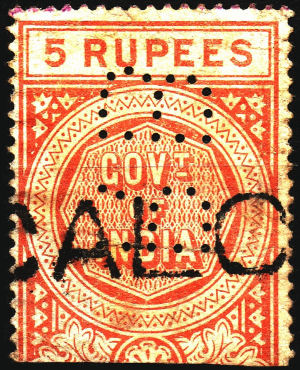 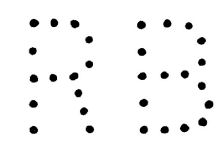 Another from Calcutta, this is Ralli Brothers Perfin No. R 3. This is known on H44, H47, H48 (1890) and H69. Image courtesy of Jeff Turnbull. |
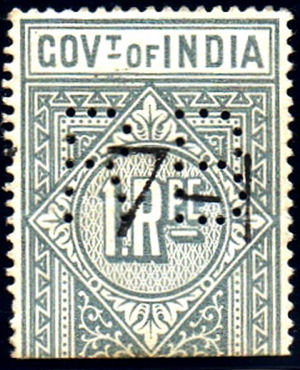
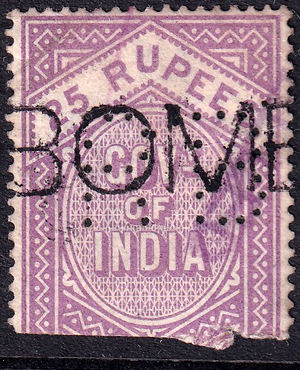  In Bombay this Ralli Brothers Perfin is known upright on H46 and H50 (1890) Images courtesy of Jeff Turnbull. |
See also the "CanD" Perfins that were used as additional cancels ?
As well as the two diamonds mentioned by Hiscocks, Ceylon and Portuguese India also used these stamps in their early days.
ANURADHAPURA, BADULLA, BATTICALOA, COLOMBO, GALLE, GAMPOLA, JAFFNA / JAFFRA (error), KALATURA,
KANDY, MANAAR, MATALLE, NAWALAPITYA, NEWERA ELLIA, PANADURE and TRINCOMALLEE were in
Ceylon, though be careful not to read 'OMB' as 'COLOMBO' when it is more likely 'BOMBAY'.
GOA was a Portuguese colony, and another colony DAMAUN may also have used them.
I have also listed the Pondicherry diamond under French India.
A less well known one is Negapatam (various spellings) in Tamil Nadu, a former Dutch colony. This one courtesy of AlphaOmegaPhilately on eBay. (Click on image for listing).
The diamonds are the exotic ones, but it was more usual to have "in-line cancels" with the station name and date.
This is an early example used at Gwalior on 29 April 1869. The 1 Rp stamp is Die I.
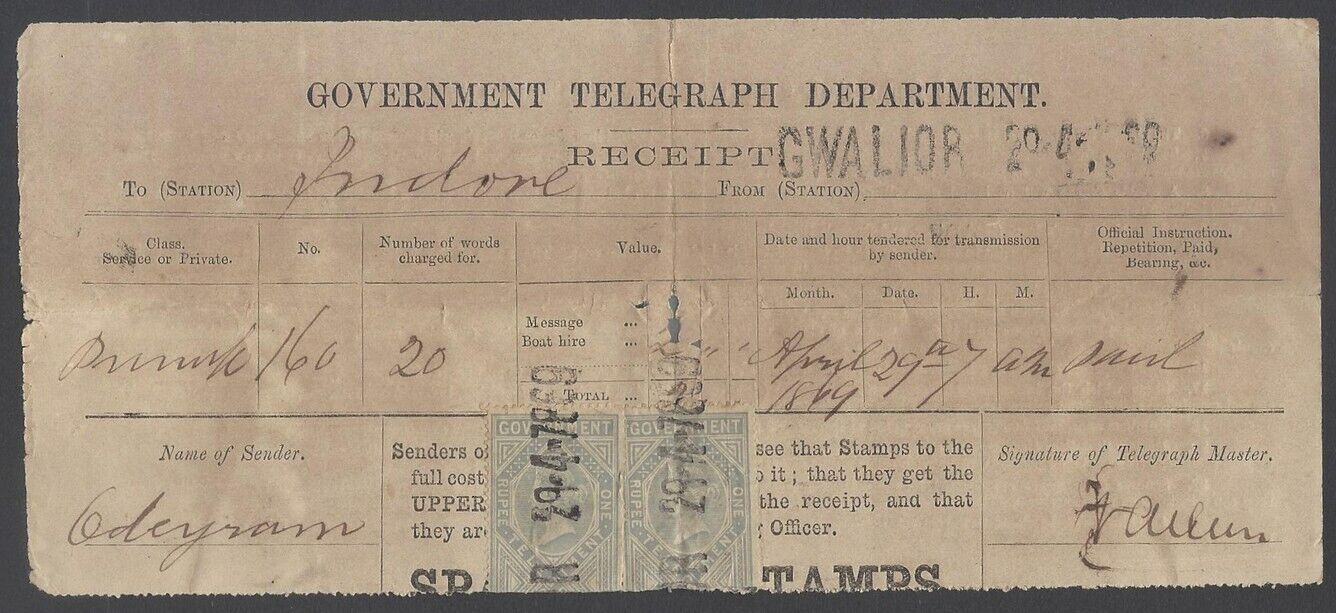
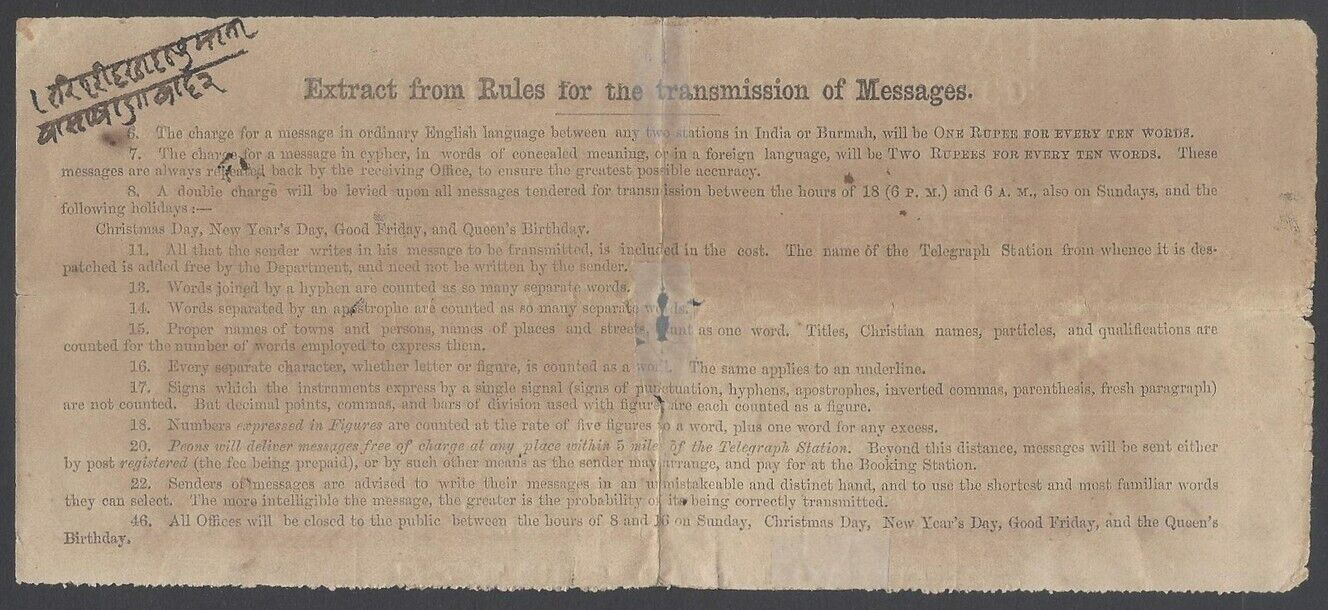
This back, has an Extract from Rules, with selected numbers from 6 to 46. Images courtesy of AlphaOmegaPhilately on eBay. (Click on image for listing)
This is 2 years later, still at Gwalior but on 10 April 1871. The 1 Rp stamp is Die II.
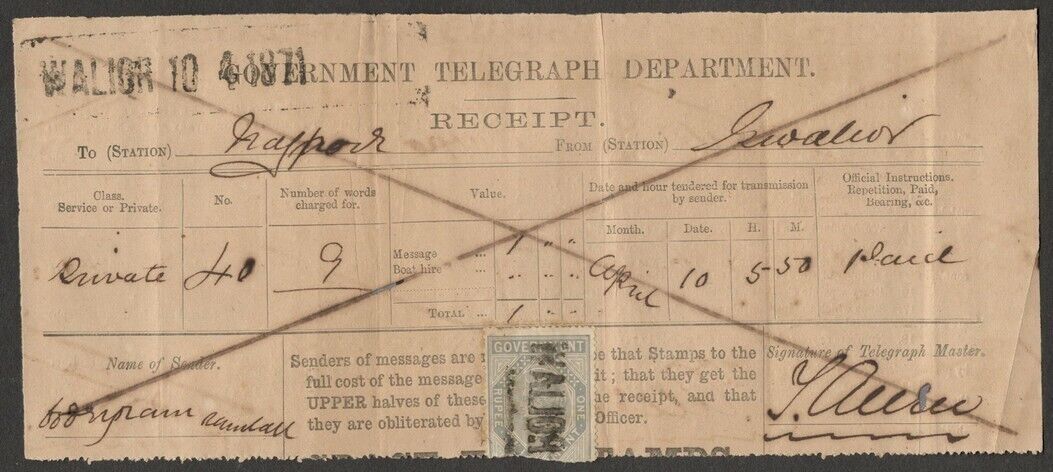
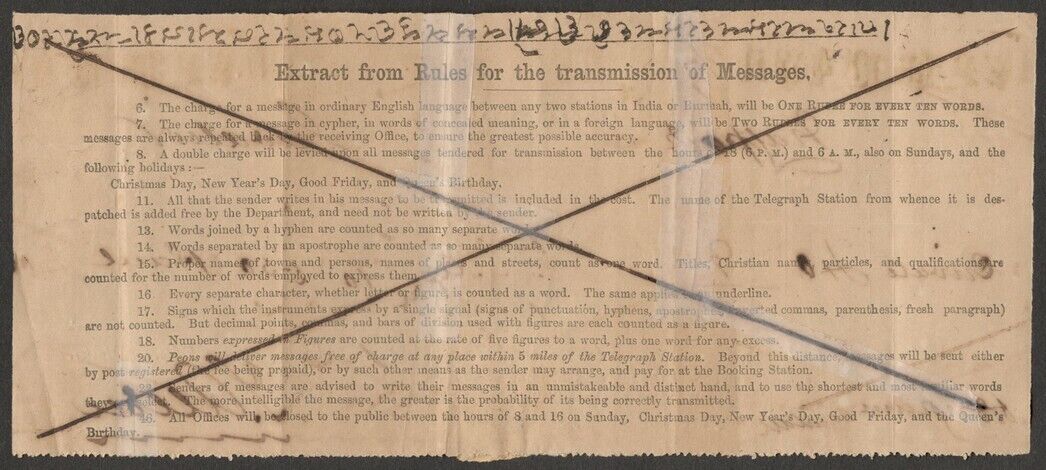
The back, has the same Extract from Rules, but the cancel is now smaller and is missing the initial "G". Images courtesy of AlphaOmegaPhilately on eBay. (Click on image for listing)
.
This appears to be the same type of form as the last, but was used at Mundisore which used a distinctive, undated cancel.
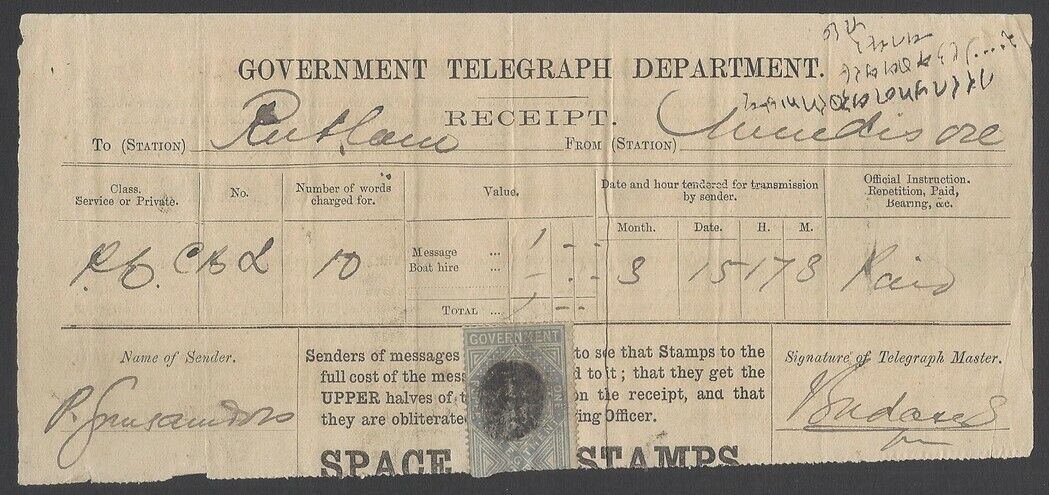
It bears a 1 Rupee die 1 stamp, so is probably 1869 or soon after, but who needs to know the year, right !
"SPACE FOR STAMPS" in thick seriffed lettering. Image courtesy of AlphaOmegaPhilately on eBay.
Another example, used at Mundisore, but with two 8As stamps.
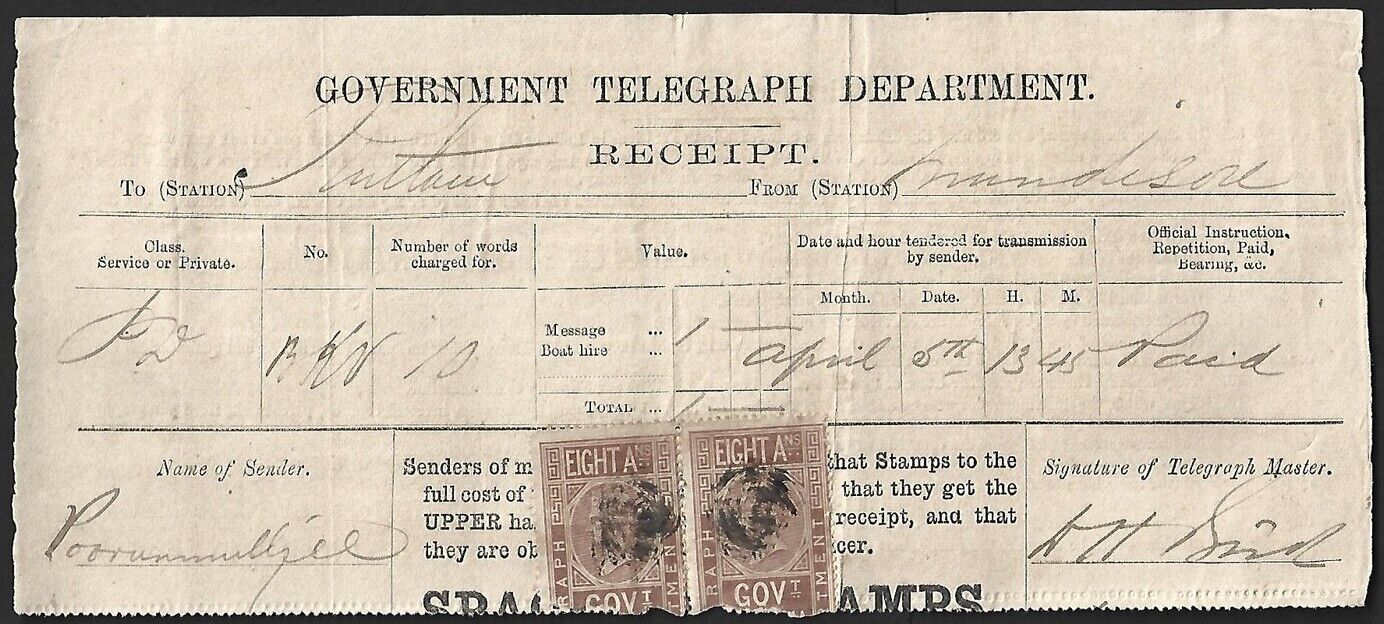
Again it seems to be the same type of form, but the cancel is a little clearer.
Image courtesy of AlphaOmegaPhilately on eBay.
Front and back (half-size) of a typical Inland receipt cancelled 'KARACHI 12-3 08'. This kind of cancel was normal.

Since only the top half should be on the receipt, the 1890 and 1904 series, used halves were normally indistinguishable.
This was a deferred telegram to Bombay for 7 annas, presumably having 13 words. Telegraph stamps were withdrawn shortly after, on 1st April 1908.
According to The Stamp Forum, the telegraph service in India finally came to an end on 15th July 2013.

Royal Exchange (Calcutta / Kolkata) 25 April 1902 (Popularly known as Bengal Chamber of Commerce and Industry Building), from RL.

Lot 133 of the Indica Collection Auction (28 September 2021), courtesy of Stanley Gibbons.
This shows the special IMPERIAL ASSEMBLAGE cancel of 6.1.77, used at the Delhi Durbar at which Queen Victoria was declared Empress of India.
According to Stanley Gibbons "This strip merited specific mention in Crofton and Corfield’s book ‘The Adhesive Fiscal and Telegraph Stamps of British India’ (page 48)".
In 1885 (12 March) the British arrived in Cairo on what was called the Suakin Expedition, to combat the Mahdi in Sudan.
His force consisted of 2 British infantry brigades, elements of 4 cavalry regiments, including Australian, and an Indian infantry brigade.
It appears that the following hand-stamps were applied for accountancy purposes on telegrams involved in supporting the Indian brigade.
"EGYPT EXPEDITION / 1885." in purple.
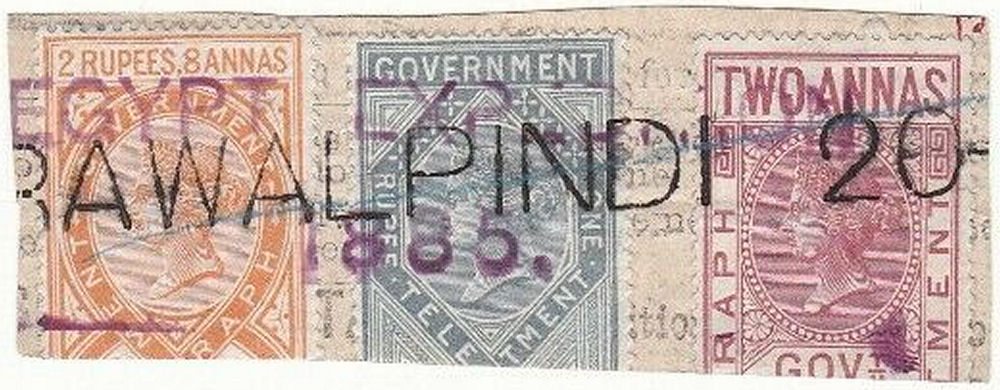
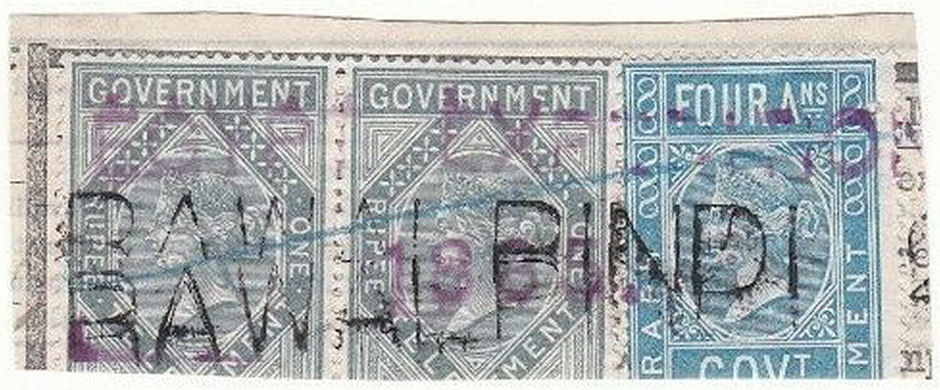
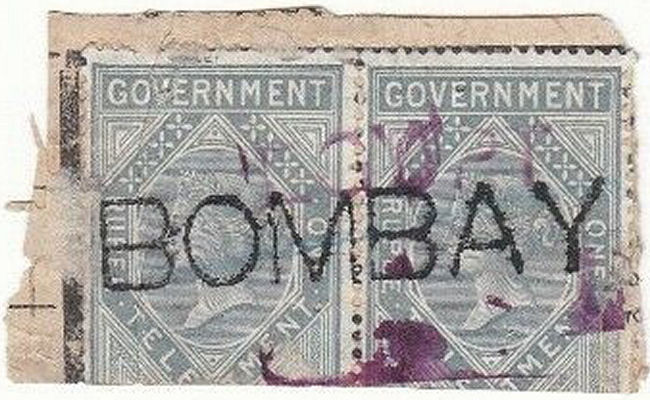
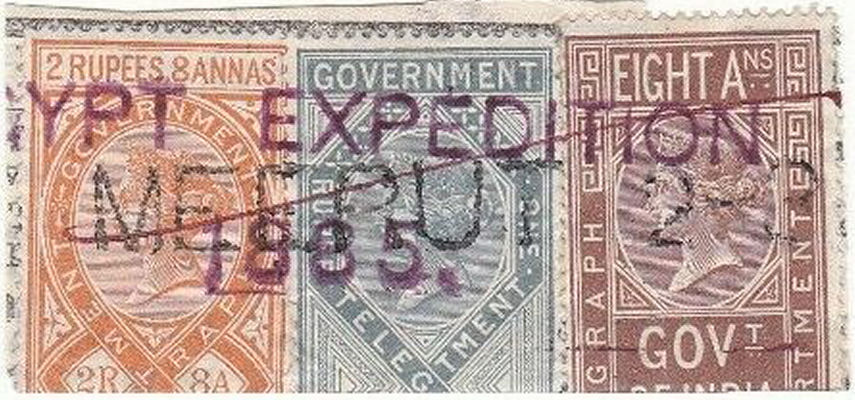
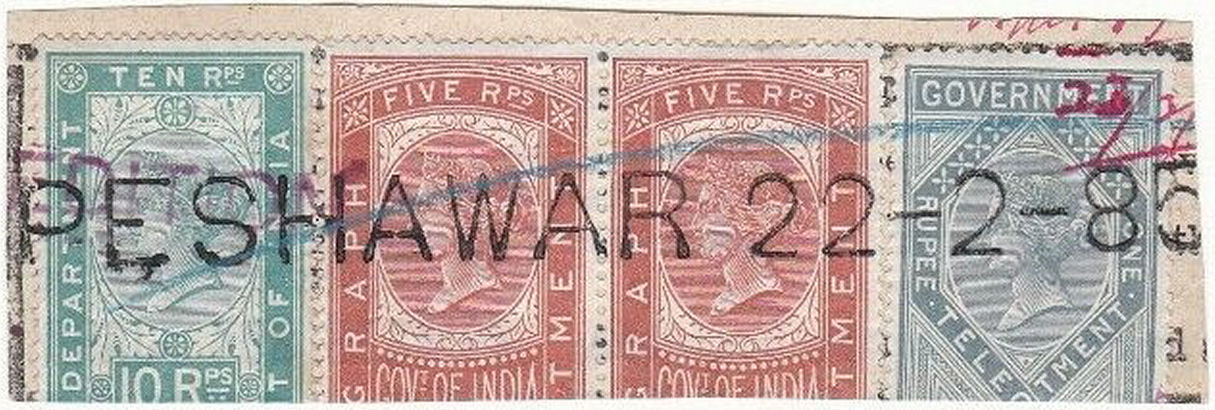
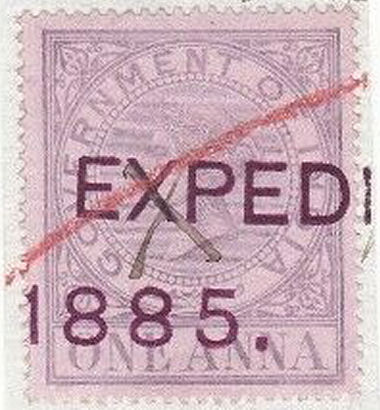
It can be seen that these were used in a number of different places. I can see dates of 22/2/85 and 2/3/85. Presumably the receipts were sent to a different location where accountancy was done and the hand-stamp applied.
The last example shows that it was not just telegraph stamps that were involved. These images are courtesy of
Abdelrahman Daw, — dawphilately on eBay.
According to Stanley Gibbons Lot 354 of the Indica Collection:
"This cancel was used at railway stations for the Indian contingent of the Expedition, prior to embarkation, and is found used from a number of telegraph
offices"
Here is a (half size) Form F.A. Receipt from Amirs Camp. Amir Habibullah Khan of Afghanistan made a state visit to India in 1907.
A travelling telegraph office was set up to accompany him while travelling around India.
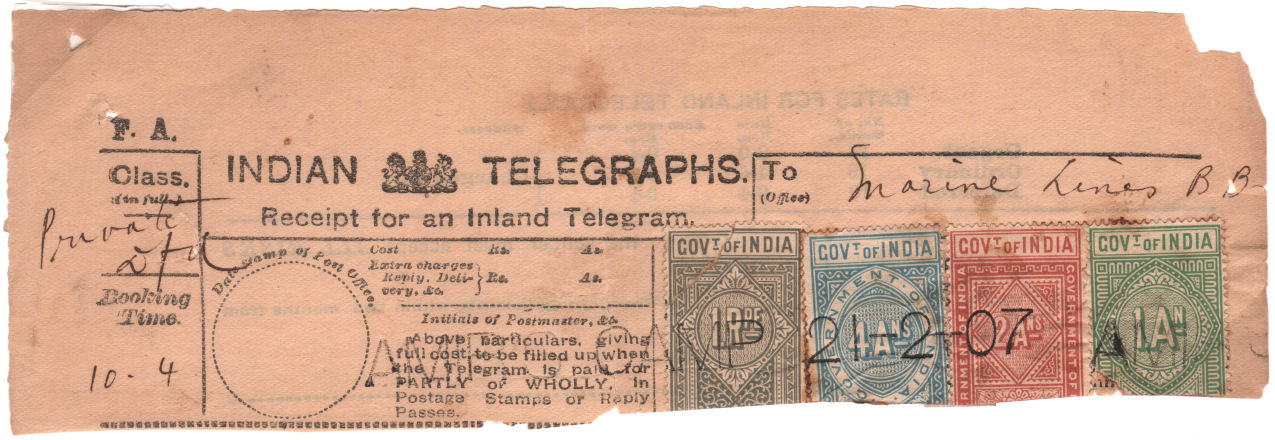
Form F.A with 1 Rupee 7 annas (23 annas, for 29 words at the new rate) for an Inland deferred telegram dated 21-2-07, courtesy of Steven Zwillinger.
For "Bullseye" type cancels, see After Telegraph Stamps.
Here is an interesting sequence, courtesy of Jeff Turnbull.
They involve perfined boxes containing "CAND" and a number from 1 to 10 and an unboxed "CD 11".
In normal perfin use, they would be expected to be on all stamps to be protected by it. That is not the case here. They are not cancelling all the stamps either, so are they a "cachet" ?
I think they are some kind of an inspectors mark.
Initially I thought that the numbers were allocated to certain areas, but as the evidence accumulates, that does not appear to be the case. The same place can have different numbers at different times.
Also the same number can be used at widely separated places at different times. I am inclined to think that they were allocated to specific inspectors/auditors who travelled around the various cantonments (see the map below).
It would be interesting to know what the "D" stands for.
1
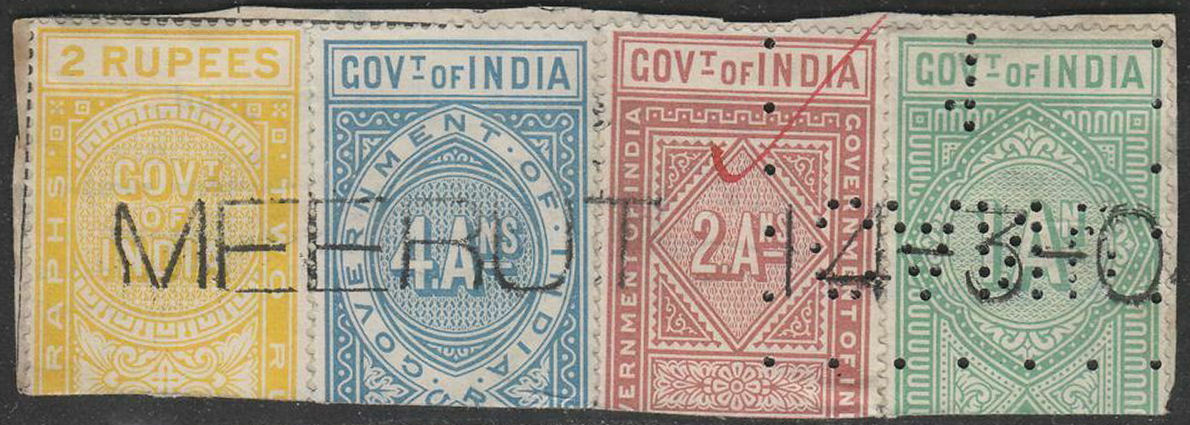
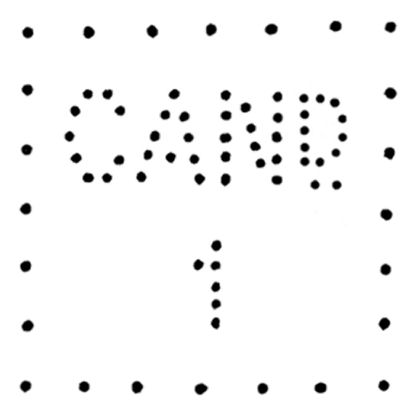
This was used in Meerut, United Provinces (Northwest Uttar Pradesh, near Delhi) probably in 1904 (like most of the batch it was with).


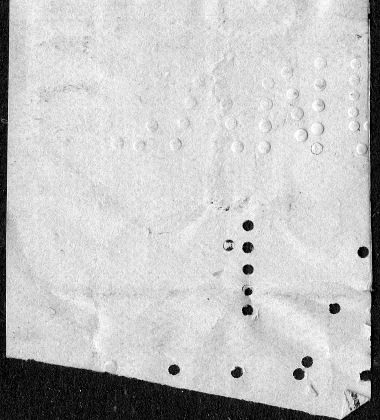

This was used in Poona (near Bombay) on 15 January 1903. Also, at an unknown date Poona apparently used number 9 (see below).
2


This was used in Rawalpindi, near Murree in north Punjab but undated.
Another Rawalpindi example is shown below with an unboxed CAND 11.

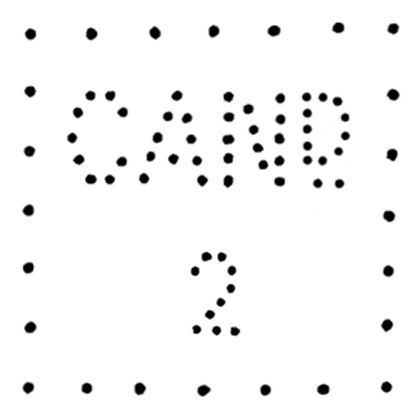
This was used in Ootacamund (now Udagamandalam, Tamil Nadu), was the summer capital of the Madras Presidency and near Wellington Cantonment and south of Mysore. Used 9 March 1904.
3
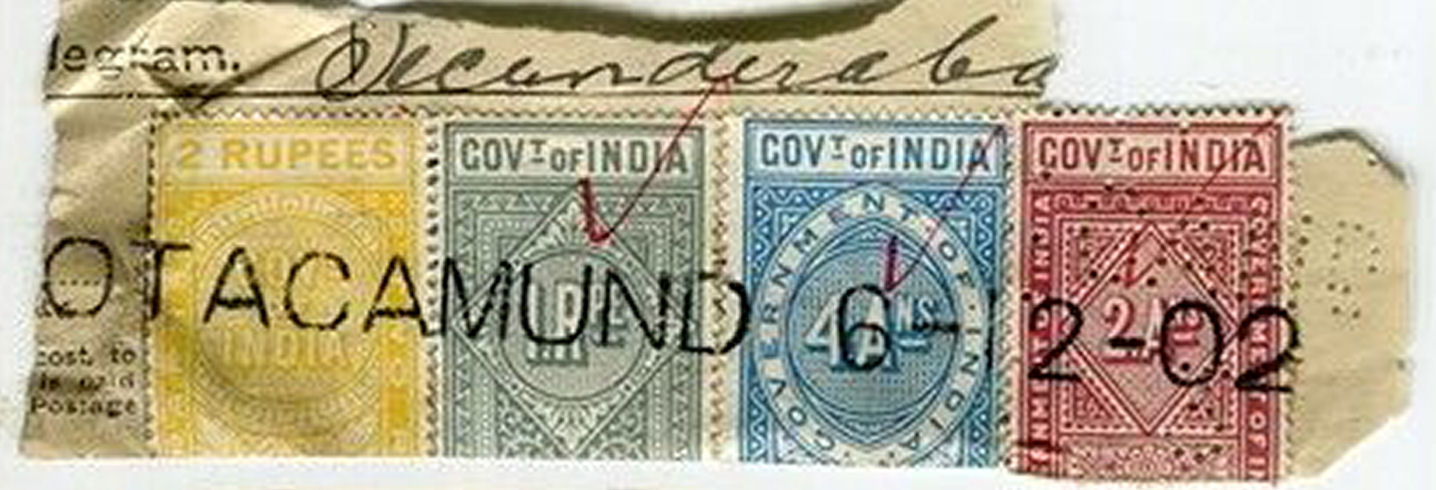
Another one used in Ootacamund, this on 6 December 1902 but with a boxed number ' 3 '. Image courtesy of Simon Scott of Scott Philatelics
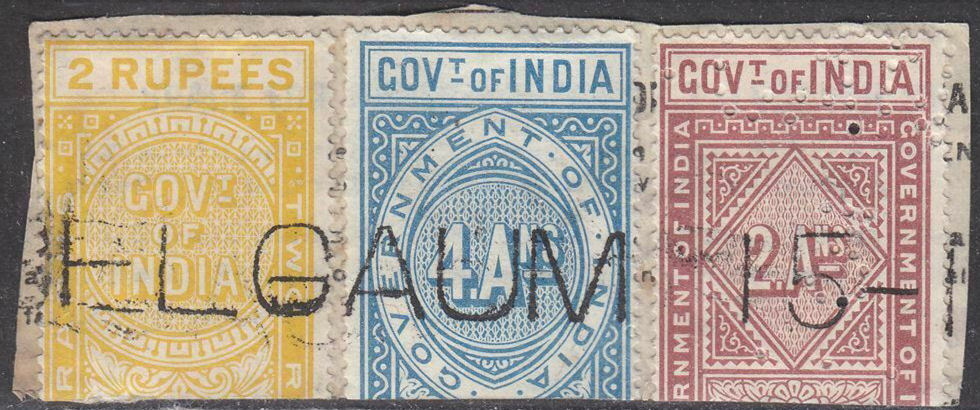
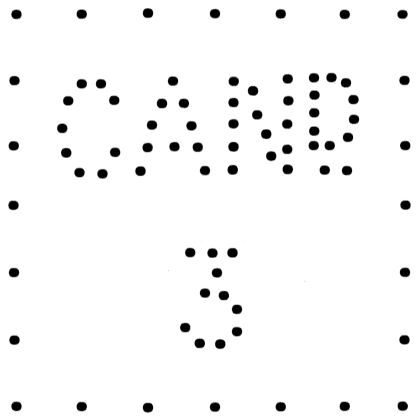
Used in Belgaum (near Goa) in the state of Bombay with boxed perfin of Cand / 3
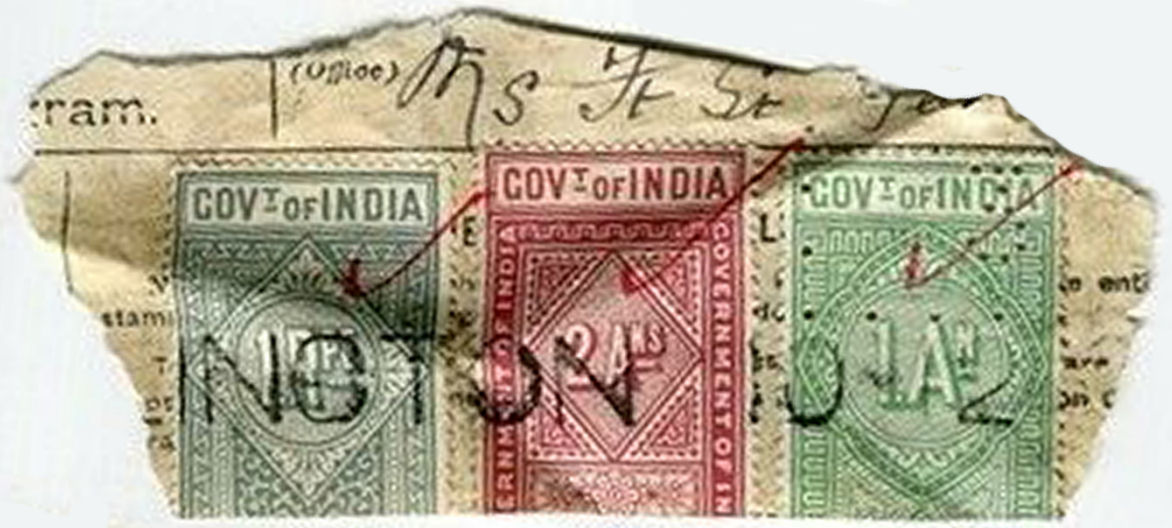
This is probably Wellington, not far from Ootacamund mentioned above. Date unknown, but with a boxed number ' 3 '. Image courtesy of Simon Scott of Scott Philatelics
4

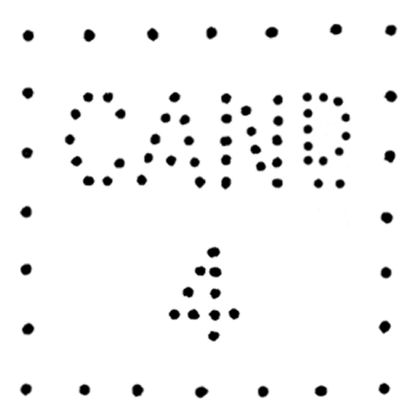
This was used in Masauli, Oudi (near Lucknow, United Provinces), now Pratapgarh district of Uttar Pradesh, on 2 February 1904.
The location of this seems to correspond to the current location of Lucknow Cantonment.
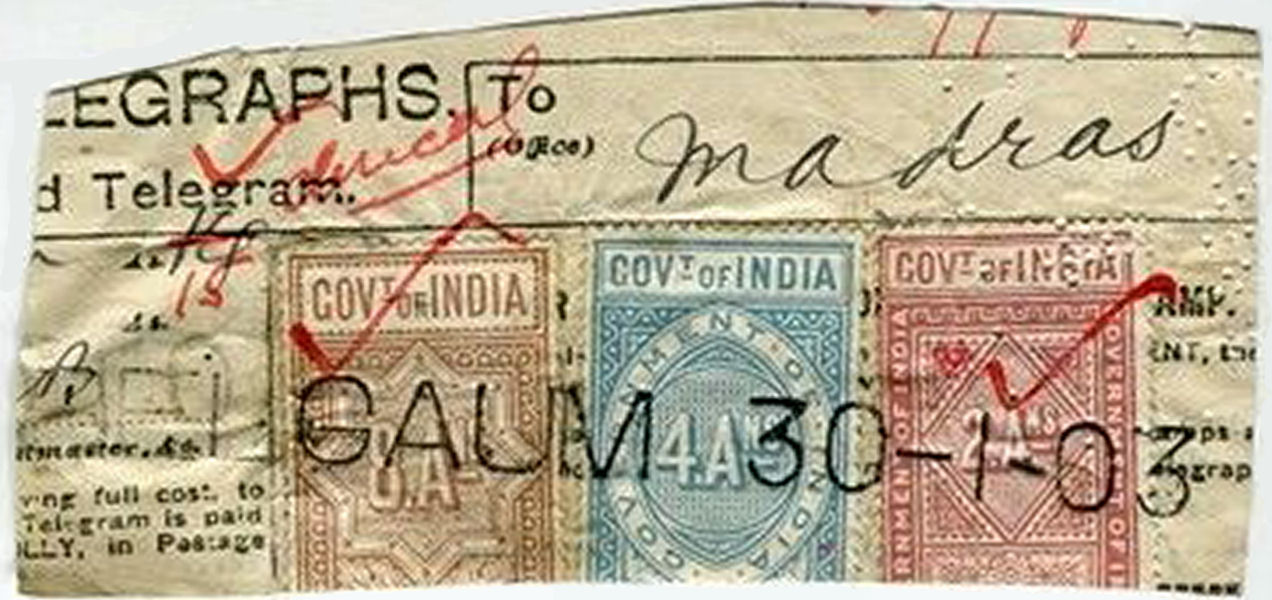
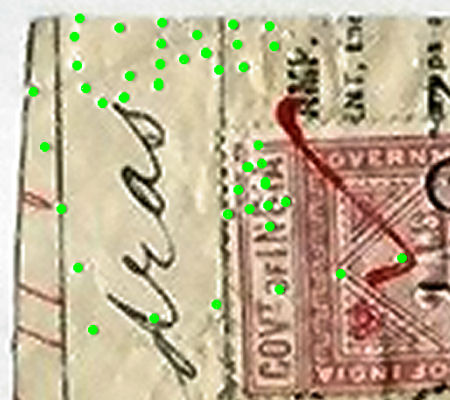
Another Belgaum (near Goa) as shown above, but this clearly dated 30-1-03, with a boxed number ' 4 '. Image courtesy of Simon Scott of Scott Philatelics
5
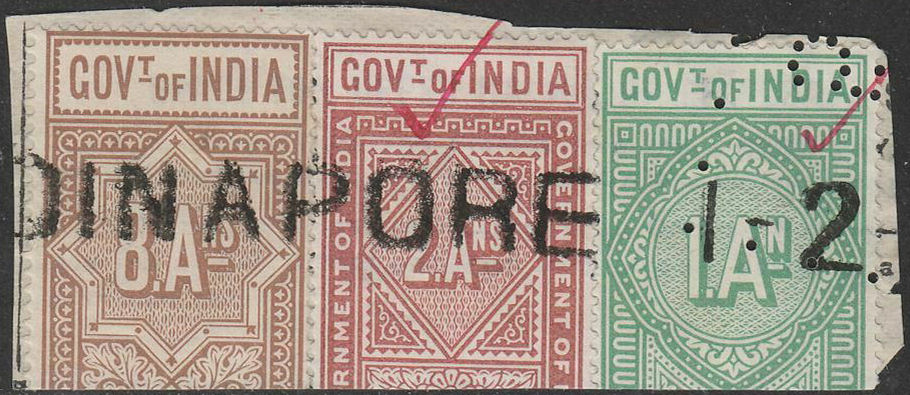
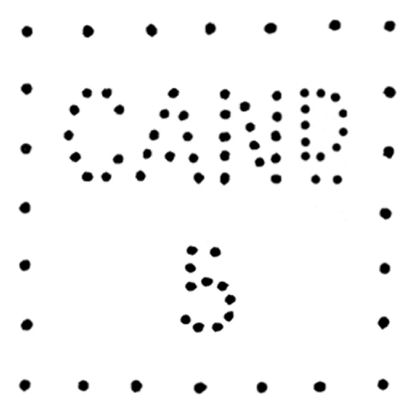
This was used in Dinapore (now Dinapur), Patna district of Bengal. Date unknown.
6
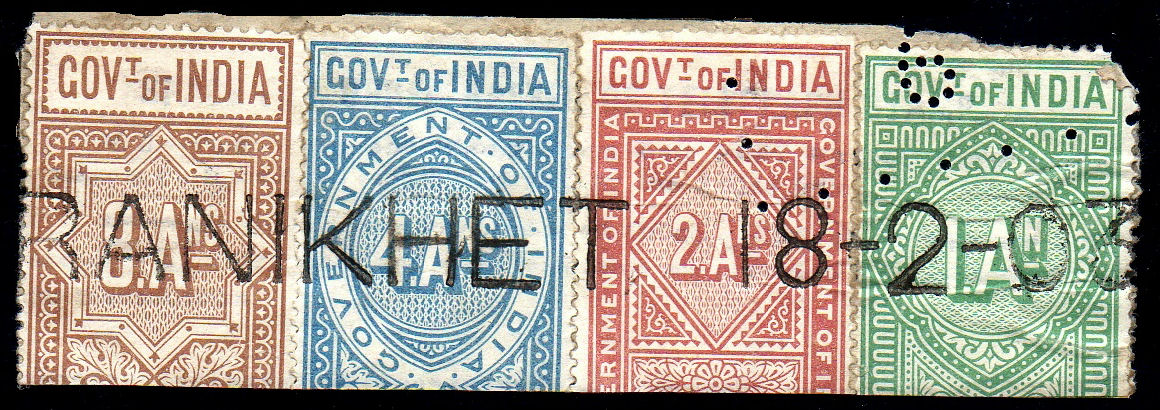
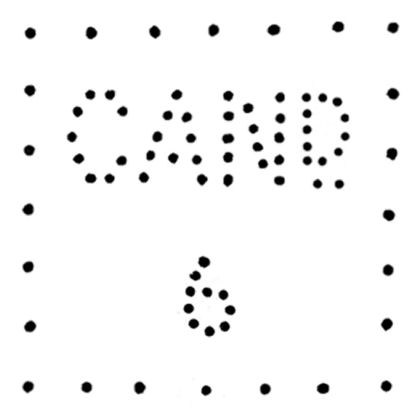
Ranikhet, United Provinces (Agra, now in Uttarakhand) on 18 February 1903 with a boxed perfin of 'Cand / 6'.
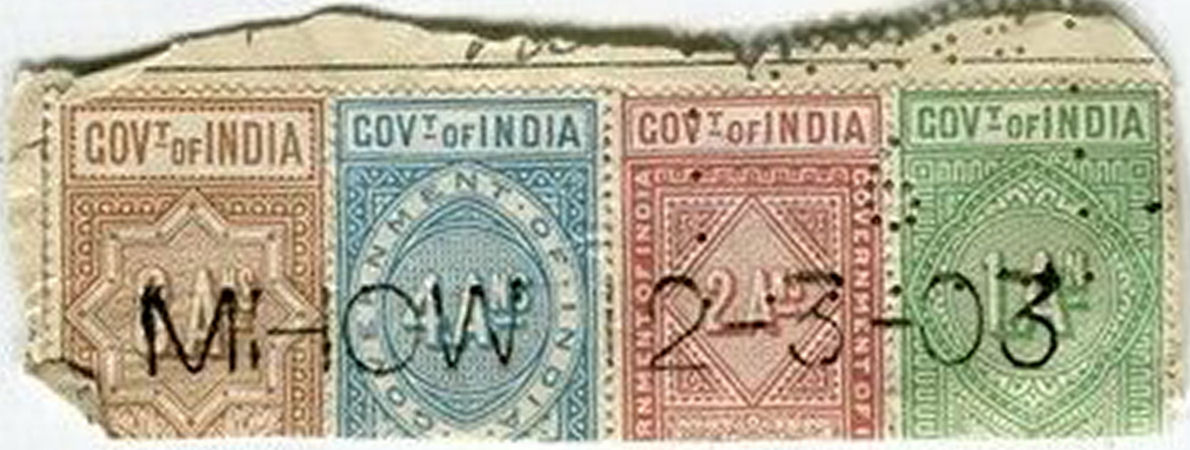
MHOW (Military Headquarters of War), near Indore is the Oldest Military cantonment in Central India. Used on 2 March 1903 with a boxed perfin of 'Cand / 6'.
Image courtesy of Simon Scott of Scott Philatelics
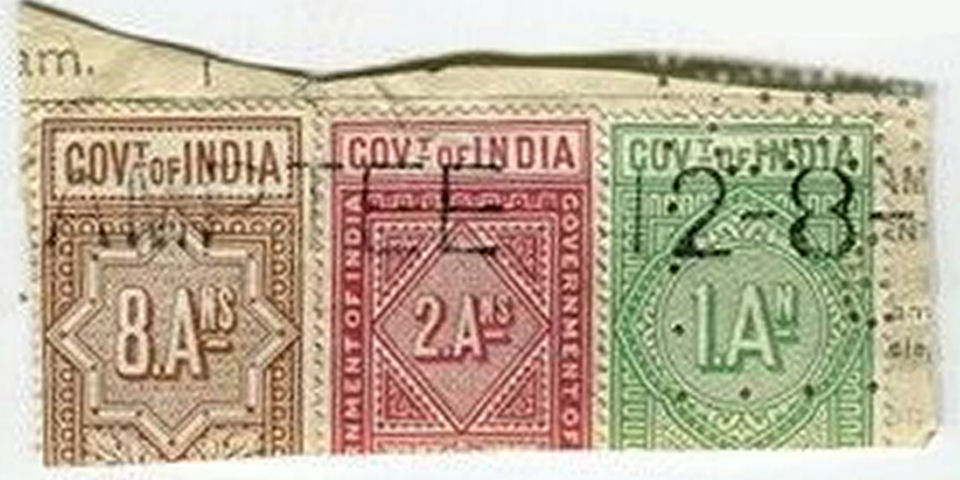
This is probably Kamptee, near Nagpur in Central Provinces. Year unknown, but with a boxed number ' 6 '. Image courtesy of Simon Scott of Scott Philatelics
7

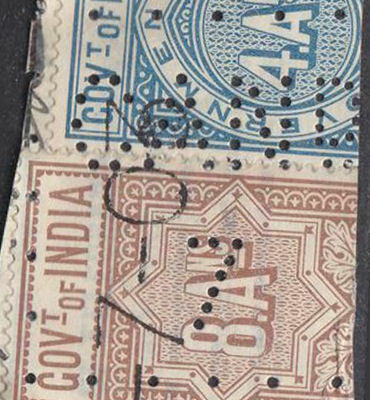
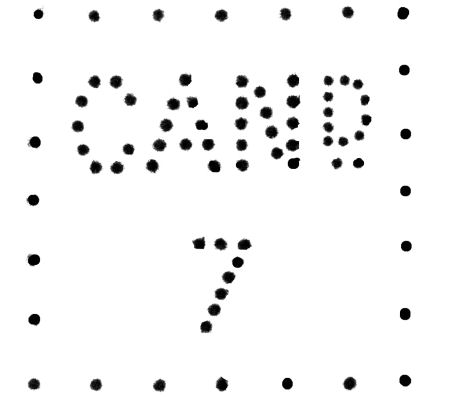
Murree (extreme Northeast Punjab), 3 July 1903 with a boxed perfin of "CAND/ 7".
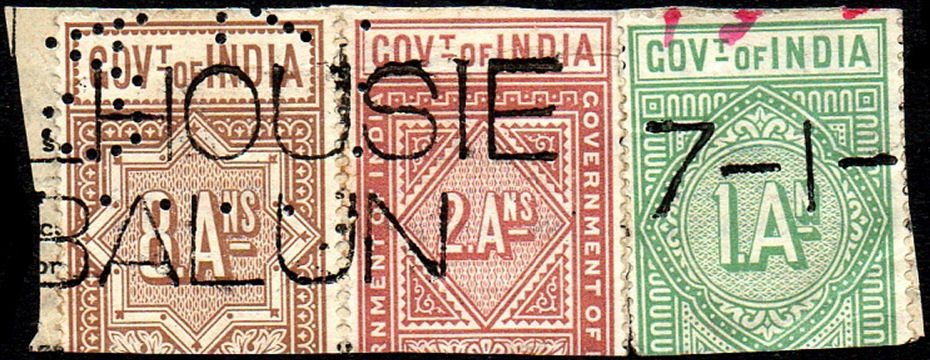
Another number 7, this used at Dalhousie Balun, Chamba, Punjab.
8

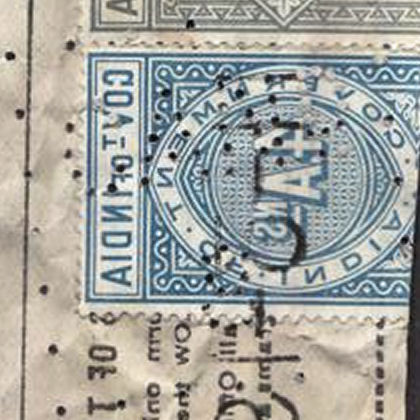
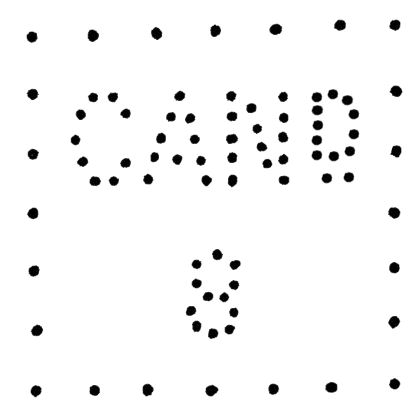
Kohat (Peshawar in the North West Frontier) 11 March 1902 with a boxed perfin of "CAND/ 8"
Bannu (Peshawar, to the southwest of Kohat) 16 February 1904, with a boxed perfin of '/ 8'.
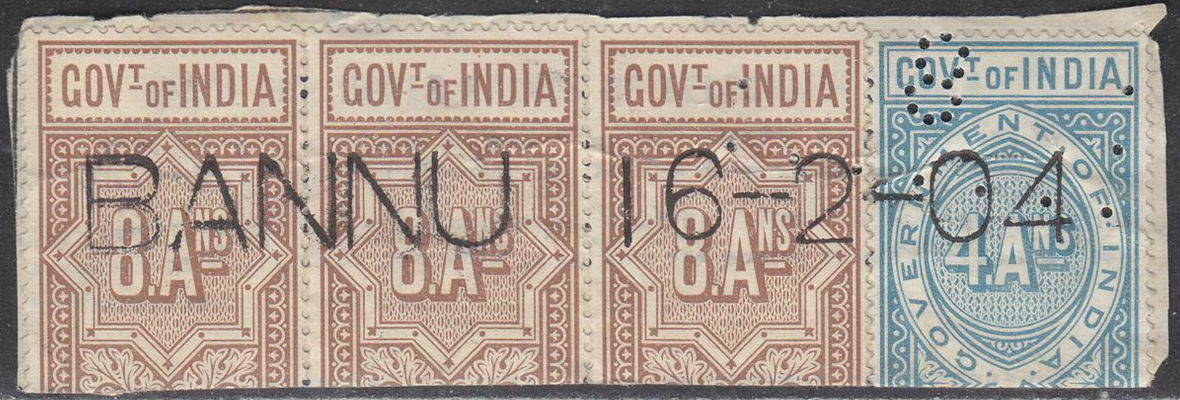
A very similar one used the next day.
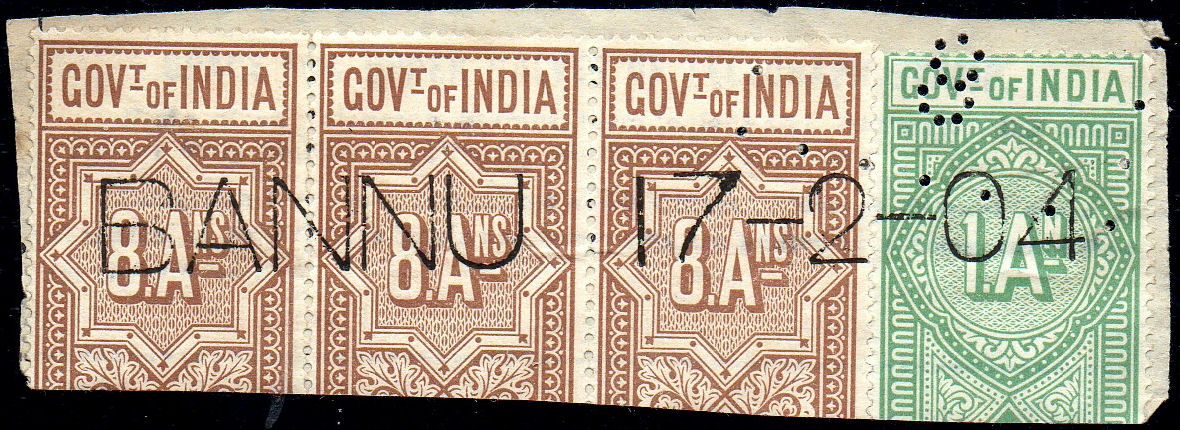
Bannu (Peshawar, to the southwest of Kohat) 7 January 1904 .
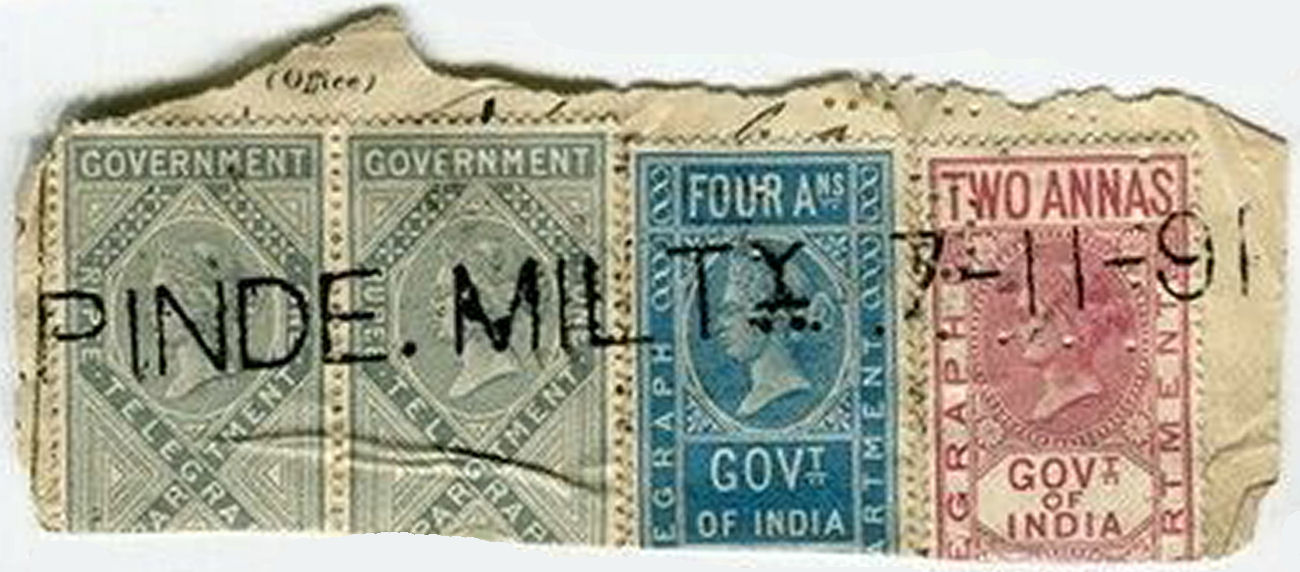
"...Pinde Military". I think that allowing for spelling variants, this is a fairly common ending for place names, perhaps even Rawalpindi (see below for a later one).
It's the earliest date that I have seen for these at 7-11-91, with a boxed number ' 8 '. Image courtesy of Simon Scott of Scott Philatelics
9

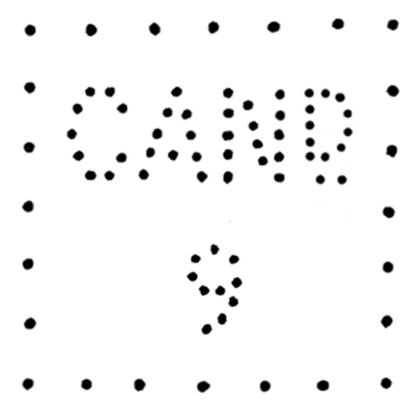
Quetta, British Baluchistan used 7 January 1904.
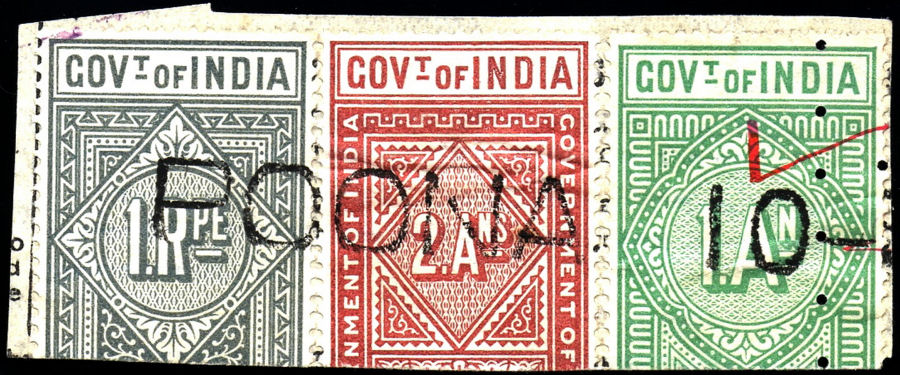

Undated Poona (near Bombay) with a (sideways)
boxed perfin. There is a single hole from the bottom of the digit, which best matches the position of '9' of Quetta above when overlaid.
One or two of the bottom holes don't quite line up though. I would expect that two places with the same 'code number' would be close together, but these are nearly 1000 miles apart.
It could be that the similarities are coincidental, but whatever digit it is would present similar problems, unless this is a '3' and Neemuch (see below) was actually a 2-digit number.
There could have been a '0', but that would be rather unlikely. More examples might provide more clues. There is no date on this example.
It is possible that the same code was used in different places at different times. Perhaps these were a kind of inspectors mark. I note that many of the stamps have a red tick mark, perhaps a group of auditors were
roaming the country checking that procedures were being correctly followed, each having a different perfin, but then, what would the "CAND" mean? "Cantonment Department" perhaps ?
I had assumed that it was "Cantonment District" but perhaps not.
10
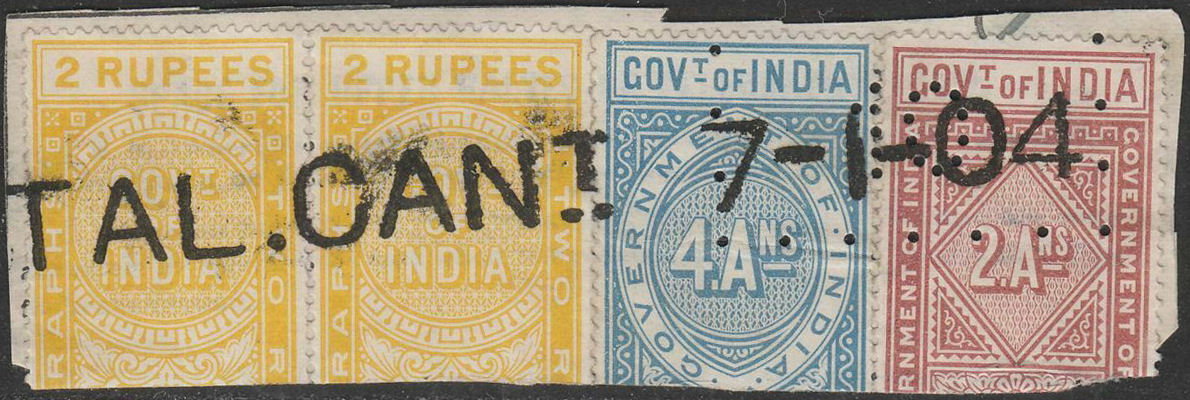
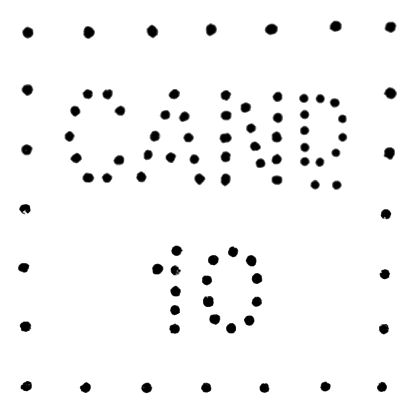
Probably Naini Tal Cantonment. Naini Tal was the summer capital of the United Provinces (Agra, now in Uttarakhand). This was used 7 January 1904.
Tal means lake in Nepali, so it could be another lake in Kumaon or other places near/in Nepal if they had a Cantonment. Not sure if Bhim Tal, Sat Tal or Naukuchia Tal did.
11
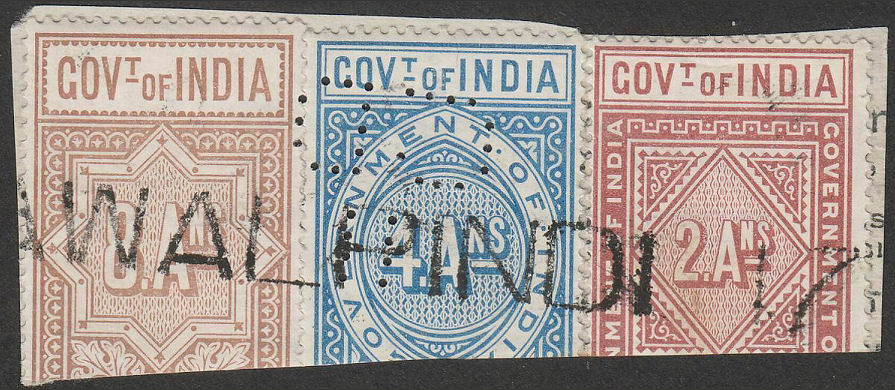
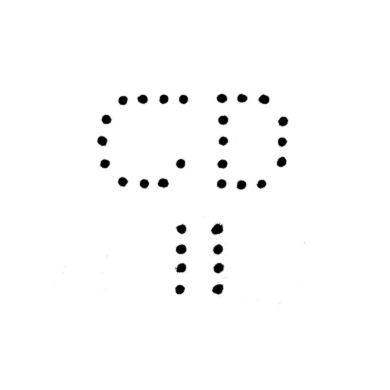
Rawalpindi, near Murree in north Punjab but undated. This is unboxed and a different style, but was in the same batch and appears to be related.
Rawalpindi is also known with CD2.
Unknown
A notice from T. D. Berrington, Director General of Telegraphs, dated 2nd March 1908 stated:
After the withdrawal of special Telegraph stamps on 1st April 1908, normal postage stamps were used for the purpose.
They can be recognised by distinctive cancels.
The above examples were chosen because they have reasonably clear cancels with little doubt about the initials at the bottom.
Unfortunately it is often not so clear. A badly printed "G" can look like an "S". Also "D" and "O" may be confused, and a broken "O" can look like a "C". Some examples to illustrate what I mean :
This Indian Telegraph cancel can be found on stamps of other countries.
| Shortcuts to different sections | |||||
| Burma | Kuwait | Afghanistan | Mesopotamia / Iraq | Tibet | Bhutan |
One from Akyab, Burma, this to Jaffna, Ceylon dated 12 October 1881.
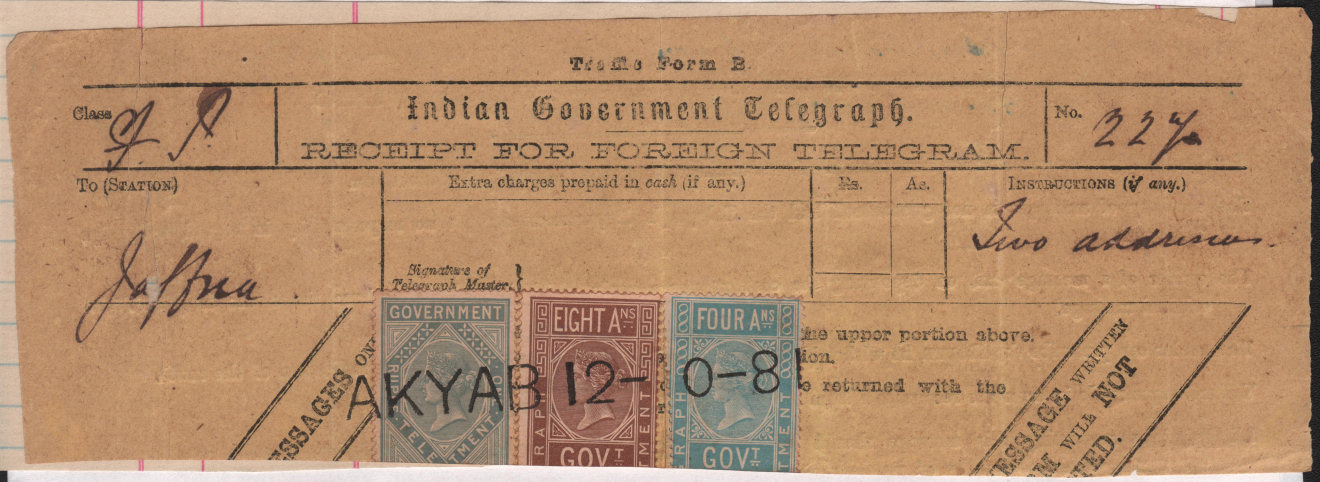
These are on a Traffic Form B receipt. The cost covers sending to two addresses. Image courtesy of Steven Zwillinger.
One from Rangoon, Burma, dated 31 August 1907.
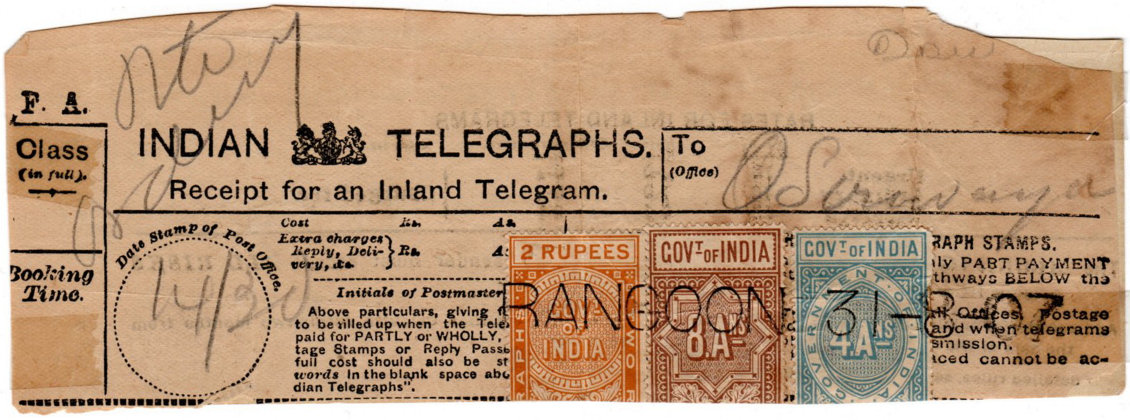
Image courtesy of David Sher.
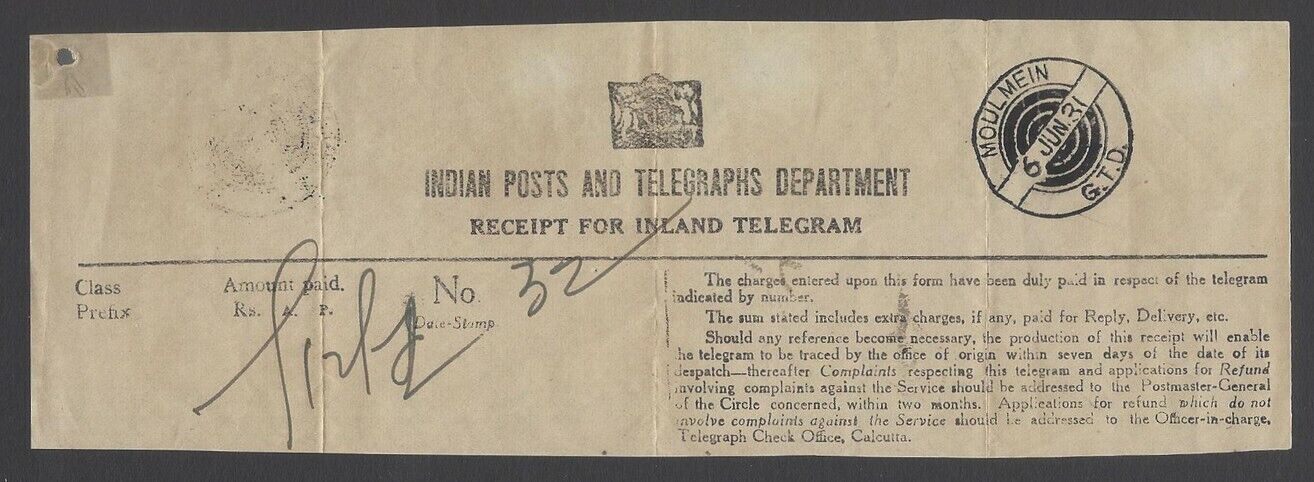
This was used in Moulmein, South Burma on 6 June 1931. Image courtesy of AlphaOmegaPhilately on eBay (click image for listing).
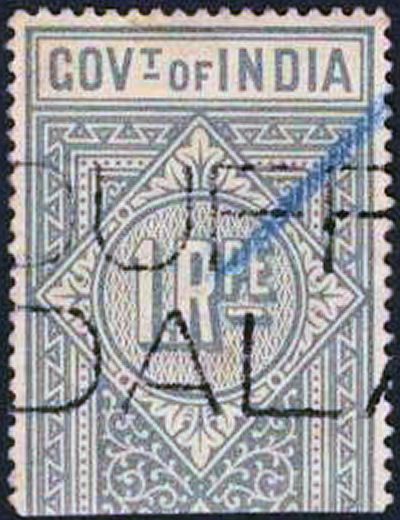
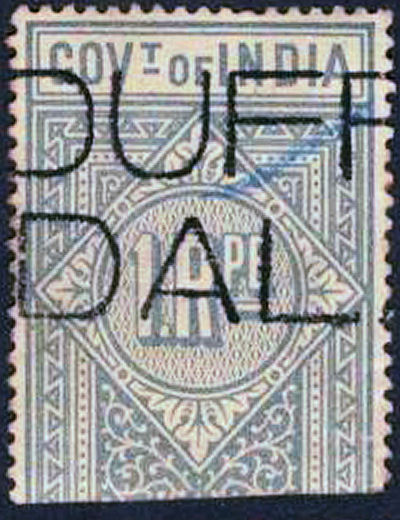
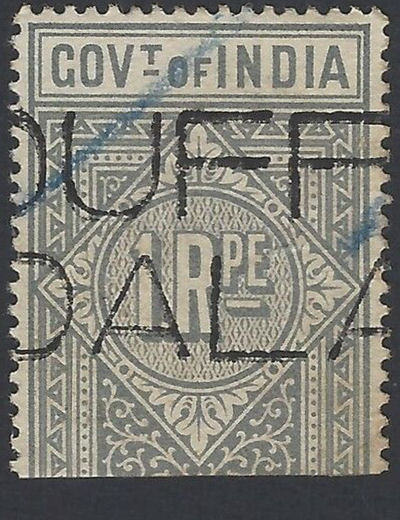
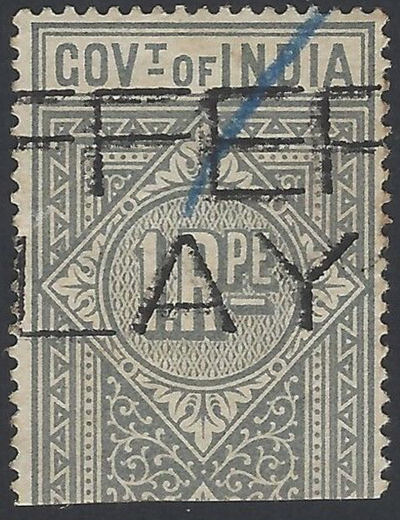
FORT DUFFERIN / MANDALAY in two lines. This was in British Burma. Image courtesy of AlphaOmegaPhilately on eBay (click image for listing).
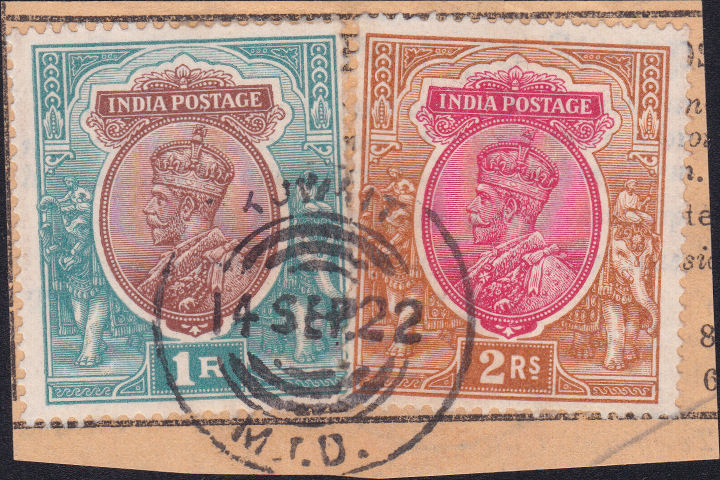
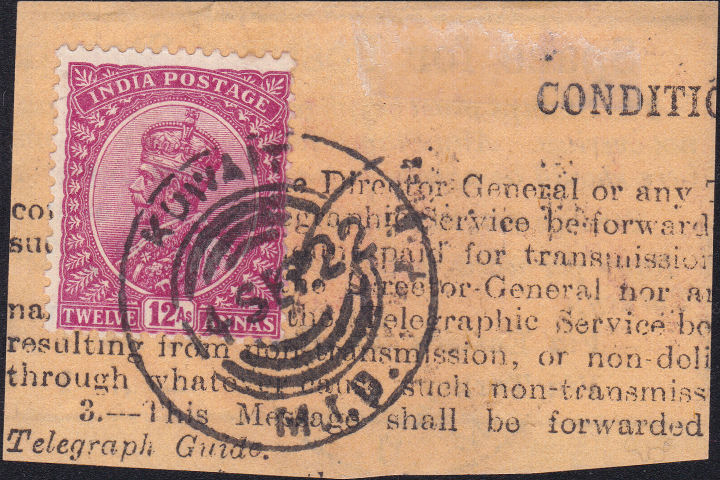
Front and back of a Telegraph piece used in Kuwait in 1922.
I suspect that 'M.T.D.' stands for 'Military Telegraph Department', can anyone confirm or deny ?
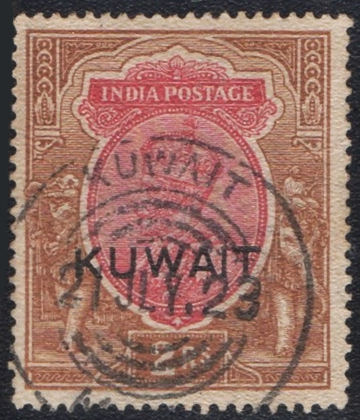
A year later with a 'KUWAIT' overprint. These are typically on higher denomination stamps.
Similar items can be found for Burma, Pakistan and I'm sure more places.
No Form number, but marked "Indian Telegraph" and "Receipt for Inland Telegram".
Marked Class = "State" and sent from Kandahar, Afghanistan on 2 January 1880, to Quetta, British Baluchistan.
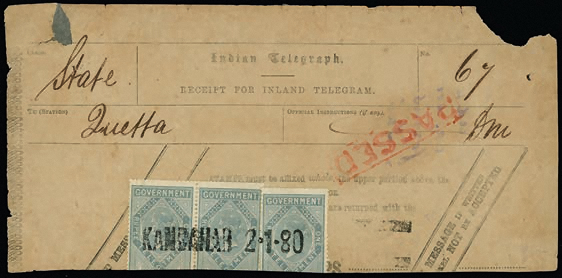
This was used during the Second Anglo-Afghan War, hence the red "PASSED" mark.
Image courtesy of Stanley Gibbons (Lot 52 of Sale 5938 of 22nd November 2022).
No Form number, but marked "Indian Telegraph" and "Receipt for Inland Telegram". Only 3 months after the last, but a very different form.
Marked Class = "State" and sent from Kandahar, Afghanistan on 14 April 1880, to Nari Gorge, also in British Baluchistan.
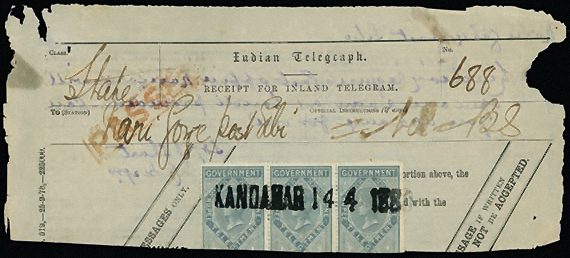
This was used during the Second Anglo-Afghan War, hence the red "PASSED" marks
Image courtesy of Stanley Gibbons (Lot 53 of Sale 5938 of 22nd November 2022).
Magil (corruption of Al Ma'qil), near Basra, was occupied in 1916 to protect British oil installations.
Images courtesy of Andrew Higson.
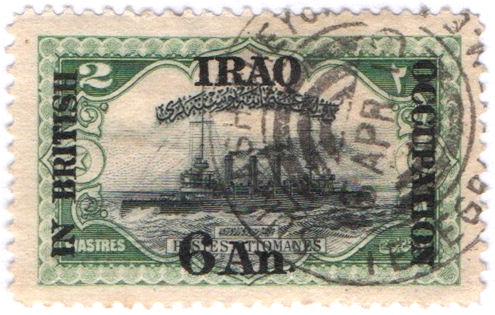
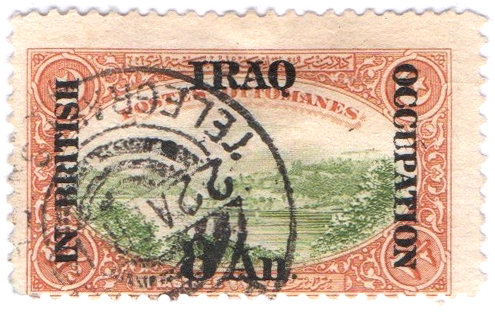
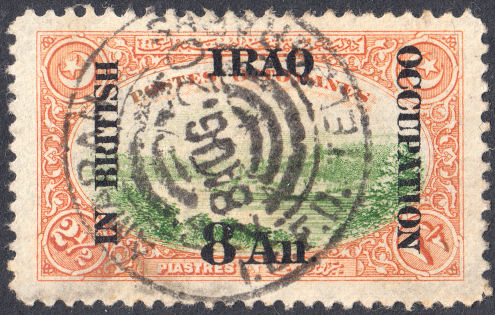
Indian cancels on Iraq stamps. The British Occupation overprints are on Turkish stamps
as the area had been Mesopotamia, part of the Ottoman Empire up until the first World War. The British had re-named it Iraq.
The 6An and left-hand 8An, courtesy of Les Bottomley, are dated in April 1919 and have normal cancels. The right 8An is dated 28 August 1920, with IEFD, a year in which
Indian troops had been needed to suppress a rebellion against British rule.
The cancel on the right 8An is inscribed AMARAN / I. E. F. D. TELEGRAPHS
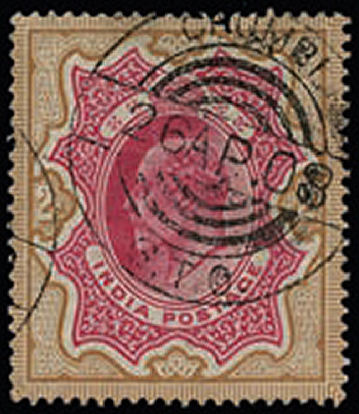
Used 26 April 1903 in Chumbi, Tibet.
Image courtesy of Stanley Gibbons (Lot 817 of Sale 5938 of 22nd November 2022).
Bhutan is a bit of a special case. Historically it had been very much "off the grid", but political pressure to change prompted the king to modernise the country.
10th October 1962 brought the opening of the Postal Service in Bhutan, with the Department of Posts and Telegraphs being placed under the Ministry of Communications.
Telegraph forms of India were used.
A sending form A, sent from Phuntsholing to Calcutta, 16 May 1969. The charge in local currency (not Rupees) was 6Nu90 written at top-left, for 23 words.
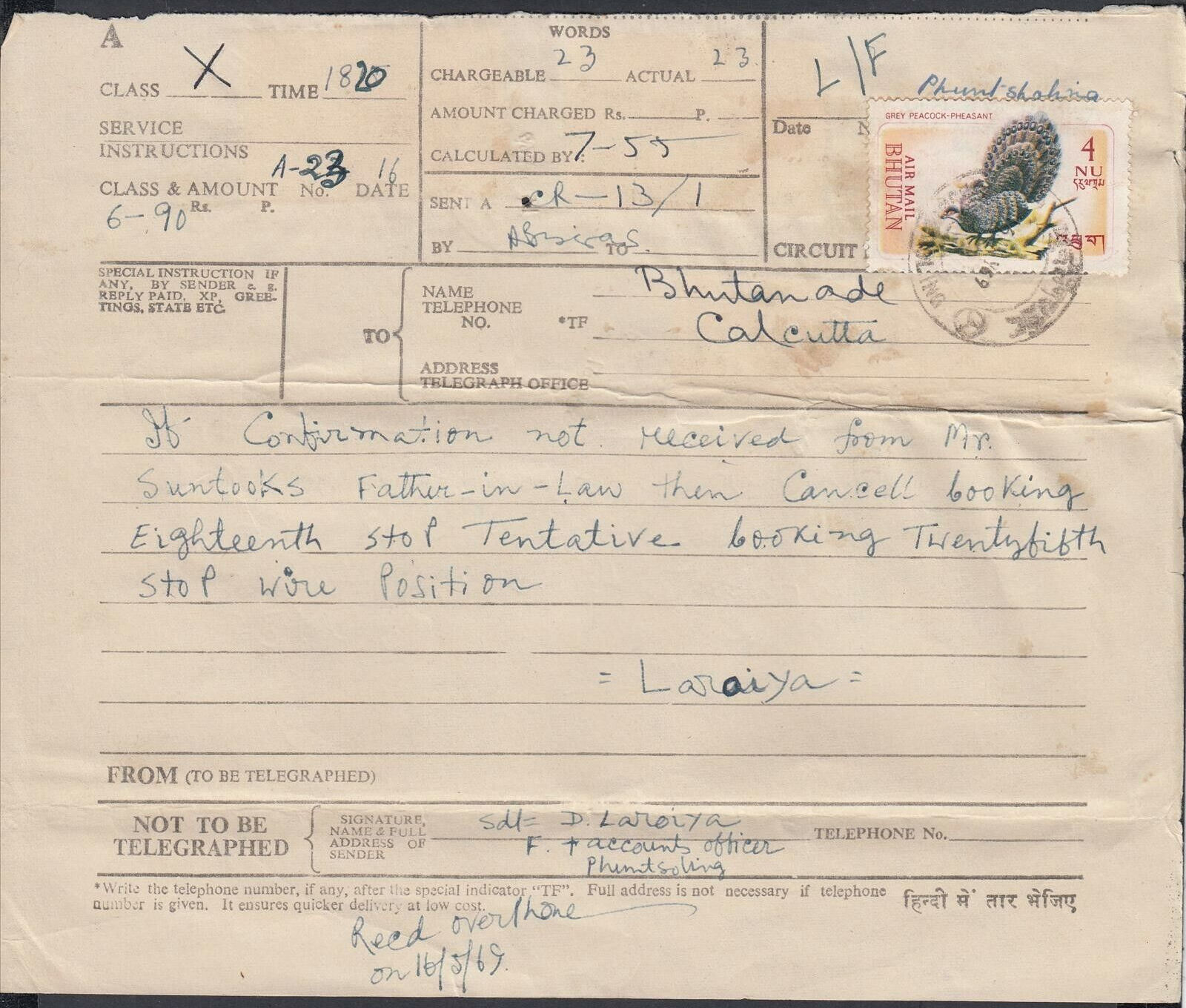
The front has a 4Nu postage stamp, the rest is on the back, shown below.
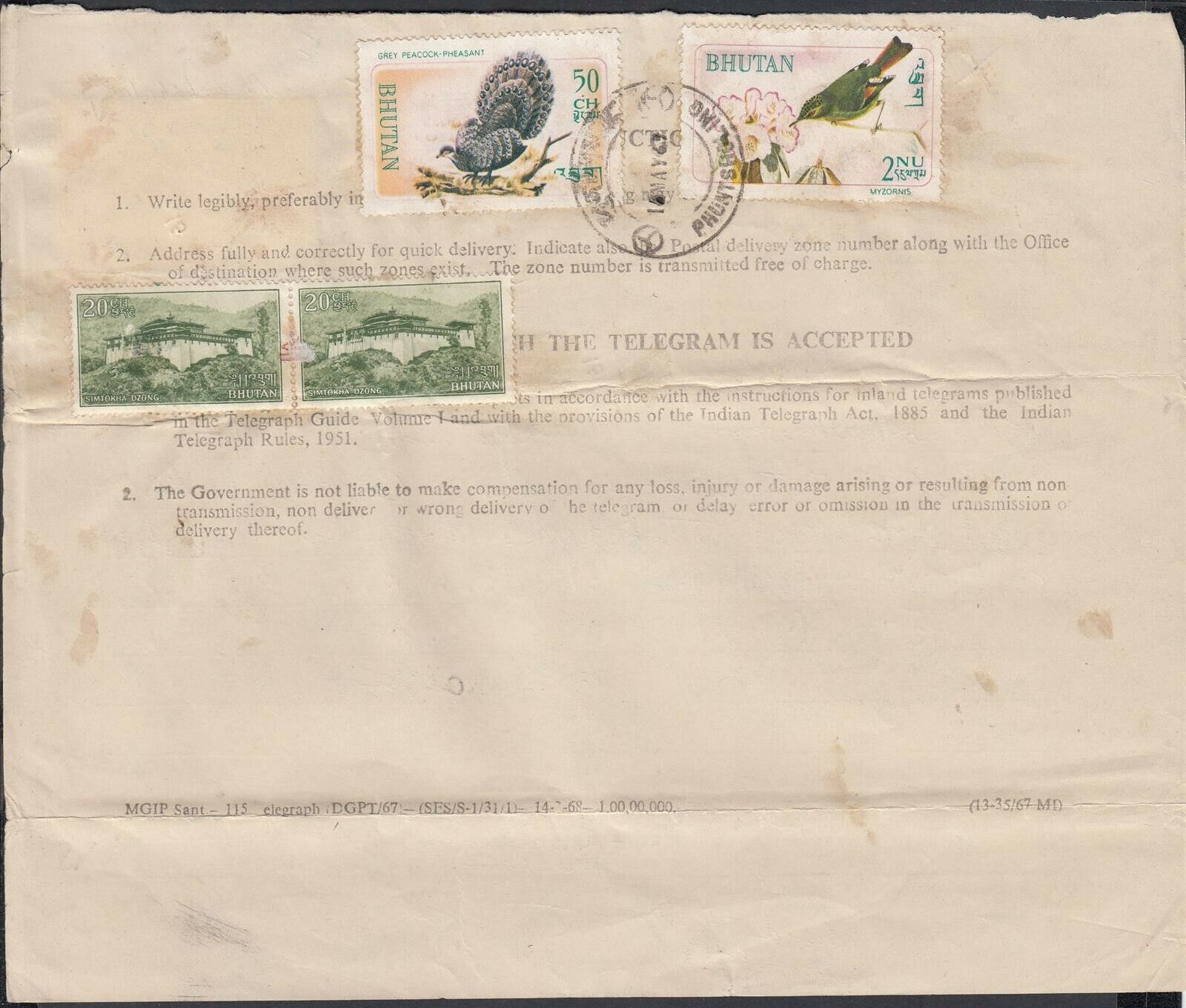
The back refers to "... provisions of the Indian Telegraph Act, 1885 and the Indian Telegraph Rules, 1951".
Images courtesy of vgstamps2015 on eBay (click an image for listing).
A couple more telegraph forms used in Bhutan are shown on the Miscellaneous page.
Queen Victoria double headed issue (date and watermark unknown) Illustrated by C.S.F.Crofton (1905).
Handstamped "ON THE PUBLIC SERVICE ONLY" known (so far) on 8As and 10R only.
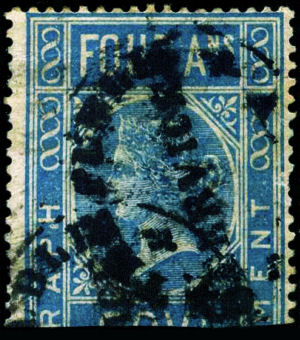 |
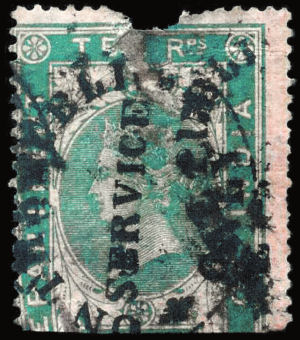 |
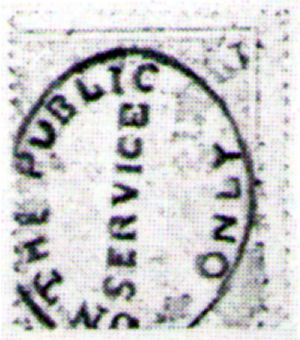 |
| RH70 Lot 134. | RH71 Lot 135. | Type 57 from Hiscocks' book Pg165 |
RH70 and RH71 are from the Indica Collection Auction (28 September 2021) of Stanley Gibbons (available as a PDF download)
These examples both have multiple strikes, making them appear to be cancels rather than overprints.
Hiscocks' illustration appears to be taken from the 10R example. It may be that there are no other examples.
I would really like to hear from anyone with another example, or further information on these.
| RH # | Hisc. | Description | Mint | Used |
|---|---|---|---|---|
| RH70 | - | 4A blue | - | - |
| RH71 | H69 | 10R bluish green | - | - |
1908(?) Stamps of 1904 overprinted 'OHMS' in black.
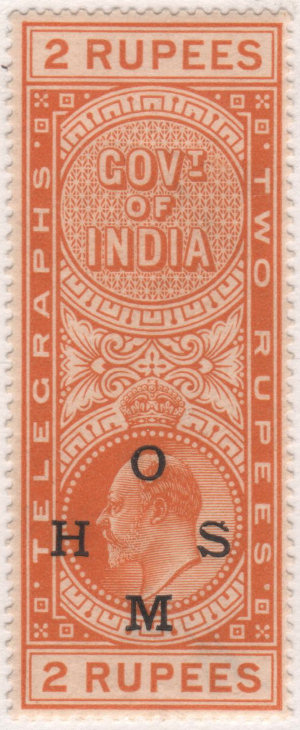 |
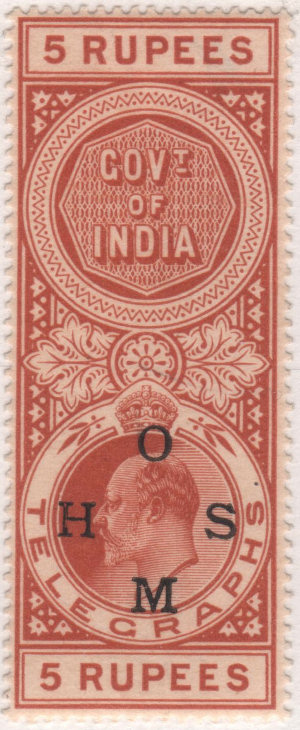 |
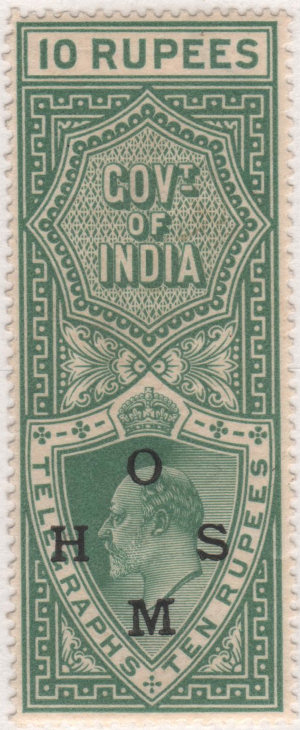 |
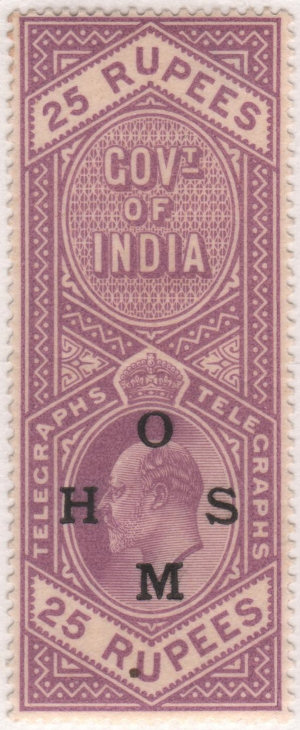 |
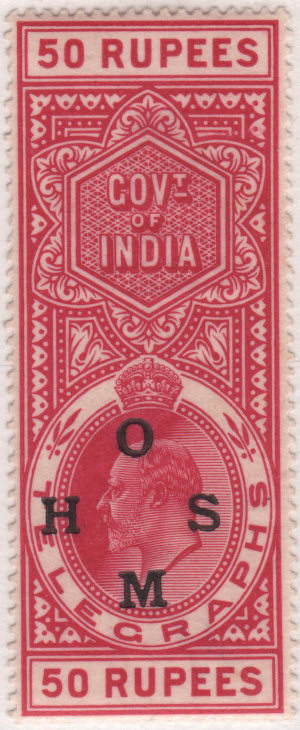 |
| RH72 to RH76 courtesy of Steven Zwillinger. | ||||
| RH # | Hisc. | Description | Mint | Used |
|---|---|---|---|---|
| RH72 | H70 | 2R brown-orange (40,800) | 50.00 | - |
| RH73 | H71 | 5R orange-brown (10,000) | 50.00 | - |
| RH74 | H72 | 10R bluish green (2,400) | 75.00 | - |
| RH75 | H73 | 25R bright lilac (2,000) | 100.00 | - |
| RH76 | H74 | 50R carmine (800) | 150.00 | - |
Hiscocks added the following note:
| Note. There is no evidence that these stamps were ever actually used although the upper halves are in fact the same as normal stamps and lower halves might all have been destroyed in the usual way. |
A Form F. A. telegraph receipt from Patiala to Atari in the Punjab dated 14-11-88.
It has an attached 'MEMO' with the same datestamps and the words "This telegram being addressed to a place where there is
no Government Telegraph Department Station, is accepted under Inland Rule 20 for transfer to the Railway Telegraph."
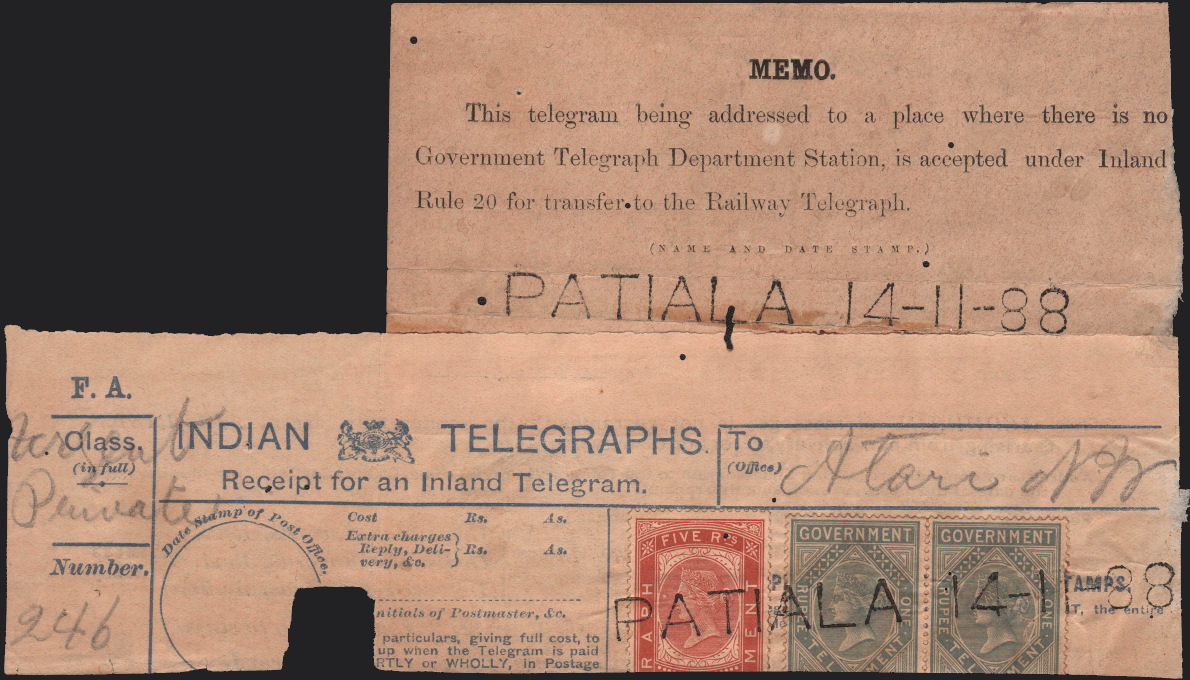
I had assumed that, as in most countries, the Railways and Telegraphs were intimately connected, but in India the Government Telegraph
system was organised at a time when the railways were just getting off the ground as a private venture. According to
this infrastructure web-page
the Government bought all the railway tracks at the beginning of the 20th century. Clearly though the Railways had their own Telegraph System independently.
Anyone know anything about that ?
This was sent as Urgent Private class, twice the normal rate. The 7 Rupees would have paid for 72 characters plus 4 words.
Image courtesy of Steven Zwillinger.
Madras Police Department.
Purple handstamp with "Madras Police Dept."
Clearly it pre-dates the Edwardian ones listed below.
Rather than being much earlier, I suspect these were old stock being used up before the normal issue.
This stamp is now part of the Stanley Gibbons Indica Collection Auction (Lot 188).
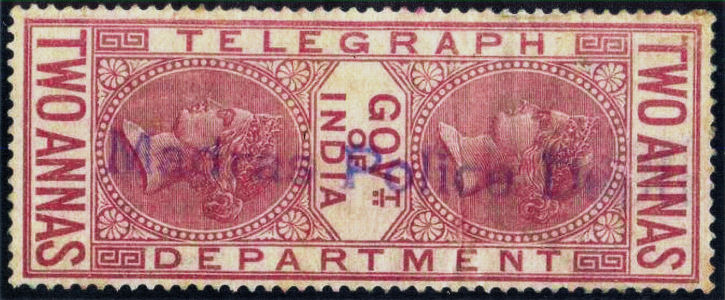
RH78 courtesy of Stanley Gibbons.
| RH # | Hisc. | Description | Mint | Used |
|---|---|---|---|---|
| RH77 | - | 1A (No. 32?) | - | - |
| RH78 | - | 2A (No. 33?) | - | - |
| RH79 | - | 4A (No. 34?) | - | - |
| RH80 | - | 8A (No. 35?) | - | - |
| RH81 | - | 1R (No. 36?) | - | - |
Bombay Police Department.
Hand-stamped in various colours "BO. POLICE DEPTT" (Type 59)
(Reading up or down.)
Victorian issue (old stock being used up first ?)
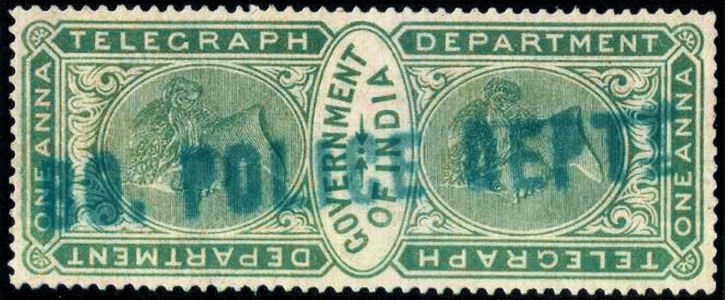
RH82 - lot 186 of Indica Collection, late September 2021. Courtesy of Stanley Gibbons
Edwardian issue.
The listing of the Indica Collection Auction (28 September 2021) of Stanley Gibbons mentioned above is available as a PDF download
The more recent (currently pending) Stanley Gibbons Auction (Sale 5938 of 22 November 2022) is also available as a PDF download.
Hiscocks added the following 2 notes:
| Note 1. The status of these stamps is obscure. I have seen no evidence of their actual use but it is quite possible that both halves were officially destroyed after use. They may however have been trials. |
| Note 2. Those priced above I have seen and Nos. 75, 76 and 77 have been reported. A somewhat vague description in a 1972 auction catalogue adds the 1R value but the hand-stamp colour is not given. I have surmised that complete sets of the 1904 issues to 1R were done in all these colours and that the earlier stamps were done at the same time (1904 or later) using old stock which happened to be available. Further information is needed. |
Overprinted "BOMBAY / POLICE DEPARTMENT." upwards in black.
The colour images above are from lot 342 of the listing of the Indica Collection Auction (28 September 2021) of Stanley Gibbons available as a PDF download
Colour images courtesy of Stanley Gibbons
| RH # | Hisc. | Description | Mint | Used |
|---|---|---|---|---|
| RH105 | H93 | 1A (No. 56) | - | - |
| RH106 | H94 | 2A (No. 57) | - | - |
| RH107 | H95 | 4A (No. 58) | 125.00 | - |
| RH108 | H96 | 8A (No. 59) | 125.00 | - |
| RH109 | H97 | 1R (No. 60) | 125.00 | - |
| RH110 | H98 | 2R (No. 61) | 125.00 | - |
Hiscocks added the following note:
| Note.
Note 1 above again applies and again only those priced have been seen and the others assumed to exist. Both the No. 75-92 and the No. 93-98 series could, of course extend to higher values. |
Central Provinces Police Department.
Overprinted similar to above, but for the Central Provinces Police Department.
The colour images above are from lot 343 of the listing of the Indica Collection Auction (28 September 2021) of Stanley Gibbons available as a PDF download
Colour images courtesy of Stanley Gibbons
| RH # | Hisc. | Description | Mint | Used |
|---|---|---|---|---|
| RH111 | H99 | 1A (No. 56) | 150.00 | - |
| RH112 | H100 | 2A (No. 57) | 150.00 | - |
| RH113 | H101 * | 4A (No. 58) | 150.00 | - |
| RH114 | H102 | 8A (No. 59) | 150.00 | - |
| RH115 | H103 | 1R (No. 60) | 150.00 | - |
*H101 was actually omitted from the catalogue, it jumps from 100 to 102.
I have assumed it was a typo and that the 4A was intended to be there.
Hiscocks added the following note:
| Note. Nos. 99-103 were sold in a Robson Lowe auction on 28 March 1974. I have seen no other reference to them. |
and also:
| General Note.
Early literature refers in general terms to other semi-official overprints. I have found no specific evidence of these and would welcome information. |
Some used examples courtesy of Steven Zwillinger:
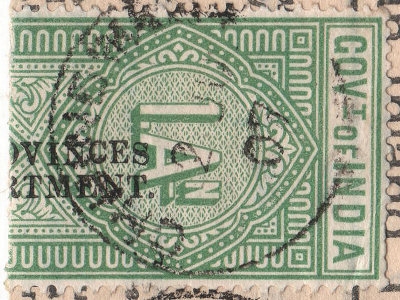 |
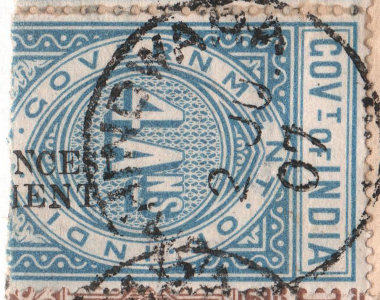 |
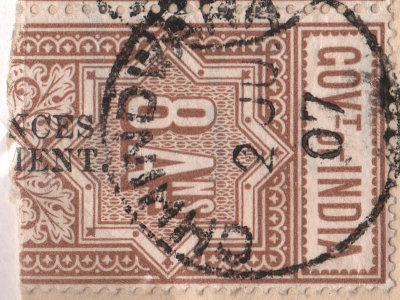 |
He has two examples of receipts using these stamps:
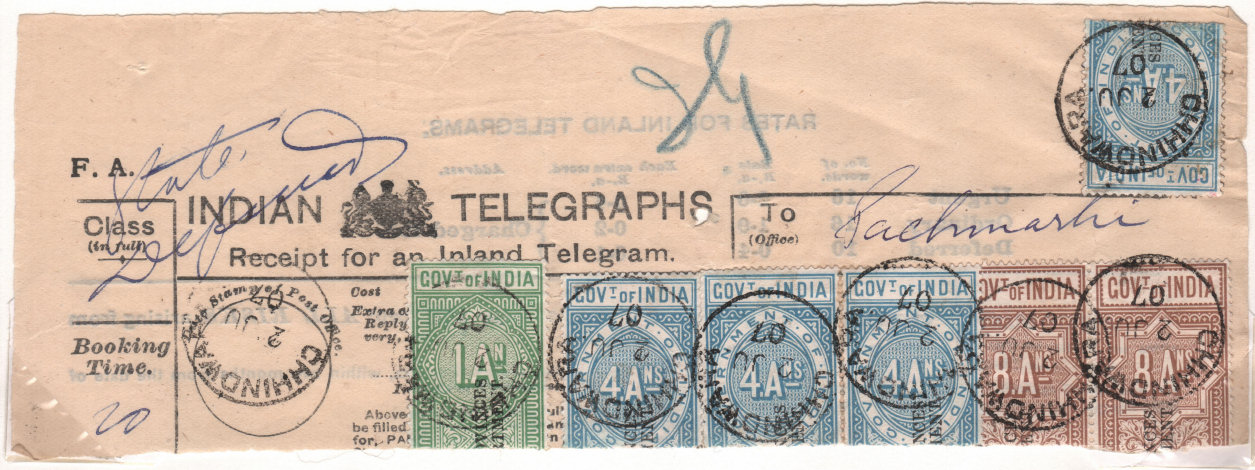
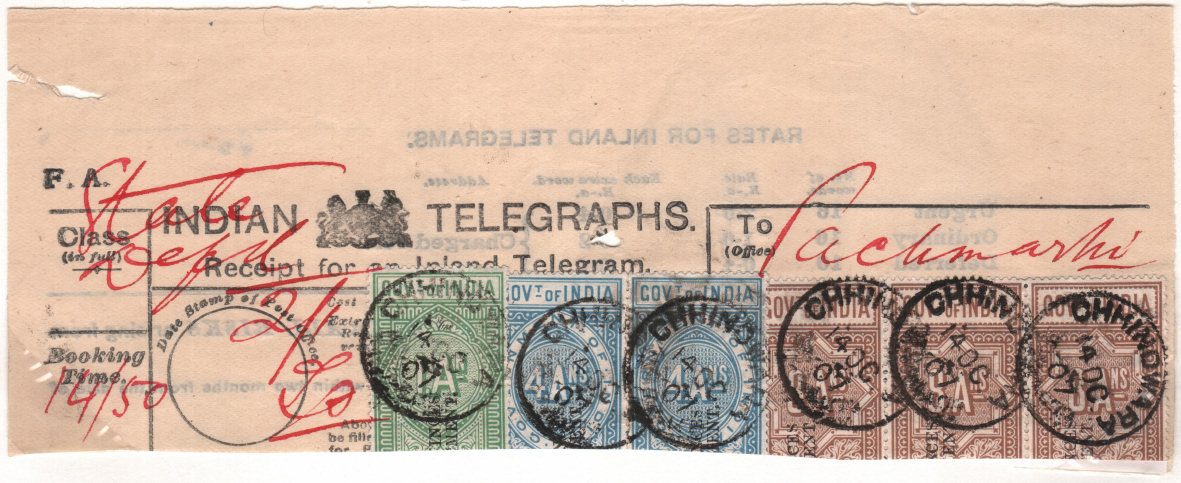
These are both official use on F.A. forms marked with Class of 'State Defd' (Defd standing for Deferred, low priority) with Postal cancellations of 1907.
They are also both from Chhindwara to Pachmarhi with 33 annas charged for 33 words. The top is dated 2 June 1907, the bottom is dated 14 October 1907.
Chhindwara was in an area called "Central Provinces" at the time.
These images of used examples are all courtesy of Steven Zwillinger.
Steve Hiscocks wrote:
|
Telegraph lines from Srinagar to Jammu and to Gilgit were constructed according to a treaty of 1878 between the State Government and the Government of India. The lines were later extended along the State Railway lines according to a further treaty of 1890. The first telegraph stamps were locally produced in sheets of 60 by multiple hand stamping with a single die for each value. An issue date of 1884 is usually accepted although a date of around 1880 might seem more probable. The design consists of the arms of the State with military supporters, the denomination in Persian script and "Jammu Kashmir Tibet Telegraphs" in Dogra (the local script): the "Tibet" referred to Ladakh which was then known as 'Little Tibet'. In use these stamps were bisected, as were those of the Government of India, and cancelled in manuscript or with an oval stamp in black or purple. Used copies, especially on piece, are very rare. It has been reported that many postage stamps were used in parallel with the telegraph stamps and in fact almost superseded them but postage stamps so used have not come to light and there is some doubt about this In 1896 it was decided that the Government of India 'double stamp' system should be adopted and essays were received from de la Rue. Designs and colours were agreed in January 1897 (not 1903 as given in some catalogues). The first consignment was on plain paper and later consignments were on watermarked paper. In May 1910 the regulations were changed such as to permit the use of 'single' stamps and de la Rue undertook to prepare designs from the upper halves of the previous issue . These were agreed in September 1910 and consignments sent out from July 1911 to March 1929 or perhaps a little later. A new design depicting the ruler, Sir Hat Singh, and based on a current revenue stamp was ordered in 1932 and produced in late 1933. They were presumably issued in 1934. At some unknown date, possibly around 1941, a further change of design occurred and stamps were printed locally or possibly by the Indian Government Security Printing Press at Nasik Road. The design is rather similar to that of the previous issue but with an altered frame. Both of the 'Sir Hari Singh issues' are very rare. It is not known for certain when the use of Kashmir telegraph stamps ceased. They were still in use in 1948 and it seems probable that the Jammu and Kashmir Telegraph system was absorbed into the Indian system with the abandonment of the use of telegraph stamps, on 1 April 1950 when most State Postal Systems were taken over. One mystery remains. A UK collector has seen a stamp similar to the last issue described above but with the word 'WIRELESS' in place of 'TELEGRAPH'. It is not known whether this is a telegraph stamp or some sort of revenue stamp — perhaps for the payment of a radio tax. |
My notes:
The treaty of 1878 follows the erection of the line between Gilgit and Srinagar in 1877 by the Indian Telegraph Department, on behalf of the Maharaja of Kashmir.
Perhaps surprisingly, Steve's introduction makes no mention of the many Provisional overprints. I have tried to replace his black and white
images with colour ones and have done that for quite a few, but not all. I have in the process found new ones, which suggests that I will
find a lot more new ones before finding all the ones that he illustrated.
I would really welcome scans of more provisional overprints to try and complete this.
The first stamps were in sheets having 12 rows of 5 stamps. The 1941(?) issue mostly ended up being overprinted for fiscal use.
The monarchy was abolished in 1952 and Sir Hari Singh died on 26 April 1961.
His death may account for a new stamp, and/or the fiscal overprinting. John Barefoot also describes a Telegraph stamp similar to the last,
still inscribed 'TELEGRAPH' but with a lotus plant in place of a monarchs head. There is some very useful information at kashmirstamps.com
1884(?) Handstamped on locally made (white or buff) wove paper, no watermark, imperf.
The denominations are given in Persian. This table may be helpful.

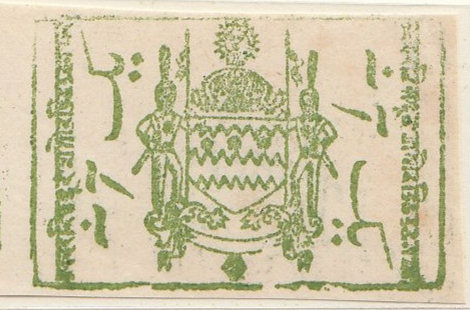 |
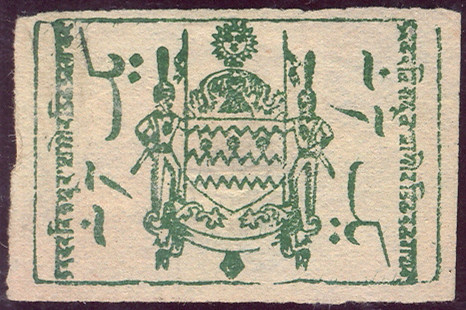 |
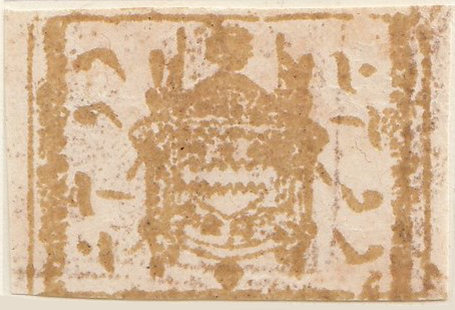 |
| 2 Annas. H1a Courtesy of Sandeep Jaiswal |
1 Anna. H1b Courtesy of Rolf Lamprecht |
2 Annas. H2 Courtesy of Sandeep Jaiswal |
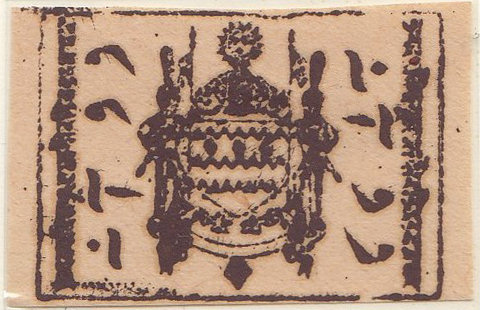 |
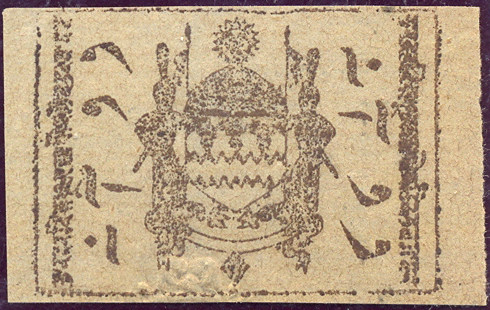 |
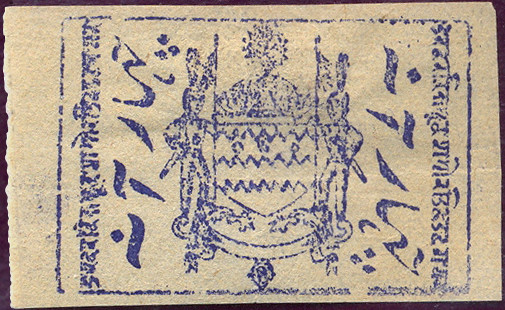 |
| 2 Annas. H2a Courtesy of Sandeep Jaiswal |
2 Annas. H2b Courtesy of Rolf Lamprecht |
4 Annas. H3 From Wiki Commons. |
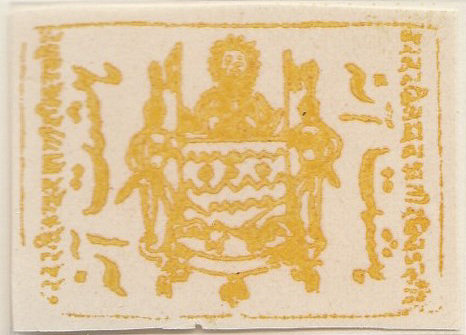 |
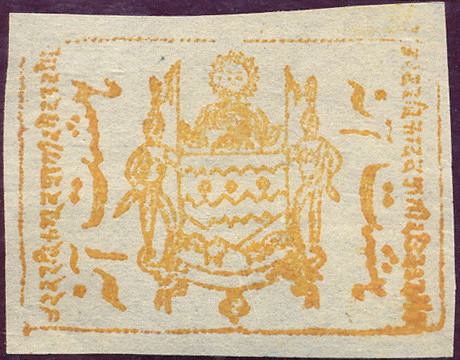 |
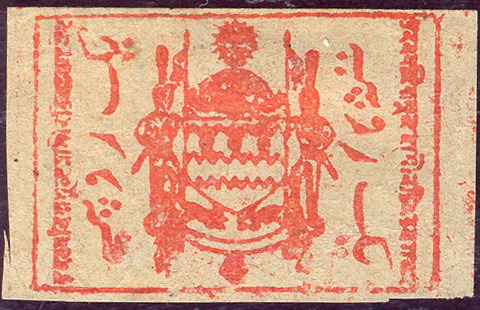 |
| 2 Annas. H4 Courtesy of Sandeep Jaiswal |
8 Annas. H4a Courtesy of Rolf Lamprecht |
1 Rupee. H5 Courtesy of Rolf Lamprecht |
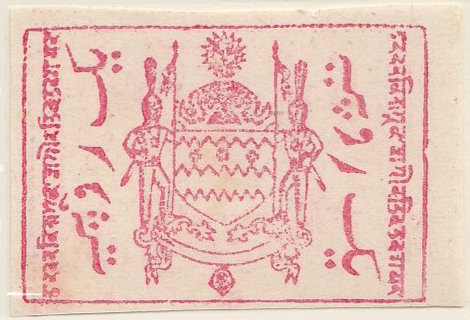 |
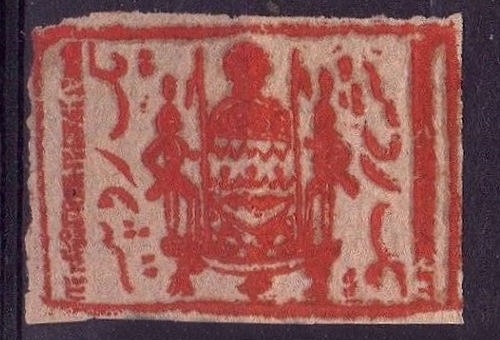 |
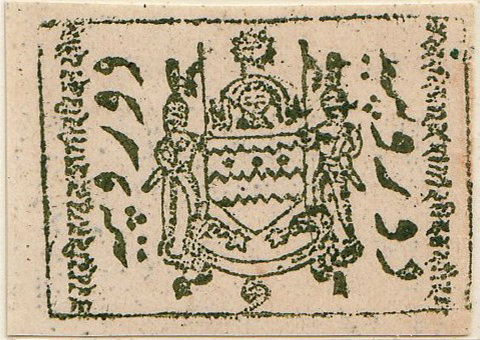 |
| 1 Rupee. H5a Courtesy of Sandeep Jaiswal |
1 Rupee. H5 Forgery, see Note 4 below From Wiki Commons. |
2 Rupees. H6 Courtesy of Sandeep Jaiswal |
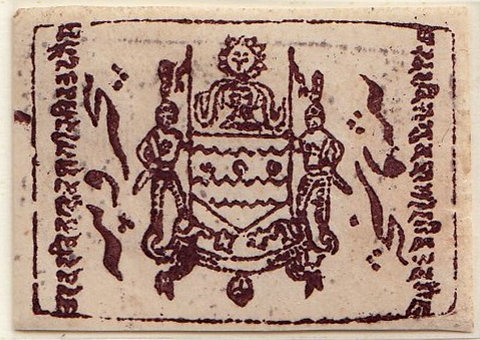 |
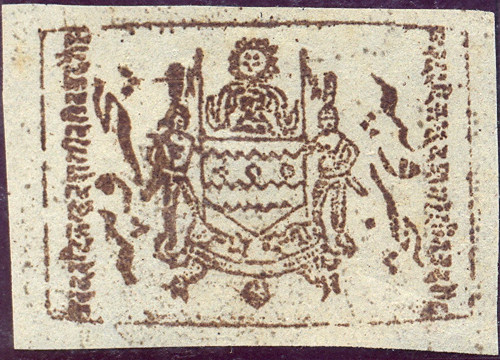 |
| 5 Rupees. H7 Courtesy of Sandeep Jaiswalt |
5 Rupees. H7a Courtesy of Rolf Lamprecht |
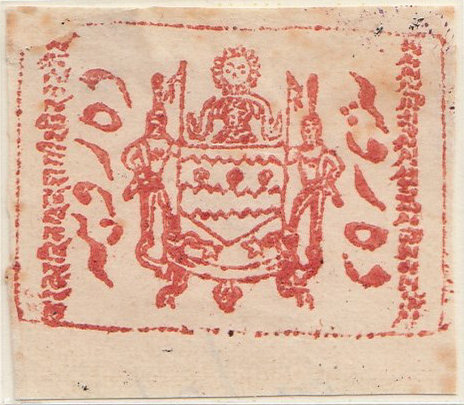 |
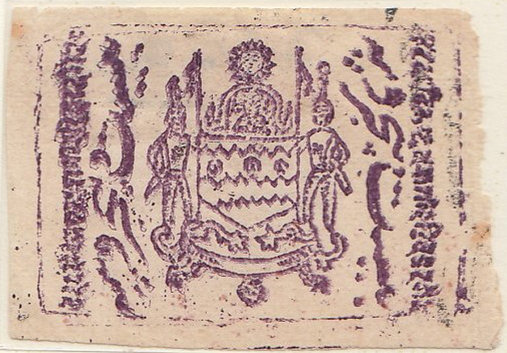 |
| 10 Rupees. H8 | 25 Rupees. H9 |
| Courtesy of Sandeep Jaiswal (each has only 2 known examples) | |
These stamps were bisected in use, like the Indian telegraph stamps. Examples shown below.
They were cancelled by manuscript or an oval hand-stamp in black or purple.
Used copies, especially on piece are very rare.
Hiscocks added the following 5 notes:
| Note 1. Three different wove papers were used for the above series: 1. Thin white wove. 2. Thin fine wove — pale buff. 3. Thin white coarse — buff. These have not been separately listed for lack of specific information but may be in a future edition. From limited observation Nos. 1 and 2 are commonly found on paper types 2 and 3 while all values are found on paper type 1. |
| Note 2. Nos. 8 and 9 are listed in all earlier catalogues but no UK collector has to my knowledge seen copies of either. They are therefore listed but unpriced. |
| Note 3. There is an apparent 'variety' of No. 3 in which the blue pigment is oxidised almost to black. |
| Note 4. Two non-philatelic forgeries of No. 5 exist. In the more common the sun is 1mm clear of the upper frame line compared with almost touching in the genuine and the shield is narrower (7¾mm) than in the genuine (about 9mm). The shield pattern consists of three jagged lines without the three separate 'suns' and there are minor differences at all points. I have not seen the other forgery but it is reported that the Dogra script is gibberish: whether this helps in the majority of cases where the script is badly smudged is not clear. |
| Note 5. For the same designs in black see Nos. 76-89. |
My notes: The second forgery mentioned in Note 4 was apparently produced from an illustration in Moen's Catalogue of 1885/6.
Nos. 8 and 9 mentioned in Note 2 is now illustrated above. Each has only two known examples.
I have only seen references to forgeries of the 1 Rupee stamp as mentioned by Steve Hiscocks in note 4 above.
However it is apparent that, although that may have been true at one time, it is no longer true.
There are now some in circulation that are simply the wrong size, shrunk by 10% to 20%, and at least one in the wrong colour too.
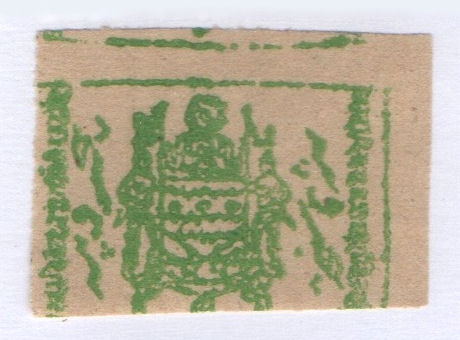 |
|||
| At the top is a pair of 1 Anna and a 5 Rupee that as far as I can tell are genuine. Below these are stamps at the same scale of 300dpi, 1 Anna, 4 Annas, a 5 Rupees in the correct colour and another 5R in green. All are significantly smaller. Perhaps they were copied from examples on the internet without knowing the correct size, and reproduced. As always, buyer beware ! |
|||
The 5Rs on the top row and the one in green are courtesy of Paul & Les Bottomley.
1887(?) As above but on thin cream laid paper.
| RH # | Hisc. | Description | Mint | Used |
|---|---|---|---|---|
| RH10 | H10 | 1A yellowish green (shades) | 25.00 | 75.00 |
| RH11 | H11 | 2A brown (shades) | 25.00 | 75.00 |
| RH12 | H12 | 4A ultramarine (shades) | 25.00 | 75.00 |
| RH13 | H13 | 8A brownish yellow (shades) | 40.00 | 100.00 |
| RH14 | H14 | 1R red (shades) | 50.00 | 125.00 |
Hiscocks added the following note:
| Note. Used prices for Nos. 1-14 are for half stamps. Whole used copies are occasionally found but are very rare — prices x 3. |
Here are some used examples on piece, courtesy of Stanley Gibbons. (Scaled as close as I can to 300dpi)
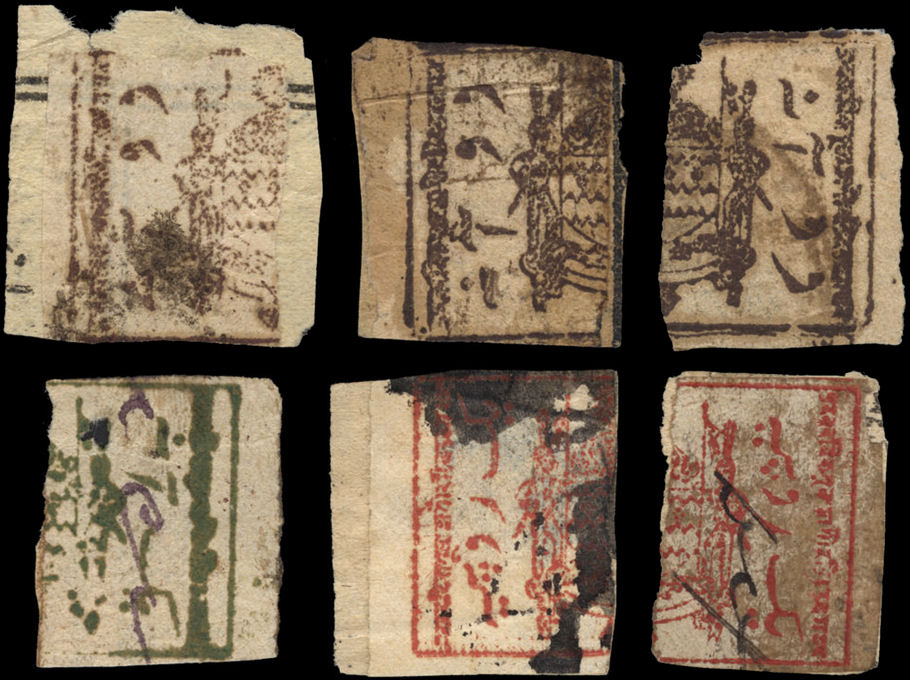
2As at the top, 1A and 1R at the bottom. Despite poor condition, these might at least help to identify forgeries.
Here are three more used examples on piece, courtesy of Sandeep Jaiswal showing some different types of cancels known.
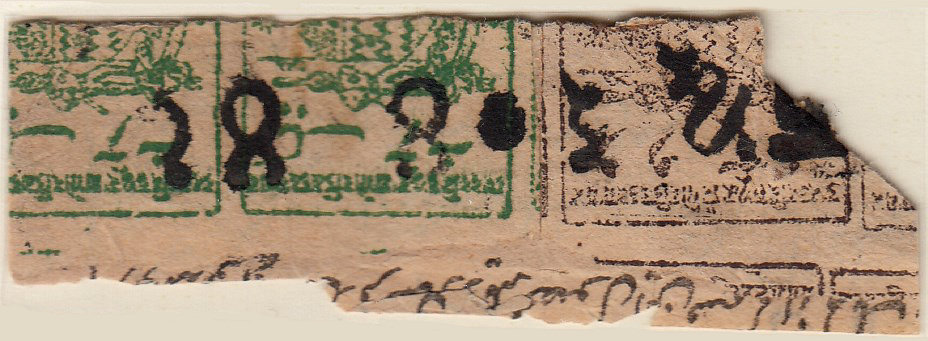
Woodblock on 2 x 1 Anna and 2 Anna.

Intaglio Oval in violet ink on 2 x 4 Anna, 1 Rupee and 2 Anna.
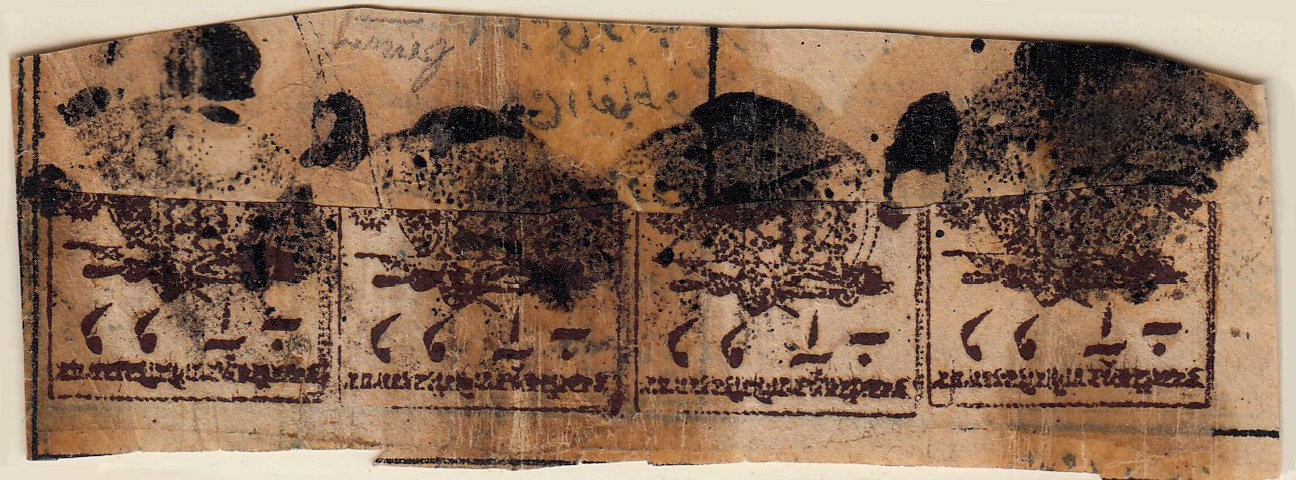
Intaglio Oval in black ink on 4 x 2 Anna.
Here are a few more on loose stamps, again courtesy of Sandeep Jaiswal, showing a variety of cancels.
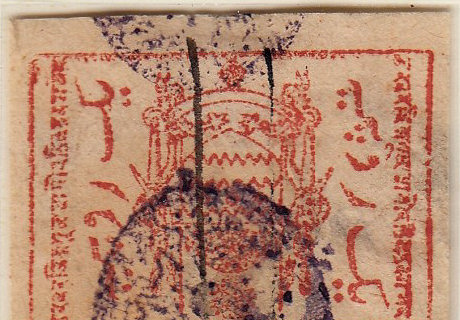
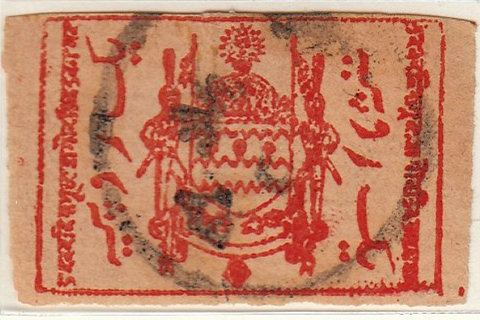
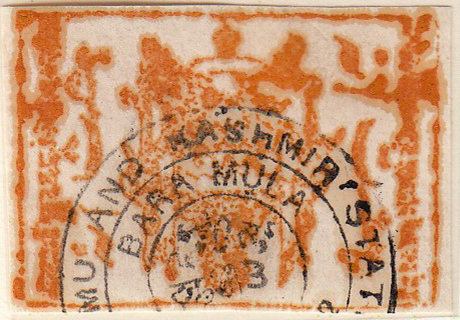
1897 Printed by de la Rue on white wove paper. No watermark. Perf. 14.
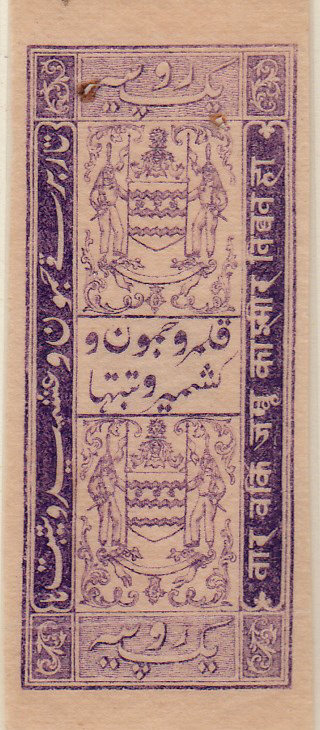 |
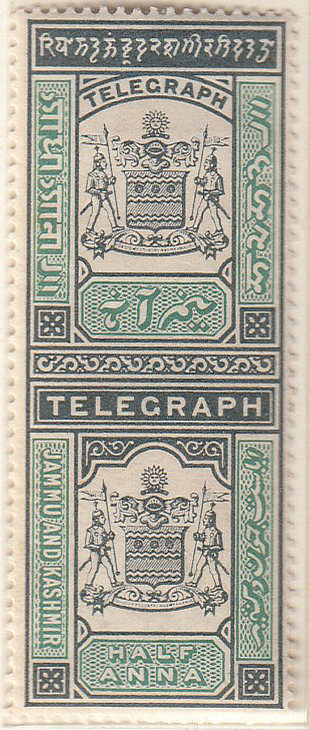 |
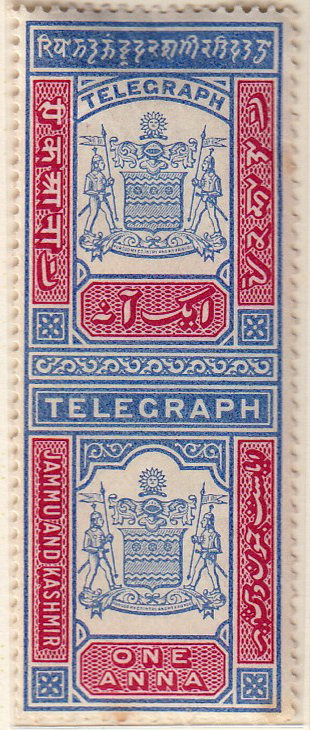 |
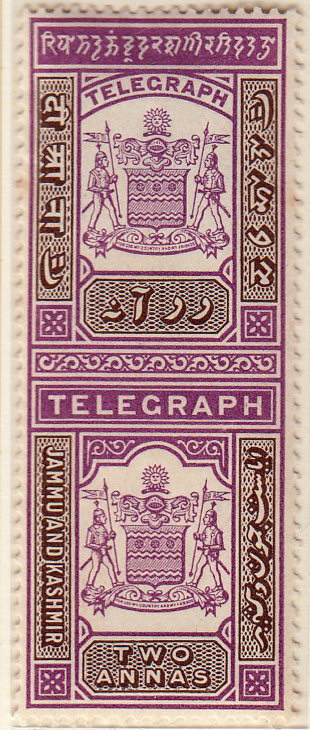 |
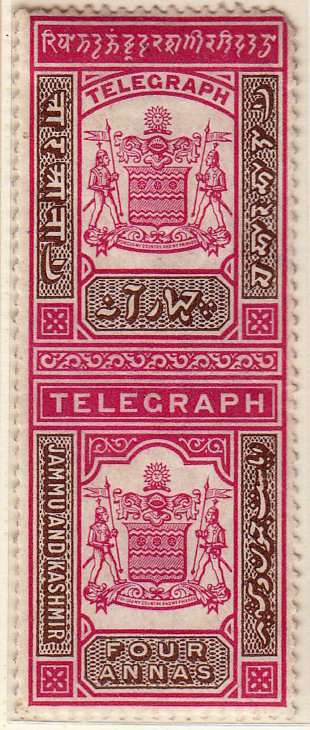 |
| 1896 De La Rue unadopted essay, 1 Rupee. | Type 2, ½ Anna. - RH22 | Type 2, 1 Anna. | Type 2, 2 Anna. | Type 2, 4 Anna. |
| Courtesy of Sandeep Jaiswal | ||||
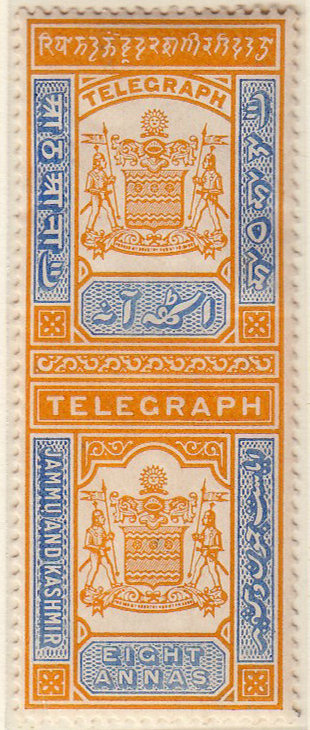 |
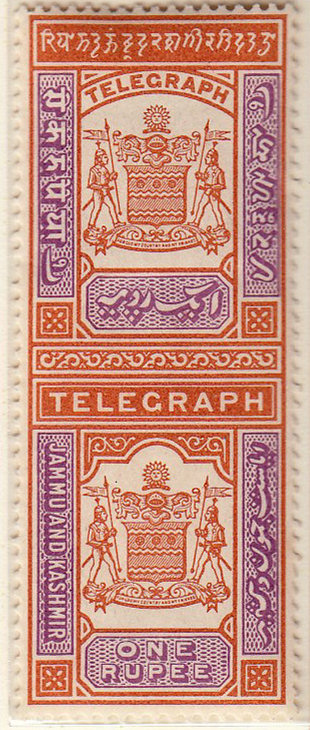 |
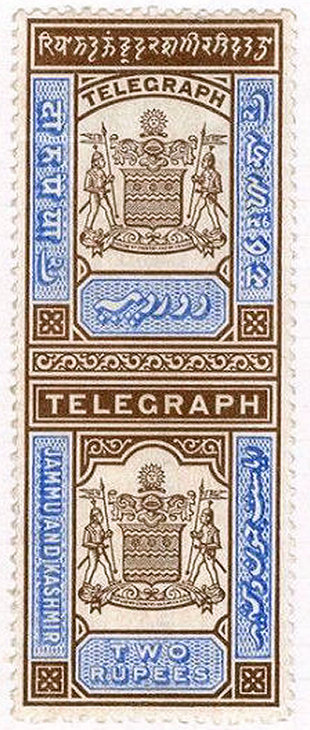 |
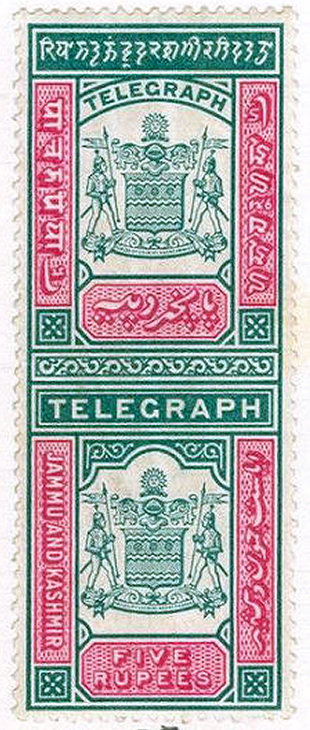 |
| Type 2, 8 Anna. | Type 2, 1 Rupee. | Type 2, 2 Rupee. | Type 2, 5 Rupee. |
| Courtesy of Sandeep Jaiswal | Courtesy of Rarities Stamp Auctions | ||

Used 28/3/1908 with stamps of 4As, 1A and 8As on 5Rs for a total of 13As. Image courtesy of David Wild

Used 10/4/1908 with stamps of 8As on 5Rs, 4As and 2As for a total of 14As. Image courtesy of David Wild
1906-1909(?) Provisionals. Stamps of 1897 and 1899 surcharged as indicated in black. Other details as above.
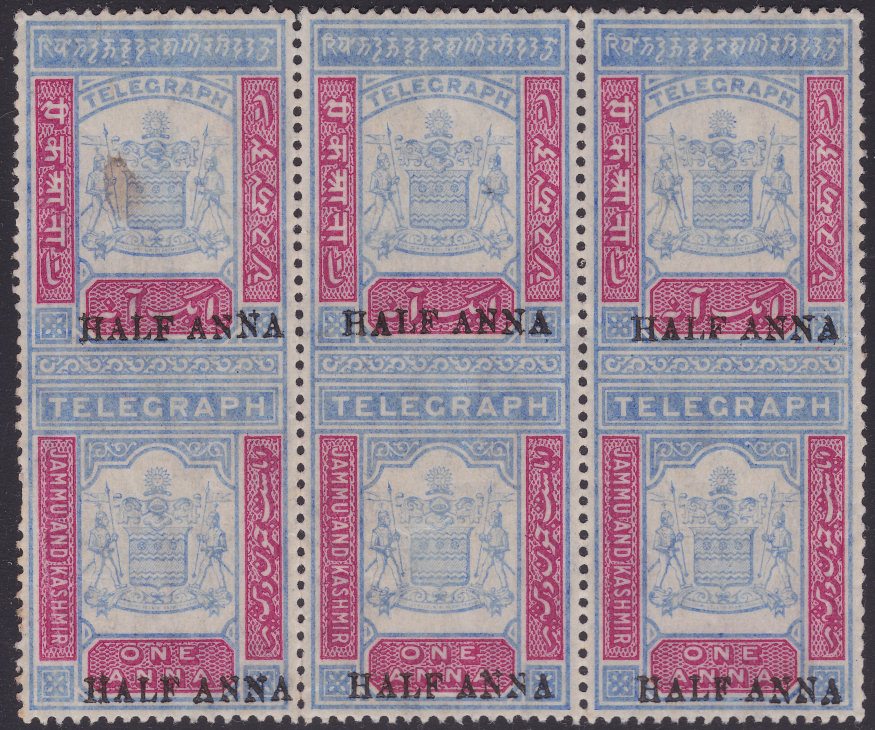 |
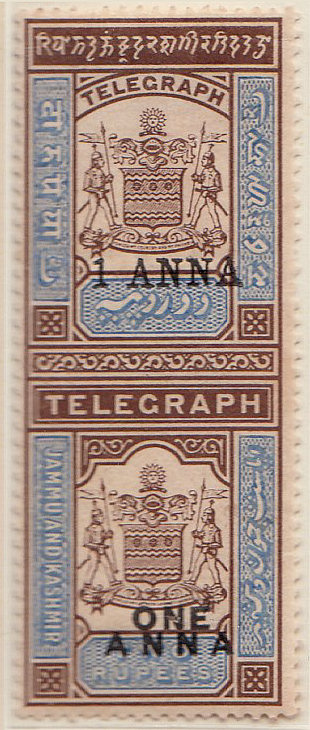 |
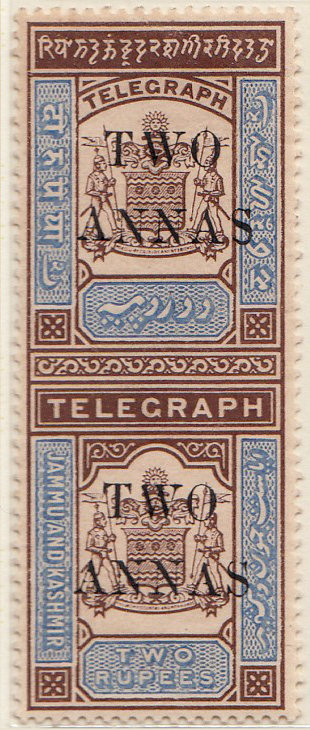 |
| Type 3 RH31, the overprints appear to be approximately the same top and bottom, though the last "A" is a bit variable and the vertical alignment of some of the letters are a bit wrong. Sandeep Jaiswal knows of three other mint examples, but nowhere near enough for plating. |
Type 5 RH33, courtesy of Sandeep Jaiswal |
Type 6 RH35, courtesy of Sandeep Jaiswal |
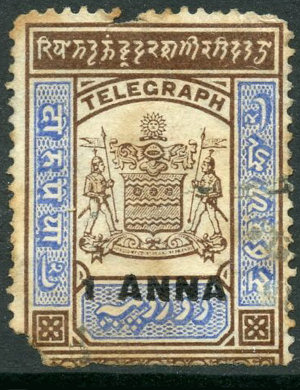 |
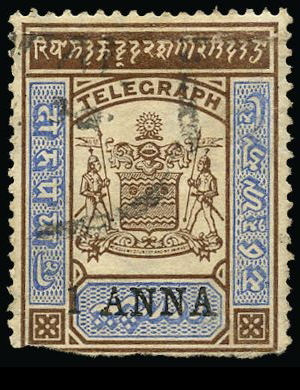 |
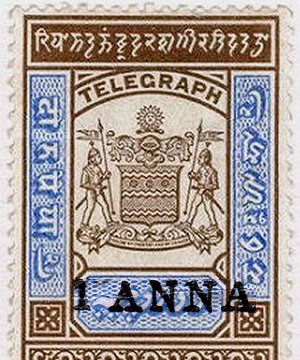 |
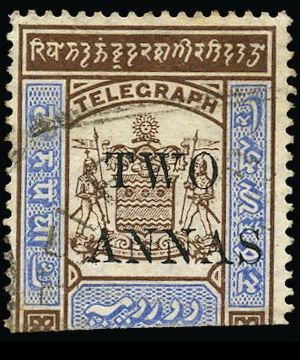 |
| Type 4 (RH32) No serifs used Courtesy Malcolm of Richardson & Copp. |
Type 5 (RH33) With Serifs used | Type 5A (RH34 top) Mockup wider overprint |
Type 6 (RH35) used |
Hiscocks lists only one type of the Two Anna, but when recently looking closely, the alignment between the top and bottom words are different on each.
Here is 3 from a piece shown below and the one above, with the alignment magnified below them :
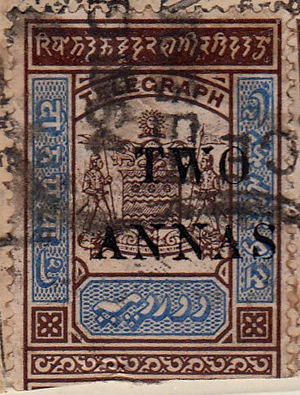 |
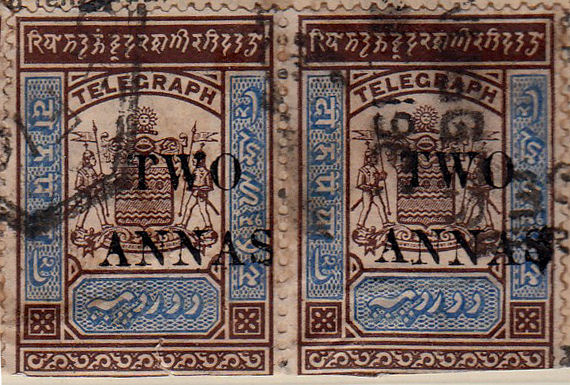 |
 |
|
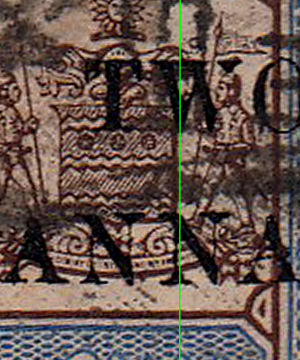 |
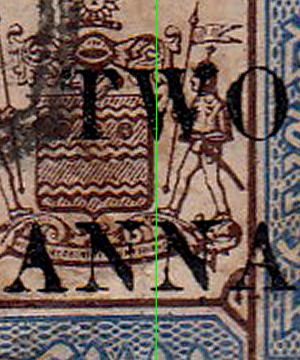 |
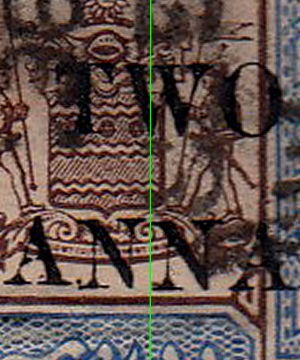 |
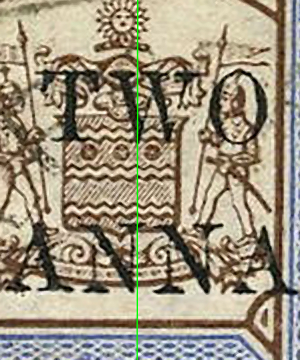 |
| The green line shows the alignment of the "ANNA" relative to the first point of the "W". The "FOUR ANNAS" probably has similar variability. There are at least 16 different 8 Annas overprints, fairly easily distinguished with mint examples. The same is probably true of all the overprint values. |
|||
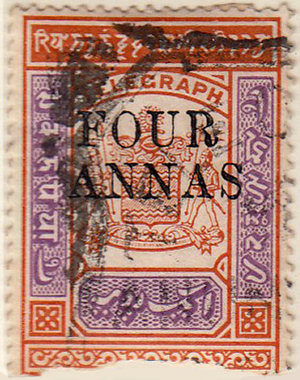 |
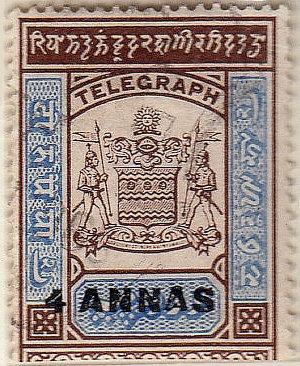 |
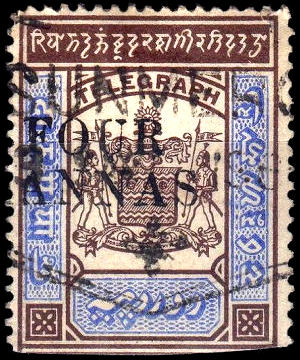 |
| Type 7A on 1R (RH36) used |
Type 7 on 2A (RH37 top) This is 14mm wide. RH37a is similar but 15mm. |
Type 7A on 2A (RH38 top) used |
| Note the different alignment of the "FOUR" with "ANNAS". Courtesy of Sandeep Jaiswal | ||
The 8 Annas overprints have only three known different top parts, but many different bottom parts. Since used stamps are the top part, this presents difficulties.
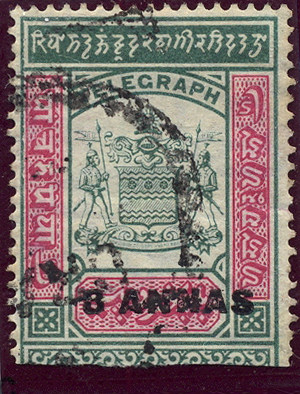 |
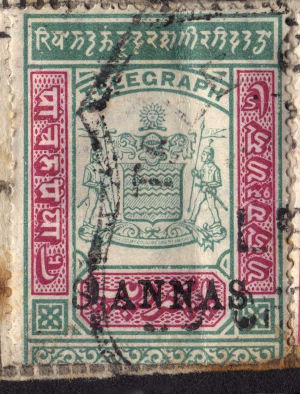 |
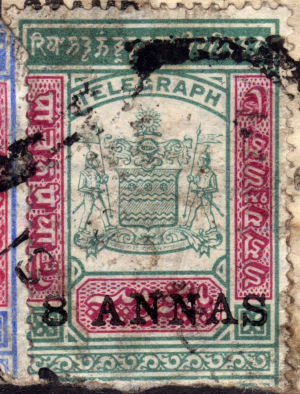 |
| Type 8, 9 or 10 ? This has no serifs and thick, squat lettering. Unfortunately several types are like this but with differences in the bottom half. |
Type 12? (from piece dated 10/4/1908) This is quite narrow and matches Type 12 best. |
Type 15A ? This has serifs but is it Type 13, 14, 15 or a new one ? The '8' looks like Type 14, but the 'S' does not. This could be Type 15A (see below) |
With Steve Hiscocks original images being reduced size in black and white half-tone,
it is not easy to distinguish between some of them, especially with only top halves.
As mentioned in his notes below, there are also some that were not listed.
The left image is courtesy of Rolf Lamprecht. The other two images, courtesy of David Wild, include at least one new one.
Small-thick '8 ANNAS' without serifs at the top
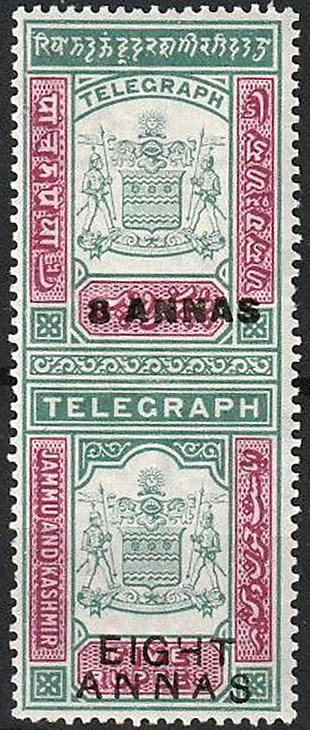 |
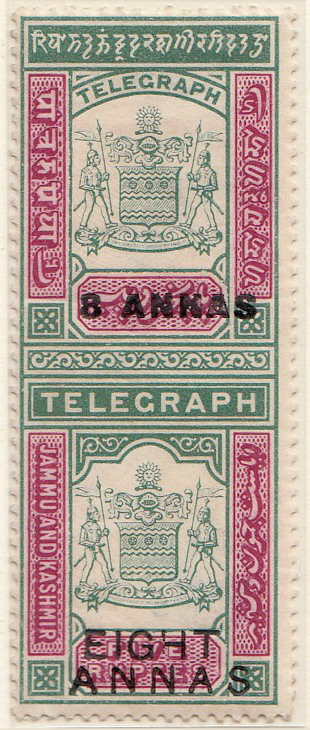 |
| Type 8 RH40 Large letters at the bottom courtesy of Stamptrain on Ebay. |
Type 8 RH40a 'I' of 'EIGHT' above left leg of 'N' courtesy of Sandeep Jaiswal |
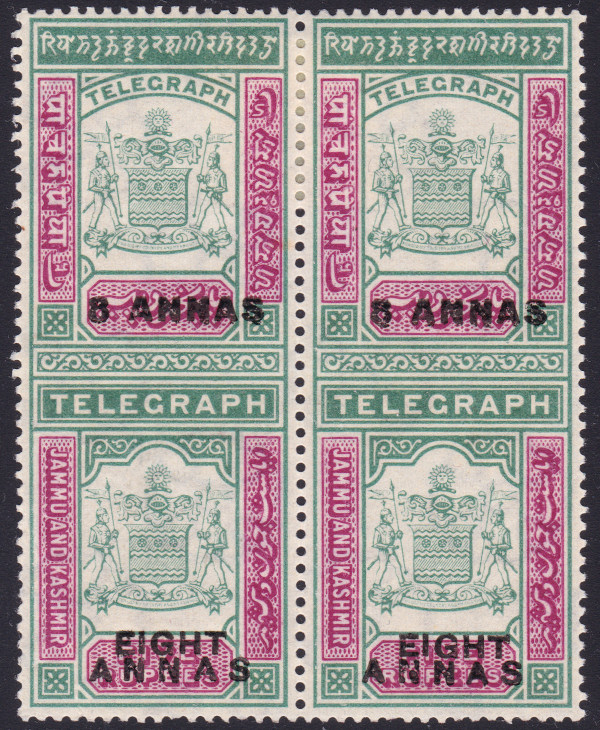 |
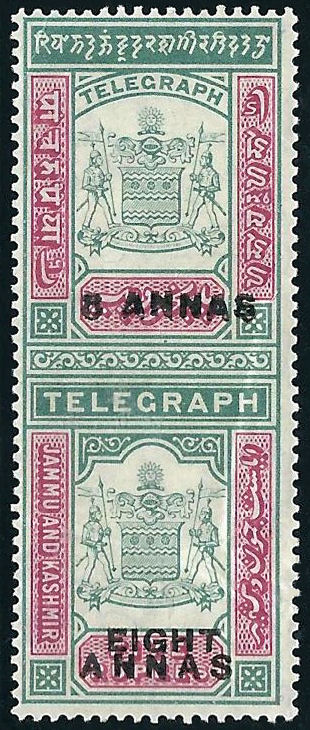 |
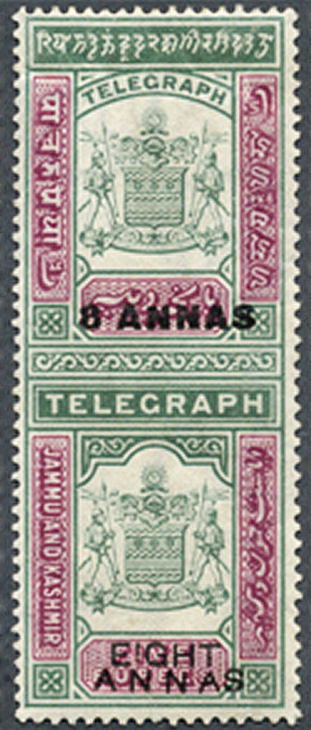 |
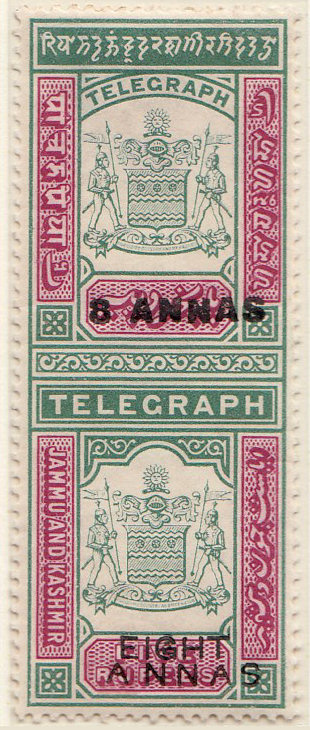 |
|
| Type 10 'E' of 'EIGHT' to left of 'N' of 'ANNAS'. |
Type 9 'E' of 'EIGHT' above 'N' of 'ANNAS'. |
Type 9A 'E' left of 'N' of 'ANNAS', 'T' near 'S'. |
Type 11 RH43 'I' within 'N' courtesy of Auktionshaus Christoph Gärtner |
Type 11 RH43a 'I' over leg of 'N' courtesy of Sandeep Jaiswal |
Large '8 ANNAS' at the top with serifs
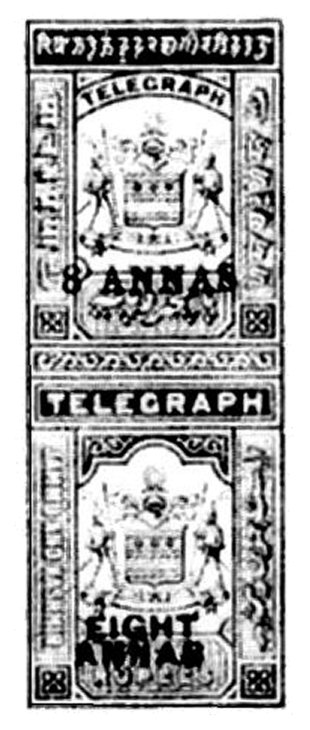 |
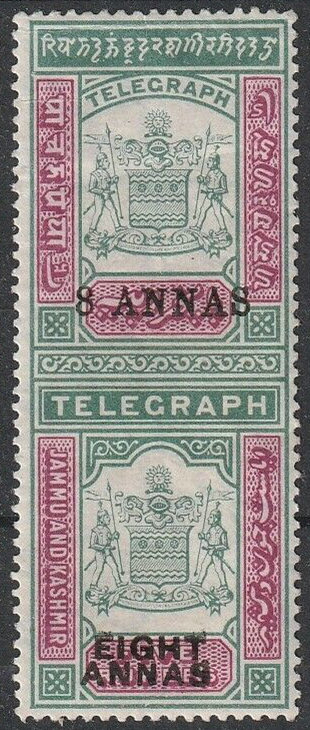 |
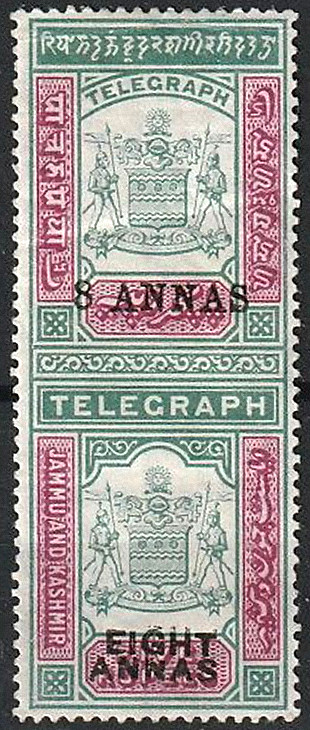 |
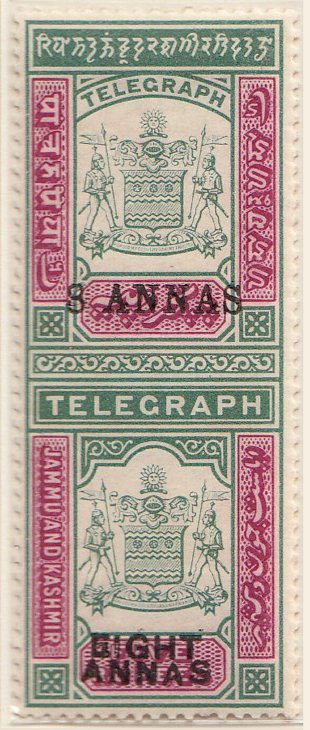 |
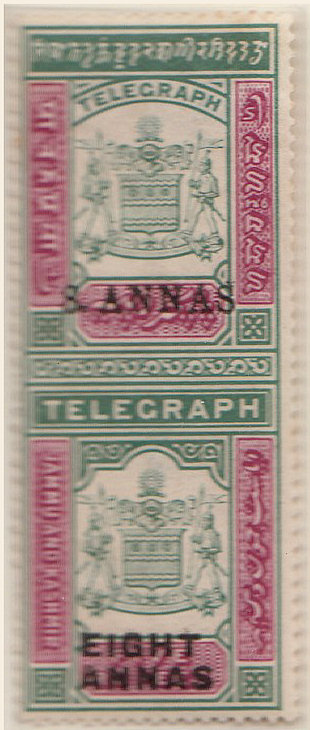 |
| Type 12 RH44 from Hiscocks book page 170 (I above centre of N), together with a new example. The Hiscocks example has the overprint placed unusually high but the relative spacing matches. Colour image courtesy of gerland6 on Ebay. (click colour image for listing). |
Type 12 RH44a courtesy of Stamptrain on Ebay. I right of centre of N |
Type 12
RH44b I left of centre of N courtesy of Sandeep Jaiswal |
Type 12A Similar to the last 2 but the 'EIGHT' is slightly wider and over to the left RH44c courtesy of Sandeep Jaiswal |
|
Very Large '8 ANNAS' at the top with serifs, "ornate" script at bottom.
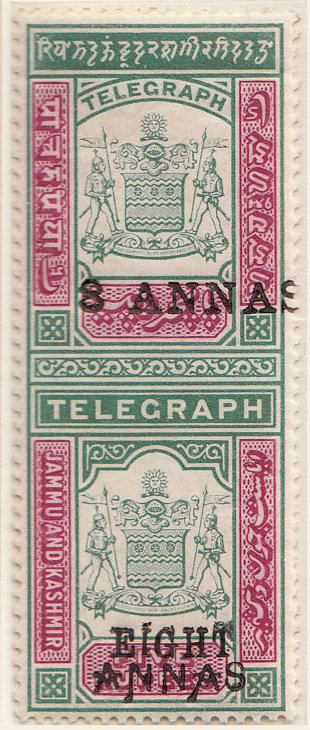 |
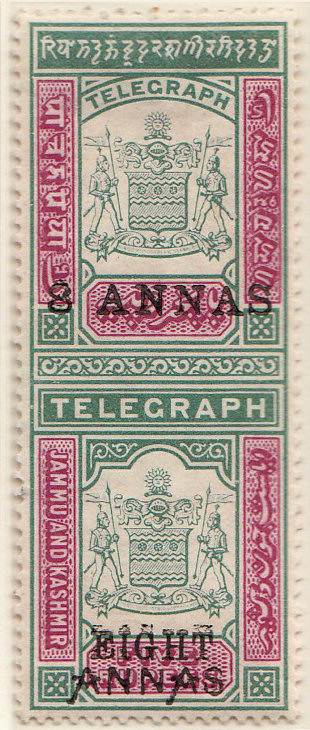 |
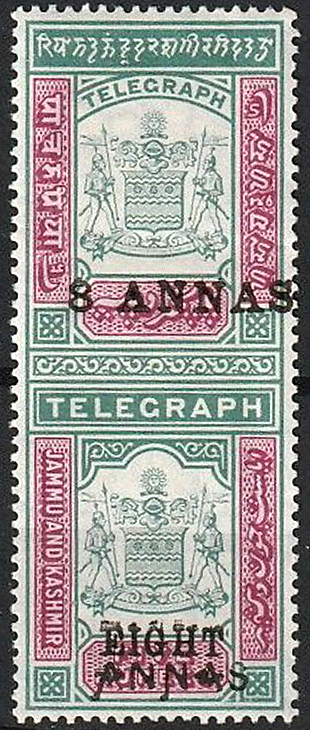 |
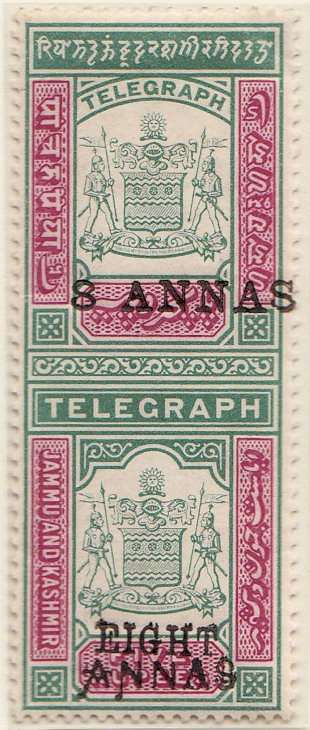 |
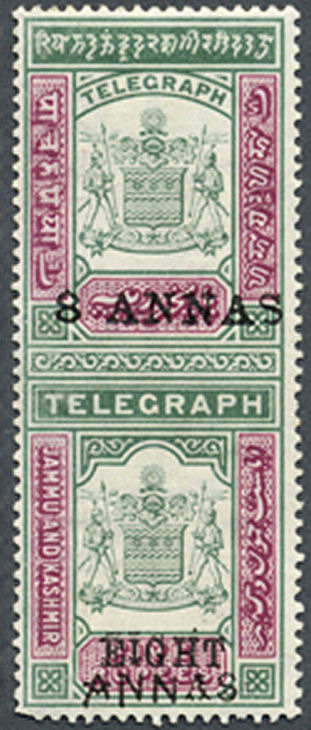 |
| Type 13 RH45 courtesy of Sandeep Jaiswal |
Type 14 RH46 courtesy of Sandeep Jaiswal |
Type 15 RH47 courtesy of Stamptrain on Ebay. |
Type 15A RH48 not listed by Hiscocks, courtesy of Sandeep Jaiswal |
Type 15A RH48a - 'EIGHT' to the right, courtesy of Auktionshaus Christoph Gärtner |
I Don't know how many of these there were on a sheet, but there are at least 16 different types, so perhaps a multiple of that.
1911 New design based on upper half of previous issue. Paper as before. Perf. 14.
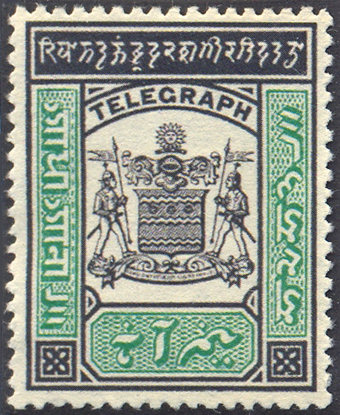 |
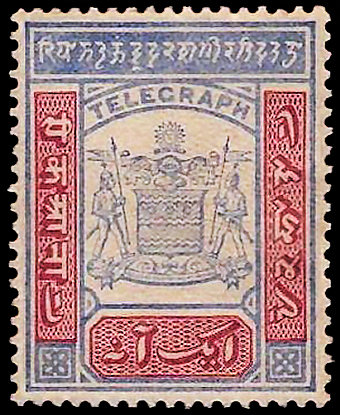 |
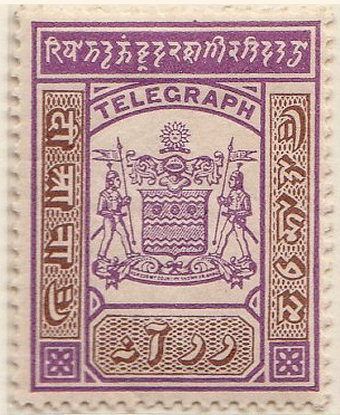 |
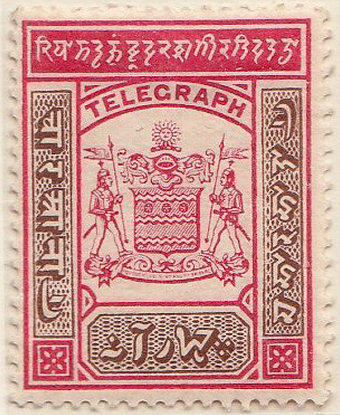 |
| Type 16 - ½A RH50 courtesy of Rolf Lamprecht. |
Type 16 - 1A RH51 | Type 16 2A -RH52 courtesy of Sandeep Jaiswal. |
Type 16 4A - RH53 courtesy of Sandeep Jaiswal. |
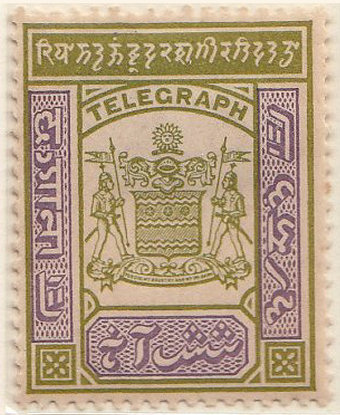 |
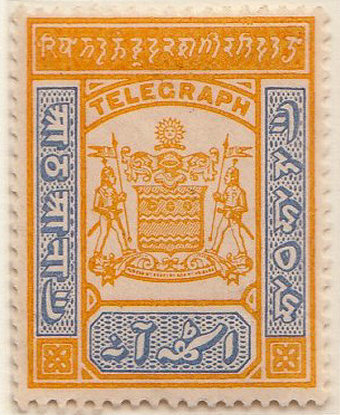 |
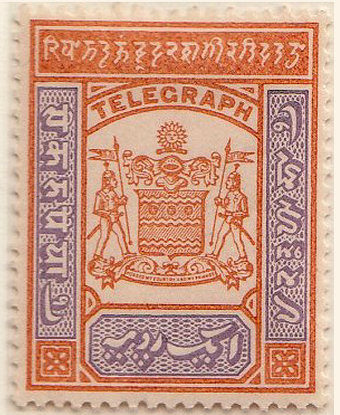 |
 |
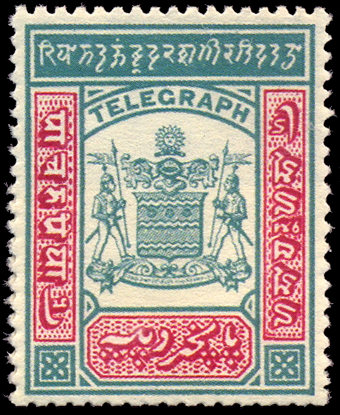 |
| Type 16 6A - RH54 courtesy of Sandeep Jaiswal. |
Type 16 8A - RH55 courtesy of Sandeep Jaiswal. |
Type 16 1R - RH56 courtesy of Sandeep Jaiswal. |
Type 16 2R - RH57 Scan Needed. |
Type 16 5R -RH58 courtesy of Rolf Lamprecht. |
| RH # | Hisc. | Type | Description | Mint | Used |
|---|---|---|---|---|---|
| RH50 | H50 | 16 | ½A blackish olive and blue green (46,000) (1913) | 120.00 | - |
| RH51 | H51 | 16 | 1A bright blue and carmine (219,280) (1911) | 75.00 | - |
| RH52 | H52 | 16 | 2A bright reddish violet and olive brown(247,760) (1913) | 75.00 | - |
| RH53 | H53 | 16 | 4A rose carmine and olive brown (251,200) (1912) | 75.00 | - |
| RH54 | H54 | 16 | 6A violet and sage green (175,600) (1913) | 100.00 | - |
| RH55 | H55 | 16 | 8A yellow and bright blue (189,360) (1912) | 100.00 | - |
| RH56 | H56 | 16 | 1R yellow-orange and reddish violet (98,640) (1916) | 120.00 | - |
| RH57 | H57 | 16 | 2R brown and light blue (10,560) (1921) | 200.00 | - |
| RH58 | H58 | 16 | 5R bluish green and carmine (10,320) (1921) | 200.00 | - |
Hiscocks added the following 2 notes:
| Note 1. While I have not seen copies of most of the above (Nos. 50-58) it is stated in the de la Rue records that there was to be no change in colours and I have assumed that this was so. |
| Note 2. The printings given in brackets are from de la Rue records. No printings between 1922 and 1929 or after 1929 are listed however and it seems probable that the records are incomplete. The above printings should therefore be regarded as minimum numbers except perhaps in the case of Nos. 57 and 58 where the rate of usage was so low that a printing was not required for 10 years and a second printing probably not needed. |
My Note: I have seen a 4As stamp overprinted for use as a Special Adhesive, so the quantities given by Hiscocks may not all have been used as Telegraph stamps.
Beware of similar fiscal stamps being sold as Telegraph stamps. Look for the word 'TELEGRAPH'.
1929 Local Provisional issue. Surcharged in black on the previous issue.
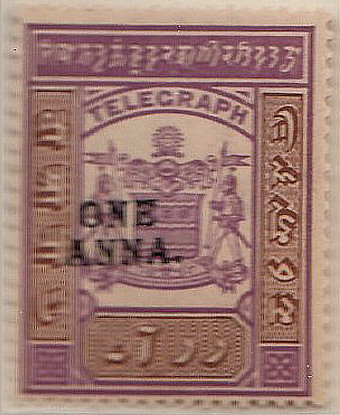 |
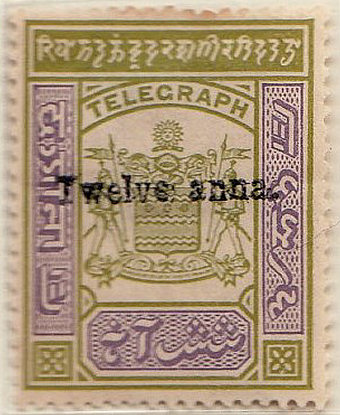 |
| 1A on 2A(RH24) - RH59 | 12A on 6A(RH26) - RH59 |
| Courtesy of Sandeep Jaiswal | |
| RH # | Hisc. | Type | Description | Mint | Used |
|---|---|---|---|---|---|
| RH59 | - | (16) | 1A on 2A(RH24) bright reddish violet and olive brown | - | - |
| RH60 | - | (16) | 12A on 6A(RH26) violet and sage green | - | - |
1930 Provisional. Surcharged in black on No. 56 by de la Rue.
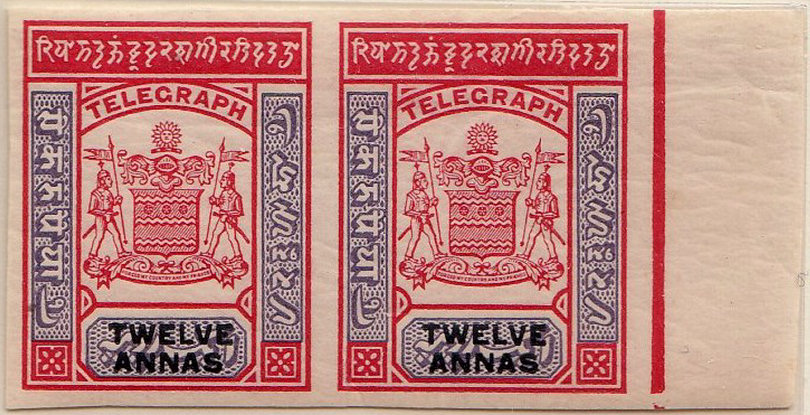 |
| Type 17 - 12A on 1R(RH56) - Proof of RH61 |
| Courtesy of Sandeep Jaiswal |
| RH # | Hisc. | Type | Description | Mint | Used |
|---|---|---|---|---|---|
| RH61 | H59 | 17 | 12A on 1R (No. 56) (12,320) | 240.00 | - |
Hiscocks added the following 3 notes:
| Note 1. The printing quoted for No. 56 excludes those surcharged for No. 59 in March 1930. |
| Note 2. Locally printed provisionals on 1911-16 issues have not been reported and No. 59 is only known from de la Rue records. It is quite probable that locally prepared provisionals were used to fill the gap while delivery of No. 59 was awaited. |
| Note 3. Precise details of the change of usage allowing the employment of smaller stamps are not known but it seems certain, in view of the large numbers printed and the scarcity of mint and virtual absence of used copies, that the new procedure resulted in their remaining in official hands at all stages. |
My Note: Locally printed provisionals as mentioned in Note 2, are now known and illustrated above.
1934 New design (Sir Hari Singh). Recess printed by de la Rue on white wove paper. Watermark W1. Perf. 14.
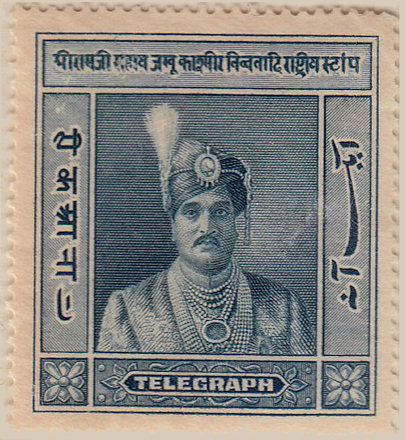 |
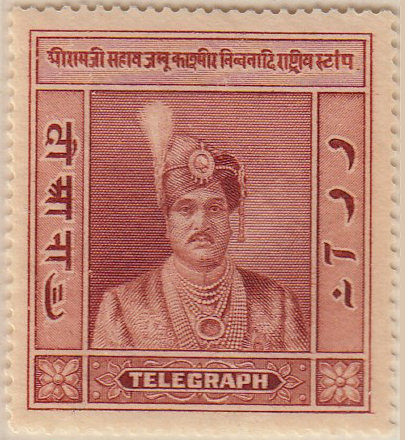 |
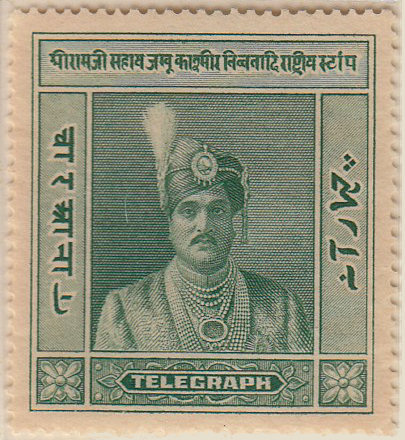 |
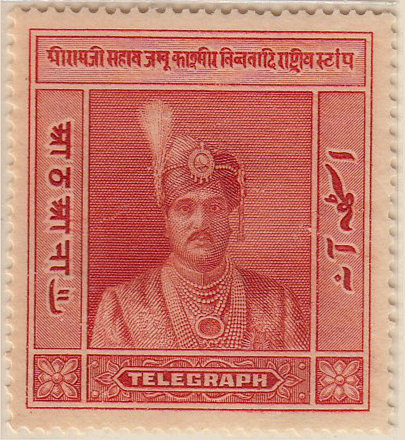 |
| Type 18 - 1A - RH62 | Type 18 - 2A - RH63 | Type 18 - 4A - RH64 | Type 18 - 8A - RH65 |
| Courtesy of Sandeep Jaiswal | |||
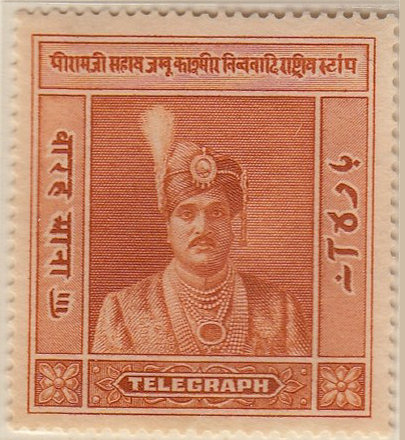 |
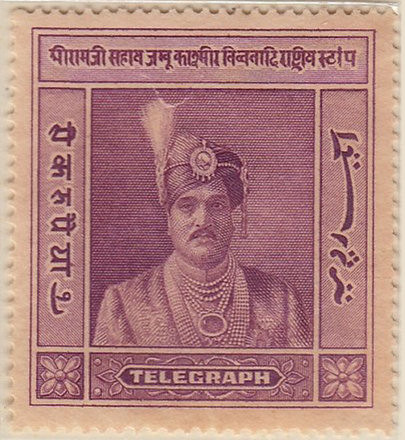 |
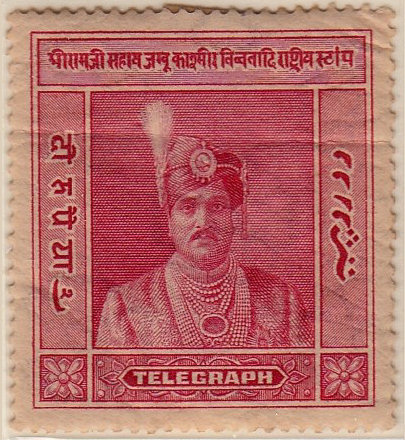 |
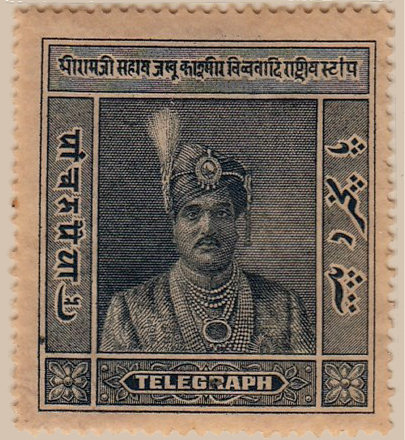 |
| Type 18 - 12A - RH66 | Type 18 - 1R - RH67 | Type 18 - 2R - RH68 | Type 18 - 5R - RH69 |
| Courtesy of Sandeep Jaiswal | |||
1941(?) New design (Sir Hari Singh). Typographed on white wove paper. No watermark. Perf. 13¾.
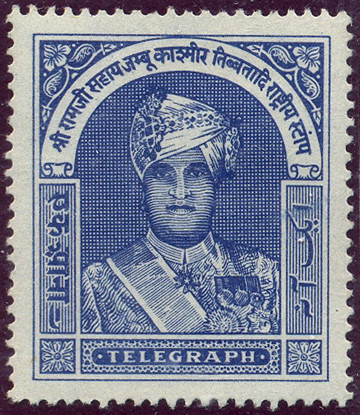 |
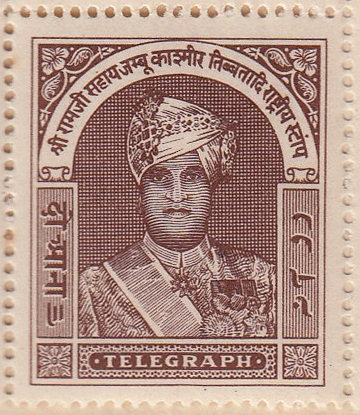 |
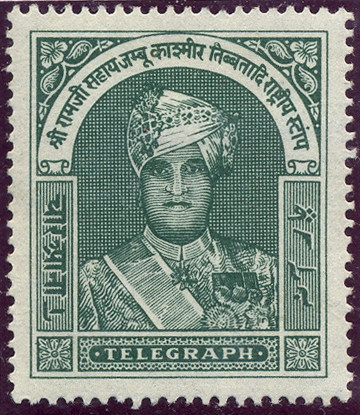 |
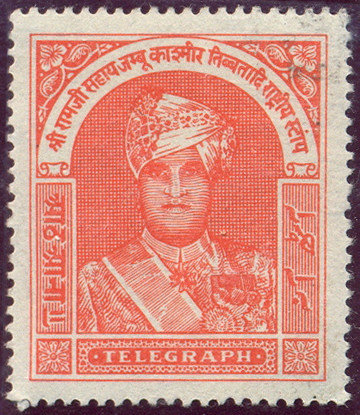 |
| 1 Anna. H68 courtesy of Rolf Lamprecht. |
2 Anna. H69 courtesy of Sandeep Jaiswal. |
4 Anna. H70 courtesy of Rolf Lamprecht. |
8 Anna. H71 courtesy of Rolf Lamprecht. |
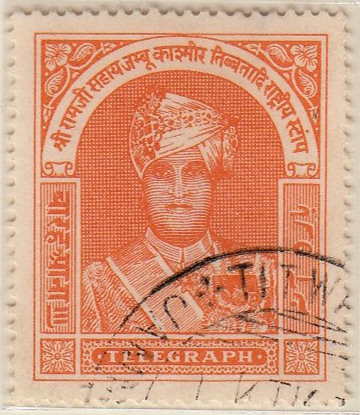 |
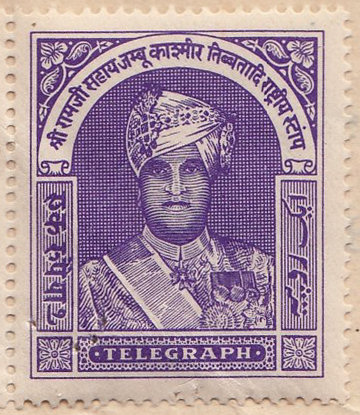 |
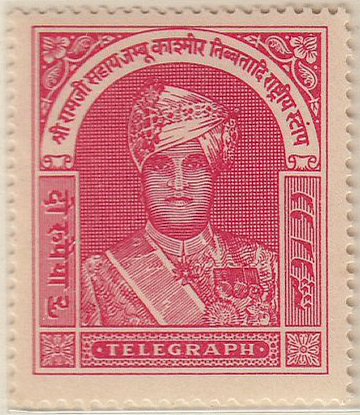 |
| 12 Anna used. H72 courtesy of Sandeep Jaiswal. |
1 Rupee . H73 courtesy of Sandeep Jaiswal. |
2 Rupee. H74 courtesy of Sandeep Jaiswal. |
Type 19. Used examples are very rare.
Hiscocks added the following 5 notes:
| Note 1. Nos. 68-75 were apparently produced in India — possibly at the Government Security Press as Nasik Road. |
| Note 2. The date of issue is unknown. The new design may have been necessitated by the difficulty of obtaining supplies. from England after the outbreak of war in 1939. |
| Note 3. The colours of Nos. 74 and 75 are assumed by analogy with those of the 1934 set (Nos. 66 and 67). |
| Note 4. Nos. 70 and 71 are known overprinted 'Spl: Adh', i.e. Special Adhesive. This is the name given to general purpose revenue stamps in India. |
| Note 5. A stamp similar in type to Nos. 68-75 but with 'WIRELESS' substituted for 'TELEGRAPH' is referred to in the introduction to this section. |
The reference of Note. 5 says simply "It is not known whether this is a telegraph stamp or some sort of revenue stamp
— perhaps for the payment of a radio license."
1950s or 60s(?) John Barefoot lists a new design similar to last but with a different centre.
Typographed on white wove paper. No watermark. Perf. 14.

This is a mockup of what I will call Type 20 based on the description.
I will replace it as soon as I have a proper image.
Some of these were overprinted for use as a Special Adhesives.
Also a similar type was inscribed Special Adhesive at the bottom.
The monarchy was abolished in 1952 and the last ruling Maharaja, Sir Hari Singh died on 26 April 1961.
| RH # | Hisc. | Type | Description | Mint | Used |
|---|---|---|---|---|---|
| RH78 | - | 20 | 1R violet | 100.00 | - |
The denominations are given in Persian. This table may be helpful.

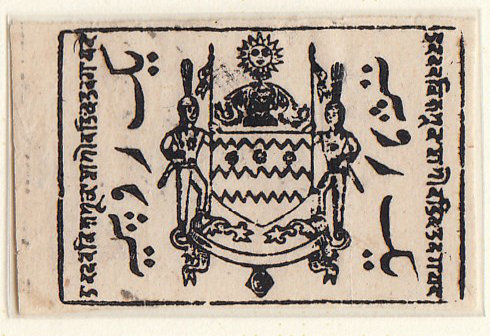 |
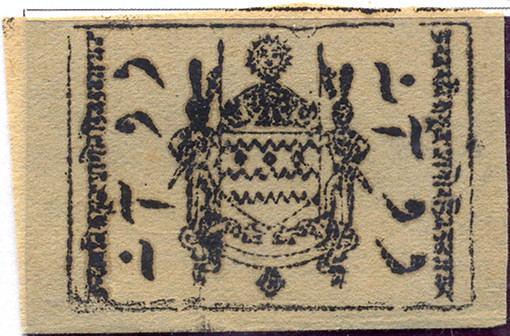 |
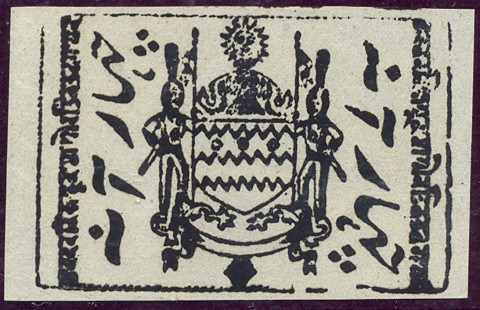 |
| 1 Anna. RH79 courtesy of Sandeep Jaiswal |
2 Annas RH80 courtesy of Rolf Lamprecht |
4 Annas RH81 courtesy of Rolf Lamprecht |
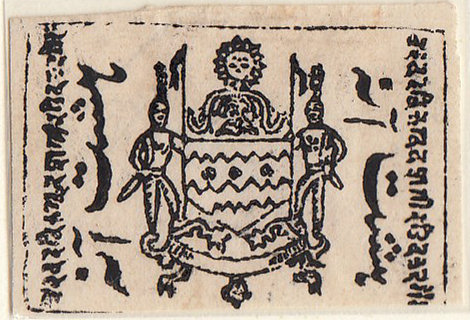 |
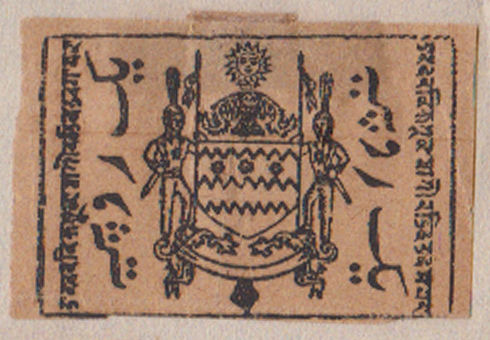 |
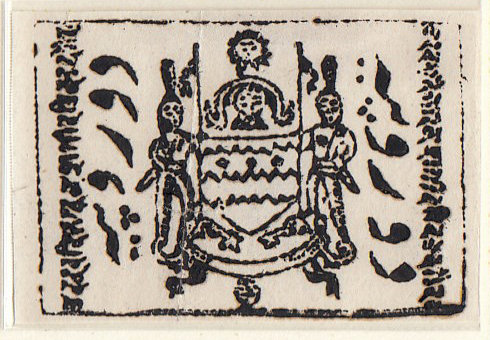 |
| 8 Anna. RH79 courtesy of Sandeep Jaiswal |
1 Rupee RH83 courtesy: Sarfaraz of traditional-india |
2 Rupee RH84 courtesy of Sandeep Jaiswal |
 |
||
| 5 Rupees. RH85 | 10 Rupees. RH86 | 25 Rupees. RH87 |
| Courtesy of Sandeep Jaiswal (the last 2 are only known examples) | ||
| RH # | Hisc. | Type | Description | Mint | Used |
|---|---|---|---|---|---|
| RH79 | H76 | 1 | 1A black | 18.00 | 60.00 |
| RH80 | H77 | 1 | 2A black | 18.00 | 60.00 |
| RH81 | H78 | 1 | 4A black | 18.00 | 60.00 |
| RH82 | H79 | 1 | 8A black | 30.00 | 72.00 |
| RH83 | H80 | 1 | 1R black | 48.00 | 90.00 |
| RH84 | H81 | 1 | 2R black | 60.00 | 120.00 |
| RH85 | H82 | 1 | 5R black | 120.00 | 180.00 |
| RH86 | H83 | 1 | 10R black | - | - |
| RH87 | H84 | 1 | 25R black | - | - |
Hiscocks added the following note:
| Note. See Notes 1 and 2 below No. 9 above. |
1887(?) As above but on laid paper.
| RH # | Hisc. | Type | Description | Mint | Used |
|---|---|---|---|---|---|
| RH88 | H85 | 1 | 1A black | 30.00 | 90.00 |
| RH89 | H86 | 1 | 2A black | 30.00 | 90.00 |
| RH90 | H87 | 1 | 4A black | 48.00 | 120.00 |
| RH91 | H88 | 1 | 1R black | 180.00 | 300.00 |
| RH92 | H89 | 1 | 5R black | 270.00 | 450.00 |
Steve Hiscocks wrote:
|
The Patiala State Telephone Service apparently operated from the late 1920s until at least the early 1950s. Originally confined to Patiala State, the service was extended after independence to neighbouring areas as new political groupings of states came about. The telephone service operated in very much the same way as a telegraph service except that messages were relayed by spoken word over the telephone system and indeed the whole system appears to have been introduced in this way because the Government of India would not permit the establishment of a Patiala State Telegraph Service like that in Kashmir. Stamps were used on forms similar to telegraph forms as evidence of payment and also, for accounting purposes, on telephone bill receipts. When cancelled at all it is often with a blue pencil line but cds cancellations are also common. The rate was apparently ½A per word with double for express and with a 'reply paid' option. The service was thus cheaper than an ordinary trunk call (minimum 3 minutes) for short messages and furthermore gave a written record. All used stamps are thought to have remained in the hands of the public. Dates of issue are unknown but evidently not related to those of the basic stamps. Overprinting was carried out locally as required using whatever stamps happened to be in stock. Victorian stamps were thus overprinted and used 30-40 years after they were originally issued for postal purposes. In view of the above, no attempt has been made to suggest dates of issue and stamps have simply been listed in order of their SG numbers for each type of overprint. It is probable that a number remain unknown to me and that the list will be extended in future editions. Please note that the SG numbers quoted below refer to the Patiala section and not the general India section of Stanley Gibbons catalogue. |
My notes:
A few have had to be added, I have marked them with a red asterisk (*). I have had to re-number because of that.
I have added 'RH' numbers ('Revised Hiscocks') to accommodate new entries. I may still need to add others.
Overprinted 'Telephone' of type 1 on Queen Victoria postage stamps of 1891-96. White wove paper except where indicated. Watermark W1. Perf. 14.
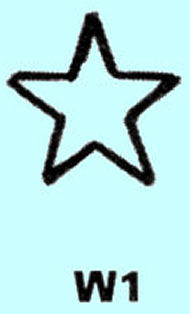
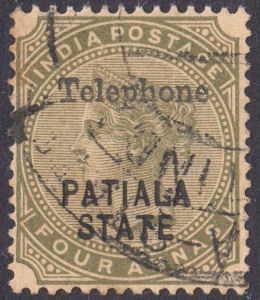 |
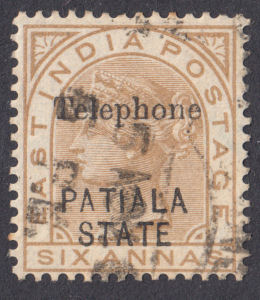 |
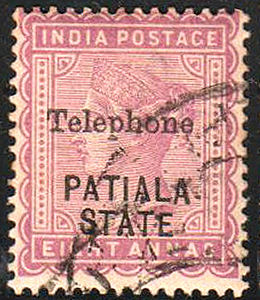 |
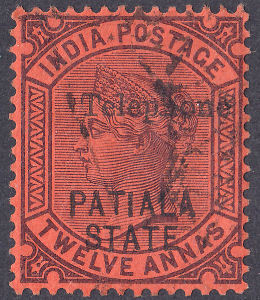 |
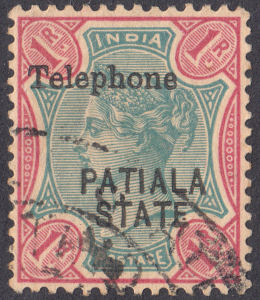 |
| RH1 | RH2 | RH3 from Wiki Commons. | RH4 | RH5 |
* I added RH5 due to the example shown.
| RH # | Hisc. | Type | Description | Mint | Used |
|---|---|---|---|---|---|
| RH1 | H1 | 1 | 4A olive green (SG21) | - | 7.50 |
| RH1a | H1a | 1 | slate green (SG 22) | - | 5.00 |
| RH2 | H2 | 1 | 6A bistre (SG23/24) | - | 10.00 |
| RH3 | H3 | 1 | 8A dull mauve (SG25) | - | 10.00 |
| RH3a | H3a | 1 | magenta (SG 26) | - | 10.00 |
| RH4 | H4 | 1 | 12A purple/red (SG27) | - | 20.00 |
| *RH5 | - | 1 | 1R green and carmine (SG28 ?) | - | 25.00 |
On King Edward VII postage stamps of 1903-06. Other details as above.
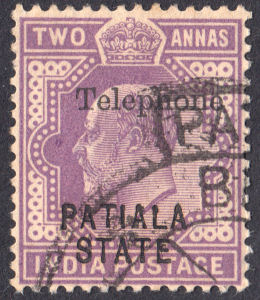 |
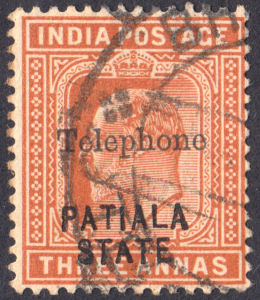 |
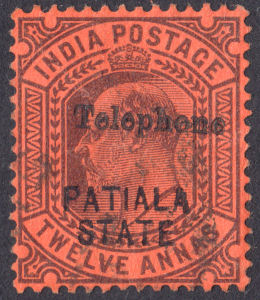 |
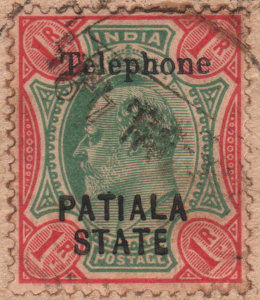 |
| RH6 | RH7 | *RH8 | RH9 courtesy Steven Zwillinger. |
* I added RH8 due to the example shown.
| RH # | Hisc. | Type | Description | Mint | Used |
|---|---|---|---|---|---|
| RH6 | H5 | 2 | 2A pale violet (SG39) | - | 7.50 |
| RH7 | H6 | 2 | 3A orange-brown (SG40) | - | 5.00 |
| RH7 | H6a | 2 | light brown | - | 5.00 |
| *RH8 | - | 2 | 12A purple/red (SG44) | - | 20.00 |
| RH9 | H7 | 2 | 1R green and carmine (SG45) | - | 25.00 |
On King George V postage stamps of 1912-26. Other details as above.
| RH # | Hisc. | Type | Description | Mint | Used |
|---|---|---|---|---|---|
| RH10 | H8 | 1 | ½A green (SG49) | - | 5.00 |
| RH11 | H9 | 1 | 1½A reddish brown (SG51) | - | 10.00 |
John Barefoot also lists a 6As in this series. This is listed by Hiscocks as H27.
On King George V postage stamps of 1928-34. Watermark W2.
'INDIA POSTAGE & REVENUE'
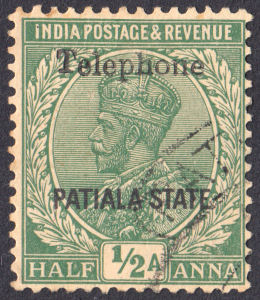 |
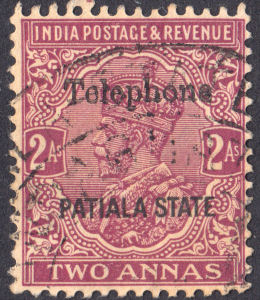 |
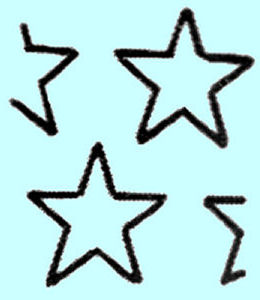 |
| RH12 | RH13 | W2 |
| RH # | Hisc. | Type | Description | Mint | Used |
|---|---|---|---|---|---|
| RH12 | H10 | 3 | ½A green (SG64)('Postage & Revenue') | - | 3.75 |
| RH13 | H11 | 3 | 2A purple (SG68) | - | 5.00 |
| RH14 | H12 | 3 | 2A 6P orange (SG69) | - | 10.00 |
| RH15 | H13 | 3 | 4A sage green (SG71)('Postage & Revenue') | - | 7.50 |
On King George V postage stamps of 1935-37. Other details as above.
'INDIA POSTAGE'
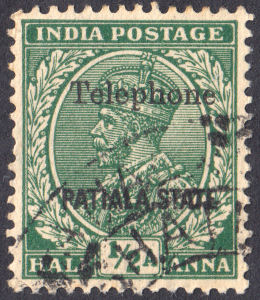 |
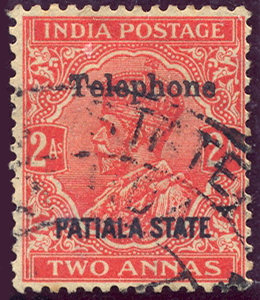 |
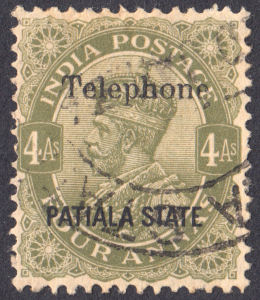 |
| RH16 | RH17 courtesy of Rolf Lamprecht. | RH18 |
| RH # | Hisc. | Type | Description | Mint | Used |
|---|---|---|---|---|---|
| RH16 | H14 | 4 | ½A bluish green (SG75)('Postage') | - | 3.75 |
| RH17 | H15 | 4 | 2A vermilion (SG77) | - | 5.00 |
| RH18 | H16 | 5 | 4A sage green (SG79)('Postage') | - | 5.00 |
On King George VI postage stamps of 1937-38. Other details as above.
( 'PATIALA STATE' )
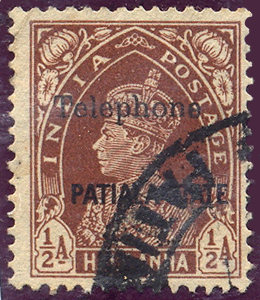 |
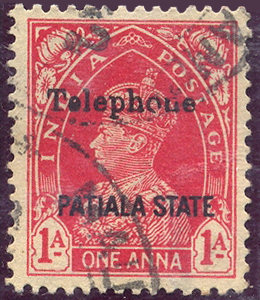 |
| RH19 courtesy of Rolf Lamprecht. | RH20 courtesy of Rolf Lamprecht. |
| RH # | Hisc. | Type | Description | Mint | Used |
|---|---|---|---|---|---|
| RH19 | H17 | 6 | ½A red-brown (SG81) | - | 10.00 |
| RH20 | H18 | 6 | 1A carmine (SG83) | - | 10.00 |
On King George VI postage stamps of 1943-47.
Type 7 is overprinted simply 'PATIALA'.
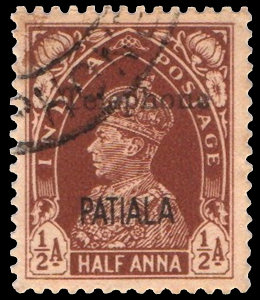 |
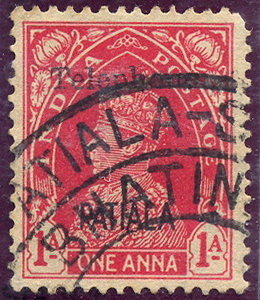 |
| RH21 | RH22 courtesy of Rolf Lamprecht. |
| RH # | Hisc. | Type | Description | Mint | Used |
|---|---|---|---|---|---|
| RH21 | H19 | 7 | ½A red-brown (SG99) | - | 10.00 |
| RH22 | H20 | 7 | 1A carmine (SG101) | - | 10.00 |
On King George VI postage stamps of 1943-47. Other details as above.
 |
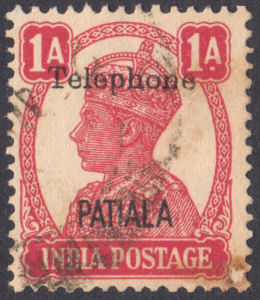 |
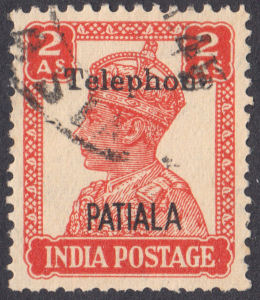 |
| RH23 | RH24 | RH25 |
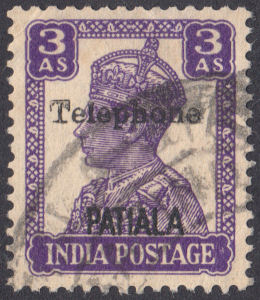 |
 |
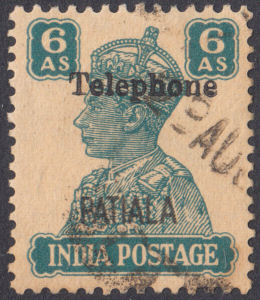 |
| RH26 | RH27 | RH28 |
| RH # | Hisc. | Type | Description | Mint | Used |
|---|---|---|---|---|---|
| RH23 | H21 | 8 | ½A purple (SG104) | - | 7.50 |
| RH24 | H22 | 8 | 1A carmine (SG106) | - | 7.50 |
| RH25 | H23 | 8 | 2A vermilion (SG109) | - | 7.50 |
| RH26 | H24 | 8 | 3A violet (SG110) | - | 10.00 |
| RH27 | H25 | 8 | 4A brown (SG112) | - | 10.00 |
| RH28 | H26 | 8 | 6A turquoise (SG113) | - | 10.00 |
Overprinted 'Telephone' as in type 16. On King George V postage stamp of 1912-26. As for Nos. 5-9.
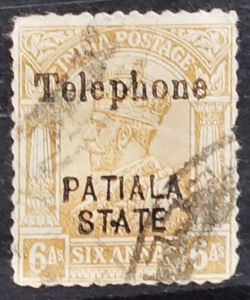
Image courtesy of Leo
(Leorevenue on ebay).
| RH # | Hisc. | Type | Description | Mint | Used |
|---|---|---|---|---|---|
| RH29 | H27 | (16) | 6A yellow-brown (SG55) | - | 15.00 |
Overprinted 'Telephone/Service' of type 9, etc.
On Queen Victoria postage stamps of 1891-96. As for Nos. 1-4.
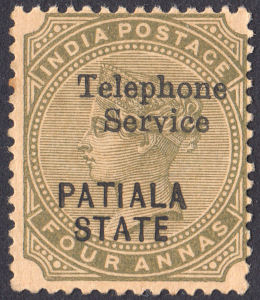 |
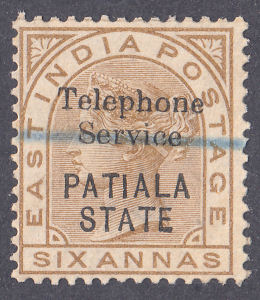 |
| RH30 | RH31 |
| RH # | Hisc. | Type | Description | Mint | Used |
|---|---|---|---|---|---|
| RH30 | H28 | 9 | 4A olive green (SG21) | - | 5.00 |
| RH30a | H28a | 9 | slate green (SG 22) | - | 5.00 |
| RH31 | H29 | 9 | 6A bistre (SG23) | - | 10.00 |
On King Edward VII postage stamps of 1903-06. As for Nos. 5-7.
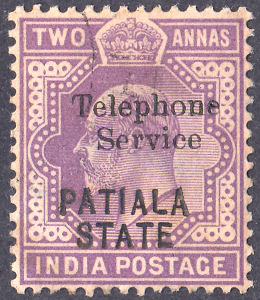 |
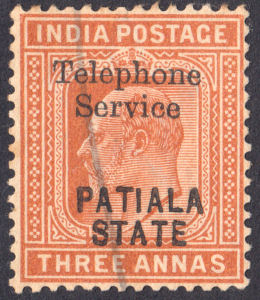 |
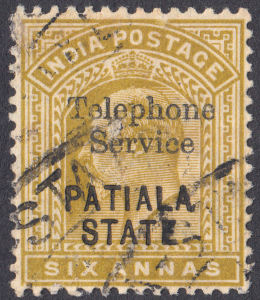 |
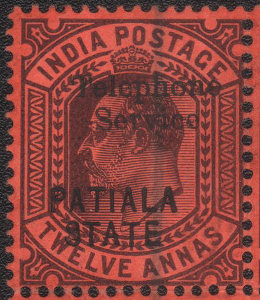 |
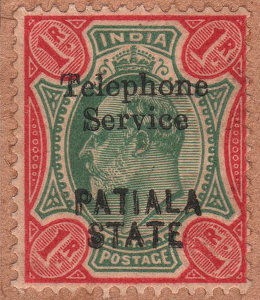 |
| #10, RH32 | #10, RH33 | #10, RH34 | #10, RH36 Courtesy of Steven Zwillinger |
#10, RH37 Courtesy of Steven Zwillinger |
| RH # | Hisc. | Type | Description | Mint | Used |
|---|---|---|---|---|---|
| RH32 | H30 | 10 | 2A pale violet (SG39) | - | 3.75 |
| RH33 | H31 | 10 | 3A orange-brown (SG40) | - | 5.00 |
| RH34 | H32 | 10 | 6A bistre (SG42) | - | 10.00 |
| RH35 | H33 | 10 | 8A mauve (SG43) | - | 15.00 |
| RH36 | H34 | 10 | 12A purple/red (SG44) | - | 20.00 |
| RH37 | - | 10 | 1R green & carmine (SG45) | - | 25.00 |
On King George V postage stamps of 1912-26. As for Nos. 8 and 9.
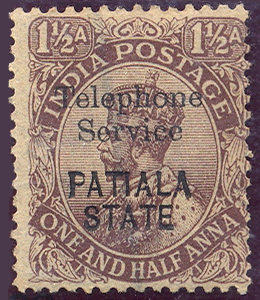 |
| #11, RH38 |
| RH # | Hisc. | Type | Description | Mint | Used |
|---|---|---|---|---|---|
| RH38 | H35 | 11 | 1½A reddish brown (SG51) | - | 7.50 |
| RH39 | H36 | 11 | 6A yellow-brown (SG55) | - | 15.00 |
On King George V postage stamps of 1928-34. As for Nos. 10-13.
'INDIA POSTAGE & REVENUE'
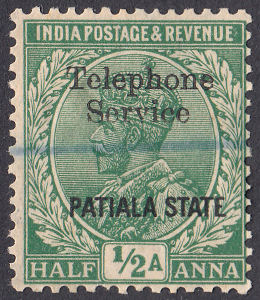 |
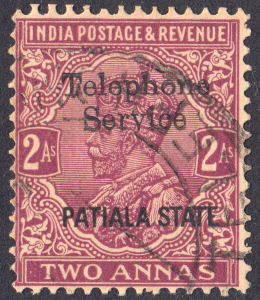 |
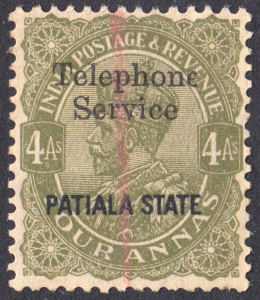 |
| #12, RH40 | #12, RH41 | #12, RH42 |
| RH # | Hisc. | Type | Description | Mint | Used |
|---|---|---|---|---|---|
| RH40 | H37 | 12 | ½A green (SG64) | - | 5.00 |
| RH41 | H38 | 12 | 2A purple (SG68) | - | 5.00 |
| RH42 | H39 | 12 | 4A sage green (SG71) | - | 5.00 |
On King George V postage stamps of 1935-37. As for Nos. 14-16.
'INDIA POSTAGE'
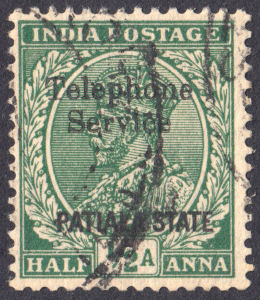 |
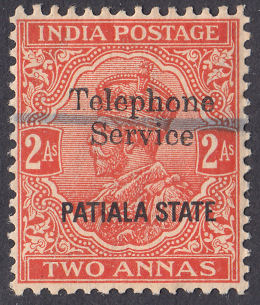 |
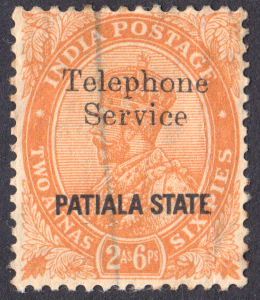 |
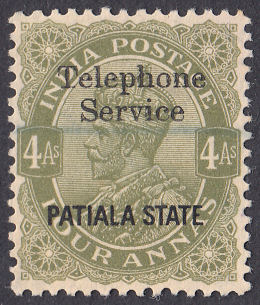 |
| #13, RH43 | #13, RH44 | #13, *RH45 | #13, RH46 |
* I added RH45 due to the example shown.
| RH # | Hisc. | Type | Description | Mint | Used |
|---|---|---|---|---|---|
| RH43 | H40 | 13 | ½A blue-green (SG75) | - | 5.00 |
| RH44 | H41 | 13 | 2A vermilion (SG77) | - | 7.50 |
| *RH45 | - | 13 | 2A 6P orange | - | 12.00 |
| RH46 | H42 | 13 | 4A sage green (SG79) | - | 5.00 |
On King George VI postage stamps of 1937-38. As for Nos. 17 and 18.
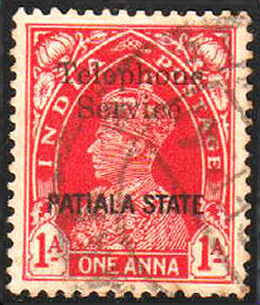 |
| #14, RH48 from Wiki Commons |
| RH # | Hisc. | Type | Description | Mint | Used |
|---|---|---|---|---|---|
| RH47 | H43 | 14 | ½A red-brown (SG81) | - | 10.00 |
| RH48 | H44 | 14 | 1A carmine (SG83) | - | 10.00 |
On King George VI postage stamps of 1943-47. As for Nos. 21-26.
 |
 |
 |
| #(8), RH49 | #(8), *RH49A | #(8), RH51 courtesy John Barefoot |
* I added RH49A due to the example shown. The 3As and 4As may also exist.
| RH # | Hisc. | Type | Description | Mint | Used |
|---|---|---|---|---|---|
| RH49 | H45 | (8) | ½A purple (SG104) | - | 10.00 |
| *RH49A | - | (8) | 1A carmine (SG106) | - | 10.00 |
| RH50 | H46 | (8) | 2A vermilion (SG109) | - | 10.00 |
| RH51 | H47 | (8) | 6A turquoise (SG113) | - | 10.00 |
Overprinted 'Service/Telephone' of type 15 (small type).
On King George V postage stamp of 1912-26. As for Nos. 8 and 9.
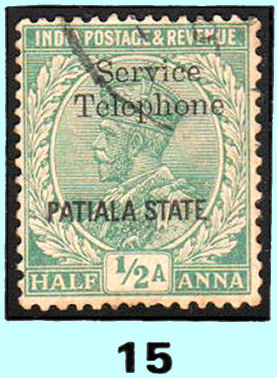
RH53 taken from Wiki Commons.
| RH # | Hisc. | Type | Description | Mint | Used |
|---|---|---|---|---|---|
| RH52 | H48 | 15 | 2A mauve (SG52) | - | 7.50 |
On King George V postage stamps of 1928-34. As for Nos. 10-13.
| RH # | Hisc. | Type | Description | Mint | Used |
|---|---|---|---|---|---|
| RH53 | H49 | 15 | ½A green (SG64) | - | 5.00 |
| RH54 | H50 | 15 | 2A purple (SG68) | - | 5.00 |
| RH55 | H51 | 15 | 4A sage green (SG71) | - | 5.00 |
Overprinted 'Service/Telephone' of type 16 (Larger).
On King George V postage stamp of 1912-26. As for Nos. 8 and 9.
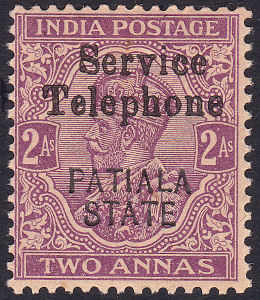 |
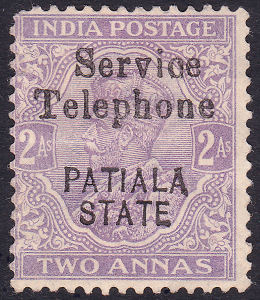 |
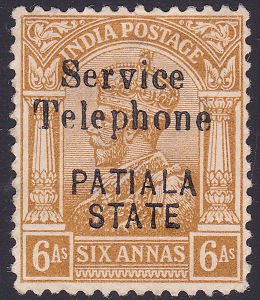 |
| Type 16, RH56 - The stamp on the right I think is genuine. The stamp on the left, has full yellowed gum, changing the apparent colour. I think the overprint is forged. The 'T' in 'TELEPHONE' slopes down on the left instead of the right and the serifs on the 'l' are more pronounced. |
Type 16, RH57 | |
These stamps should not be available mint, though they may have been used without cancelling.
| RH # | Hisc. | Type | Description | Mint | Used |
|---|---|---|---|---|---|
| RH56 | H52 | 16 | 2A mauve (SG52) | - | 10.00 |
| RH57 | H53 | 16 | 6A yellow-brown (SG55) | - | 10.00 |
On King George V postage stamps of 1928-34. As for Nos. 10-13.
| RH # | Hisc. | Type | Description | Mint | Used |
|---|---|---|---|---|---|
| RH58 | H54 | 16 | 2A purple (SG68) | - | 5.00 |
Overprinted 'Telephone' of type 1 on official postage stamps.
On King Edward VII official postage stamp of 1903-10. As for Nos. 5-7.
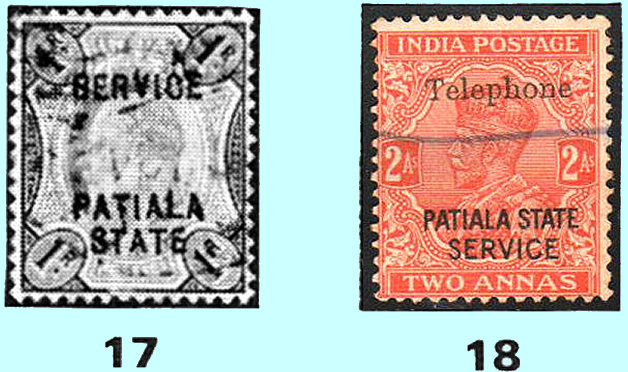
For the moment I am having to take most of this from page 177 of Hiscocks book.
Type 18 is from Wiki Commons.
| RH # | Hisc. | Type | Description | Mint | Used |
|---|---|---|---|---|---|
| RH59 | H55 | (17) | 1R green and carmine (SGO32) | - | 25.00 |
On King George V postage stamps of 1928-34. As for Nos. 10-13.
| RH # | Hisc. | Type | Description | Mint | Used |
|---|---|---|---|---|---|
| RH60 | H56 | 18 | 2A vermilion (SGO61) | - | 20.00 |
On King George VI official postage stamps of 1940-45. W2. Perf. 14.
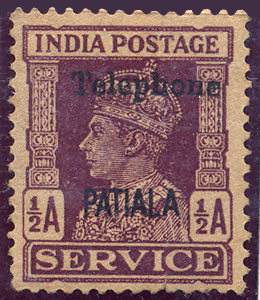 |
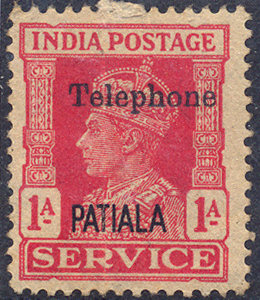 |
 |
| #19, RH61 courtesy of Rolf Lamprecht |
#19, RH62 courtesy of Rolf Lamprecht |
#19, RH63 |
| RH # | Hisc. | Type | Description | Mint | Used |
|---|---|---|---|---|---|
| RH61 | H57 | (19) | ½A red-brown (SGO72) | - | 15.00 |
| RH62 | H58 | (19) | 1A carmine (SGO75) | - | 15.00 |
| RH63 | H59 | (19) | 2A vermilion (SGO78) | - | 15.00 |
Hiscocks added the following note and illustration:
| Note. From the examination of those copies as have come my way it would seem that about 20% were not cancelled in any way in use, about 40% were cancelled by crayon — usually blue — and about 40% were cancelled with hand-stamps of various types. Specifically 'TELEPHONE' cancellations are found for several towns including Patiala and Bhatinda. That shown has no date, as is quite common, but even where the date tablet is filled in the date is often meaningless. |
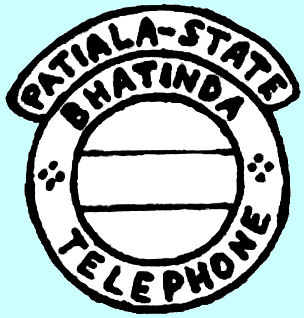
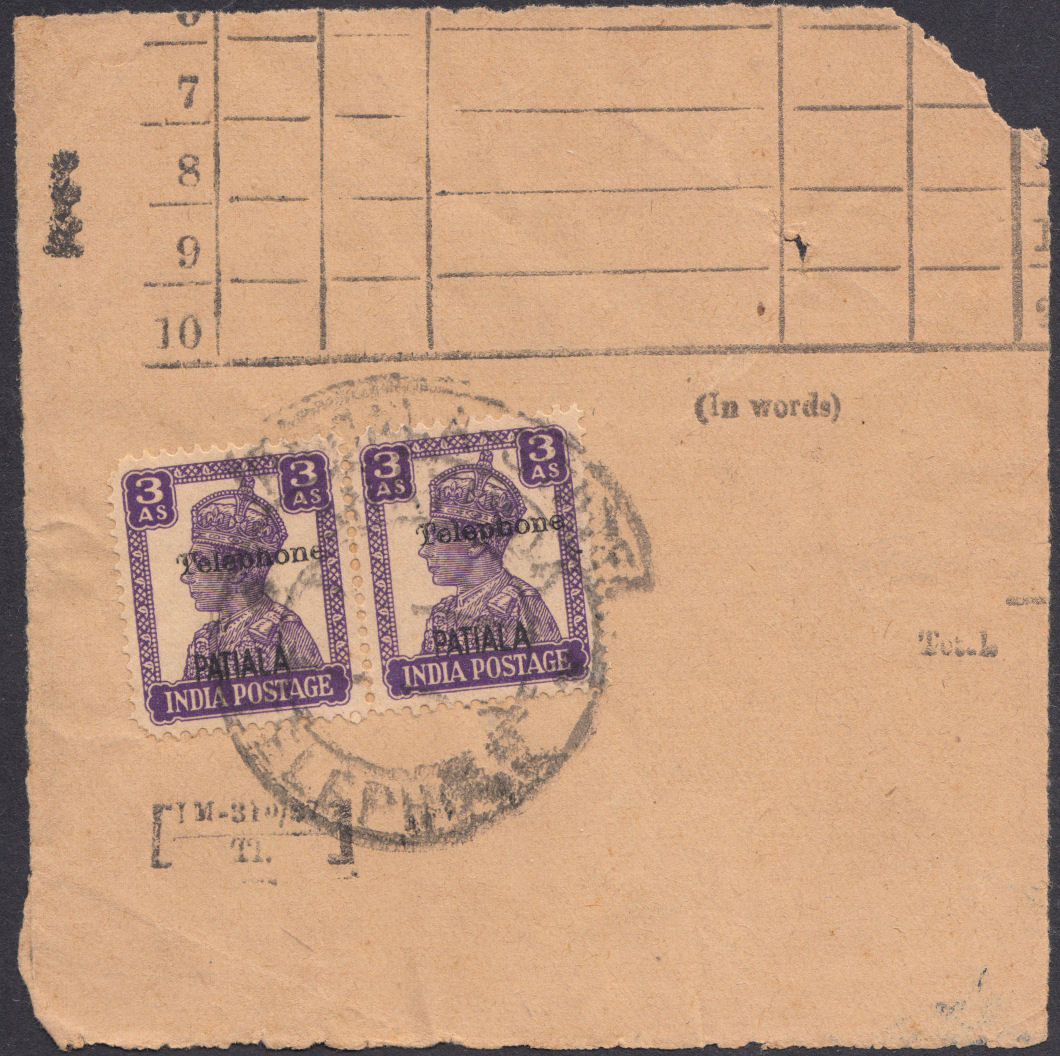
An example with a pair of H24 stamps and imprint.
Form B.S.P.P—No.65—28-6-05—32,000.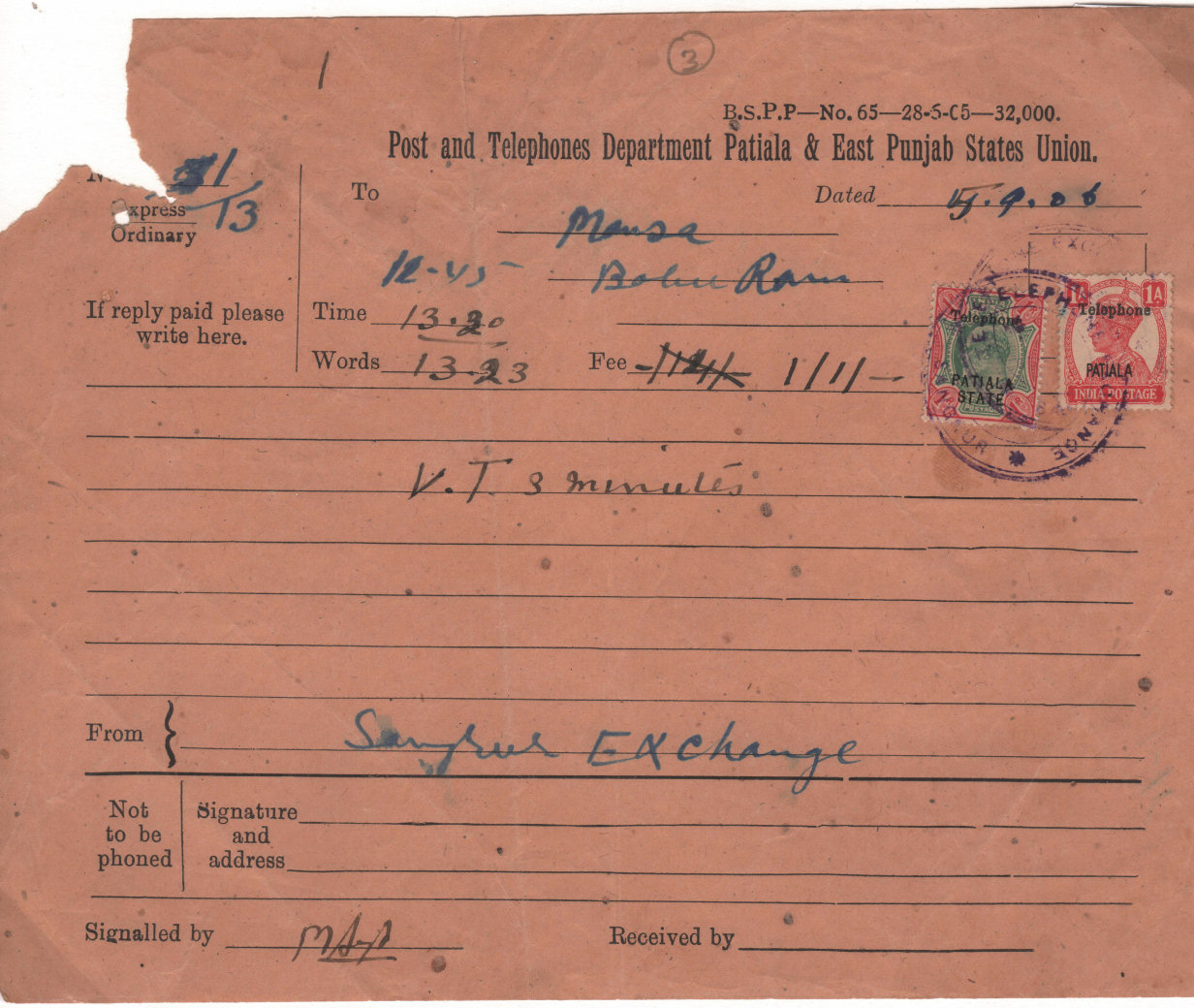
The Patiala system was later extended to the East Punjab. This half-size example for a 3 minute private call with a mix of Edward VII and George VI stamps,
was used at the Sangrur Telephone Exchange in Jind State. It is dated 5.9.06 which equates to 5 September 1949 using the local calendar.
It is headed "Post and Telephones Department Patiala & East Punjab States Union."
Image courtesy of Steven Zwillinger.
Official Forms were not always used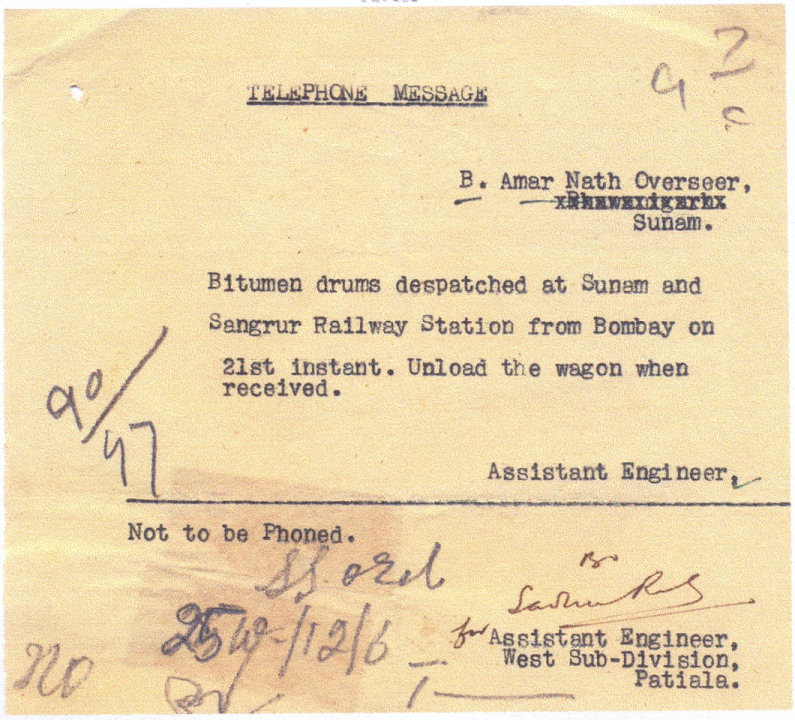
This was from Sunam in the Punjab, west of Patiala. Below the "Not to be Phoned" line was the cost calculation, 12As 6pies, and the recipient details.
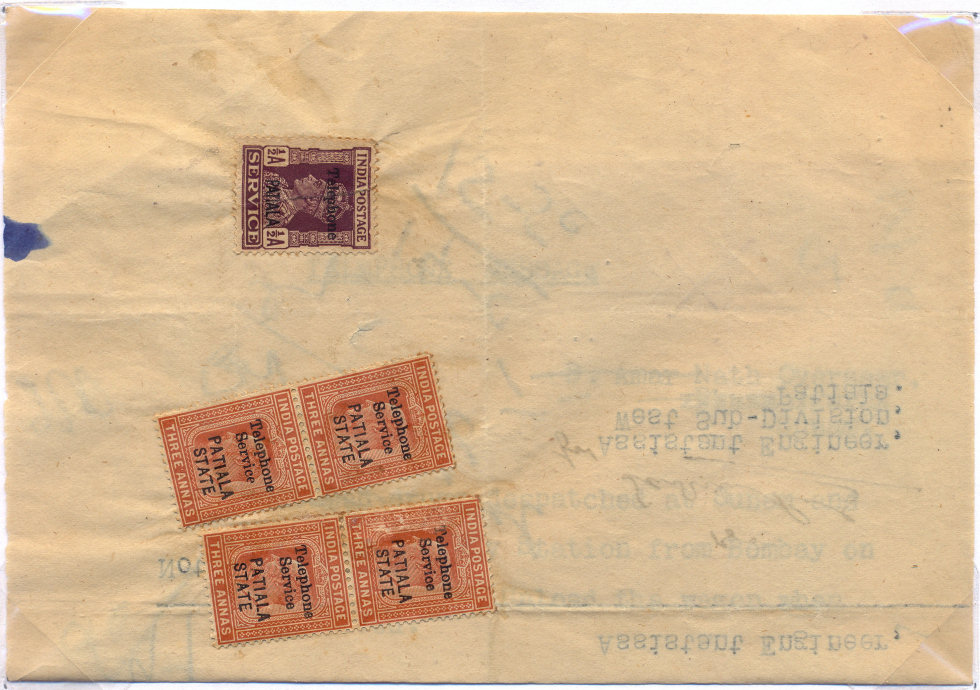
This was paid with a mix of un-cancelled Edward VII Service and George VI normal stamps, 25 words for 12As 6ps.
Image courtesy of Rolf Lamprecht.
I don't have an image of the other side, but this has no Service stamps.
This was used at Mansa, on the Bathinda-Jind-Delhi railway of then in Bhatinda of Patiala.
It has a mix of Edward and KGVI stamps and has the Western date of 30 November 1949.
It is on paper with part of an imprint :

This suggests a printing of 500,000 on 6 February 1948.
Image courtesy of Steven Zwillinger, who says "Fewer than 5% of telephone receipts known with Edward stamps".
Last updated 2nd. July 2024
©Copyright Steve Panting 2012/13/14/15/17/18/19/20/21/22/23/24 except where stated.
Permission is hereby granted to copy material for which the copyright is owned by myself, on condition that any data is not altered and this website is given credit.